September 30, 2018
Powerful Monodramas: Zender, Manoury and Schoenberg
The final scene of Strauss’s Salome almost touches the edges of this musical form; indeed, this scene is often performed outside its opera in concert so one might be persuaded this is where the twentieth century monodrama evolves into its own genre. Erwartung, Schoenberg’s epochal psychological musical drama from 1909, goes very much further than Strauss, however: It’s openly Expressionist, deeply psychoanalytical, ambiguous in its narrative, terrifying in its musical language and flickers between dream and nightmare.
The link between these two concerts given by the Philharmonia Orchestra was not in the slightest tenuous; indeed, a lot conjoined the music rather than distinctly separated it. Although almost a century of music exists between Erwartung and the two works by Zender and Manoury - written respectively in 2001 and 2004 - one was drawn back into the past - no matter how obliquely - even if the musical language often felt distinctly more advanced. Hans Zender’s Cabaret Voltaire, for example, uses a text by the Dadaesque poet Hugo Ball: The text itself is almost meaningless, a complete inversion of language, though as you listen to it occasionally you’re struck by its Germanic tone: “großgiga m’pfa habla horem”. There is a linguistic geometry to much of poetry; the entirely original vocabulary, the use of repetition, the combination of consonants or vowels in close proximity to one another (“bschigi bschigi” or “a-o-auma”) are themselves music. Hearing Zender’s Cabaret Voltaire was not unlike reading, or listening to, James Joyce’s Finnegan’s Wake.
Zender’s music, on the other hand, is distinctly ascetic, even spiky. Scored for a small chamber ensemble, this is music that coalesces around the consonantal hardness of the text; a cello or violin bow screeches or scratches against a string, a trombone is muted. The voice itself is treated in virtuosic terms - and it clearly requires a soloist calibrated to sing outside the standard operatic repertoire. Salome Kammer was simply breath-taking to listen to: The vocal acrobatics, the range and breadth of her dynamics, the sense that she has lived with this text were obvious. Only once in the entire work does Zender really plummet the depths of human emotions - in ‘Todenklage’ - and here the intensity and darkness of Kammer’s voice, as well as the soloists from the Philharmonia, really excelled in changing the atmosphere of the work.
I think Philippe Manoury’s Blackout is rather closer to Schoenberg’s Erwartung, both in its narrative and musical language. It tells the story of a woman who gets in a lift which then gets stuck during a power cut. As she waits in the darkness, her mind is forced into an emotional state of memory and dream. Manoury tells the story in real time over a period of twenty minutes - so, we get the rapid speed of the escalation of the lift contrasted with the slow-motion depiction of the narrator’s state of mind. Daniela Langer’s French text could be said to have its origins in Walter Grauman’s 1964 psychological thriller, Lady in a Cage, though the way she has written the text in prose-form suggests a nod towards the monodramas of Samuel Beckett.
Manoury writes for a slightly larger ensemble than Zender does but the expressionism is still there in spades. The febrile string writing, underscored by nervousness in the woodwind, dig deep into the psychological darkness of a mind in dream-mode. The music feels like elastic at times - it pulls between tempos that are fast and slow, and this is somewhat reflected in the narration of the text. A crackled recording of Ella Fitzgerald interjects. I don’t think this music requires the contralto Hilary Summers to use the full range of her quite remarkable voice, but she is never strained by the demands the music makes on her either. I found some of her French a little on the prosaic side, but she successfully navigated the internal psychology of the narrator’s mind to beautiful effect.
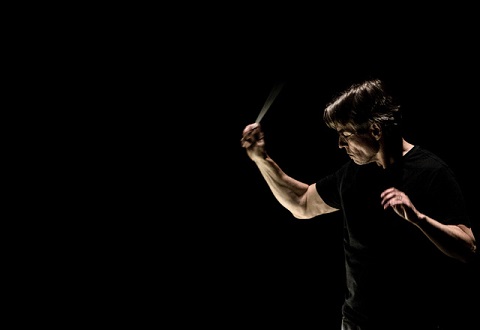 Esa-Pekka Salonen. Photo Credit: Minna Hatinen.
Esa-Pekka Salonen. Photo Credit: Minna Hatinen.
The Philharmonia Orchestra’s opening concert of their autumn season, conducted by Esa-Pekka Salonen, placed Schoenberg’s Erwartung in the middle of their programme. Schoenberg has always played to Salonen’s strengths, and so it did here. He treats this work as one of the great pillars of Modernism and there is much in his conducting of it that brings out the psychosis, lamentation and darkness of this monodrama. The fluidity he brings to the score, over its half-hour span, is quite remarkable - the contours of the music are almost unbroken, even if the trajectory of the narration never is. The changes in tempo and meter are so perfectly judged you almost feel as if this is a musical form of linguistic stream-of-consciousness. There is, however, one powerful impression one is left with in a Salonen performance of this work, and it’s a somewhat ironic one. Erwartung is a towering affirmation of Expressionism, but Salonen draws playing of incredible beauty from the Philharmonia Orchestra it seems to stand in opposition to the work’s more powerful emotive strands. I’ve rarely heard such refined woodwind playing as we got here - but this has long been a hallmark of this orchestra. It wasn’t necessarily out of place, but this came close to bordering on Romanticism.
It was left to the soloist - the outstanding Angela Denoke (replacing at short notice Camilla Nyland) - to raise this performance to the quite exceptional. Denoke brings despair, fear, madness and complete immersion into the psychological confusion the narrative demands. Her timbre resonates with darkness and ambiguity, but get to the upper range of her voice and the angst is shattering. One of the difficulties of a concert performance of this piece is it can sometimes lack the dramatic element it needs - Denoke, however, is consumed on stage in front of an orchestra using the colours of her voice to convey the moonlit streets, dense woodland or meadows and paths. The voice is entirely an expression of what Schoenberg termed his “Angst-dream”.
I’m not sure the rest of the Philharmonia’s concert was quite as memorable. “Siegfried’s Death and Funeral March” from Götterdämmerung, if notable for some superlative brass playing (especially a quartet of splendid Wagner tubas) avoided the pitfall of being overly lugubrious but sacrificed some of the music’s clarity of orchestration - I missed the transparency in the harps (pretty much inaudible), and the woodwind phrasing wasn’t plaintive enough, though I think much of this was due to the orchestral balance being somewhat overwrought. It did, nevertheless, feel cohesively dramatic. I think the best - and probably the worst - one can say about Salonen’s Bruckner Sixth Symphony was that it was utterly unique. If the opening of the first movement barely touched on Bruckner’s Majestoso tempo, Salonen’s intention was to take the rest of it at a sprightly allegro. Even if the playing was largely razor-sharp rhythms weren’t, and string bowing was notably messy. Oddly, the Adagio was taken in tempo and it was a highpoint of the performance (Tom Blomfield’s oboe solo being exquisite). The Scherzo achieved a neat symmetry of balance - with a fluid Trio section - but come the Finale the performance fell out of tempo again. The coda was undeniable exciting, but this was an extraordinarily mysterious Bruckner Sixth in almost every sense.
Marc Bridle
Hans Zender: Cabaret Voltaire for voice and ensemble (UK premiere) - Salome Kammer (vocal artist); Philippe Manoury: Blackout - Monodrama for contralto and ensemble (UK premiere) - Hilary Summers (contralto), Philharmonia Orchestra soloists, Pierre-André Valade (conductor)
Purcell Room, London; 27th September 2018.
Wagner, Schoenberg, Bruckner - Angela Denoka (soprano), Philharmonia Orchestra, Esa-Pekka Salonen (conductor)
Royal Festival Hall, London; 27th September 2018.
image=http://www.operatoday.com/Salome_Kammer_CHF8224_RGB-full%20%281%29.jpg image_description= product=yes product_title= product_by=A review by Marc Bridle product_id=Above: Salome KammerPhoto credit: Christoph Hellhake
ENO's Salome both intrigues and bewilders
It’s not surprising that a twenty-first-century opera director might want to find ways of re-imagining Salome which do not simply reproduce fin-de-siècle obsessions and neuroses. Adena Jacobs’s new production for English National Opera eschews the quivering sensuousness of Flaubert, Huysmans, Moreau, Beardsley, Wilde, Klimt et al - overlooking, in so doing, Richard Strauss’s own chromatic writhing and lurid orchestrations - and replaces their visual and literary lavishness with defiant feminist imagery. Barbies and Bronies both take a bashing, as this insolent teenager in black leather hot pants gives as good a gaze as she gets, wielding a phallic baton in brutal defiance and steely self-definition.
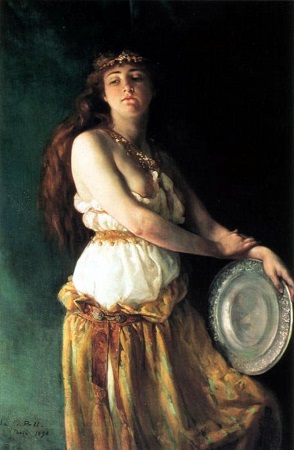 Ella Ferris Pell - Salome. Photo Credit: Catherine Ashmore.
Ella Ferris Pell - Salome. Photo Credit: Catherine Ashmore.
Jacobs isn’t the first to attempt, as Lawrence Kramer puts it, ‘to appropriate the Salome complex on Salome’s behalf’. [1] Kramer draws attention to a portrait of Salome which the American artist Ella Ferris Pell exhibited in 1890 and which Bram Dijkstra reproduces on the cover of his book Idols of Perversity, citing Dijkstra’s suggestion that, ‘Pell's Salome makes a revolutionary statement by being nothing but the realistic portrait of a young, strong, radiantly self-possessed woman who looks upon the world around her with confidence … [Such a woman] was far more threatening, far more a visual declaration of defiance against the canons of male dominance than any of the celebrated vampires and viragoes created by turn-of-the-century intellectuals could ever have been.’
Dijkstra’s words largely seem to sum up the intentions of Jacobs and designer Marg Horwell in their feminist commandeering of Strauss’s opera, though of course the twenty-first-century context supplies its own particular imagery. We begin in near-darkness, Stuart Jackson’s Narraboth yearningly proclaiming his obsessive love for the beautiful princess of Judaea, surrounded by a crowd of fellow-fans and Instagram-followers who, confined within a roped-off enclave, await the arrival of their idol. Above is suspended what at first seems to be a fish-tank, though grainy glimpses of the sinuous movements of a woman bathing gradually come into semi-focus.
At last, Salome herself becomes visible through the blackness. She watches herself being watched. Given what will follow, perhaps she should have learned a lesson from the long list of troubled, contemporary ‘celebrities’ who have found, with sometimes tragic consequences, that though playing with one’s public personae gives illusions of control, it’s not so easy to exorcise patriarchy and find one’s authentic self.
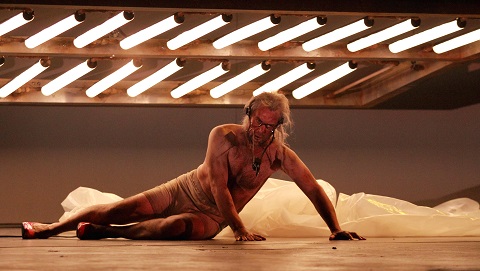 David Soar (Jokanaan). Photo Credit: Catherine Ashmore.
David Soar (Jokanaan). Photo Credit: Catherine Ashmore.
Indeed, out of the blackness, via a reverberant loud-speaker, come the stirring warnings of David Soar’s resonant and arresting Jokanaan. Allison Cook’s Salome is drawn like a fly to an electric zapper and descends to the Baptist’s den of incarceration. Only the feet of the filthy prisoner are visible, protruding from a grubby tarpaulin - presumably preventing the prophet from being fried alive by the fierce lights burning above him. His feet are crushed into shocking pink stilettos and his mouth, so feared by Herod, so fetishized by Salome, is magnified on the rear wall. When he staggers from beneath his protective sheet we see that a pin-hole camera is strapped to Jokanaan’s face - a sort of scold’s bridle - relaying projections of the potent orifice.
The portentous confrontation between redeemer and radical unfolds: as Salome luxuriates in her desires, Narraboth circles with a video camera - presumably for up-loading to YouTube - before killing himself. Slipping her feet into Jokanaan’s stilettos, Salome indulges in some necrophiliac writhing on the Syrian guard. She had unwound her clothing, to bare her flesh; now, Jokanaan unties the bandage on his wrist in order to shield his eyes from such debauchery.
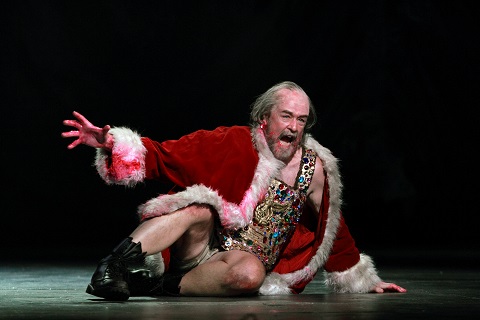 Michael Colvin (Herod). Photo Credit: Catherine Ashmore.
Michael Colvin (Herod). Photo Credit: Catherine Ashmore.
Leaving the prison to return to Herod’s ‘pleasure’ palace, we find the monarch frolicking with four nymphs in shiny nude leotards. Dressed in a be-jewelled wrestler’s suit, grubby boxer shorts and Santa coat, Michael Colvin is a ‘Mad King’ indeed. Desperate, debauched and deluded, he makes George III look a picture of mental and physical health. His ‘courtiers’ sit on the side-lines, aptly dressed in blue surgical gowns and gloves - they are going to have to do the clearing up, after all. Herod slithers in Narraboth’s blood; a rosy My Little Pony is decapitated, disembowelled and hoisted aloft, its mane hanging limply as its floral entrails spill across the stage. In the face of such dysfunctionality, the eloquent pleas of the Nazarenes (Robert Winslade Anderson and Adam Sullivan) are as impotent as the knock-kneed Herod. Herodias (Susan Bickley) wraps herself in a net-curtain which has been pulled down to reveal a blindfolded Saint Sebastian-cum-David Bowie.
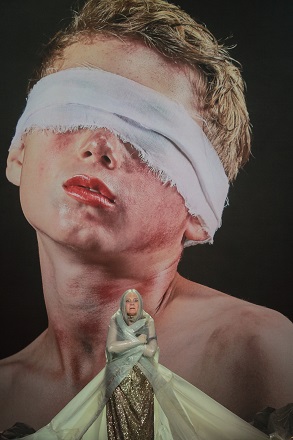 Susan Bickley (Herodias). Photo Credit: Catherine Ashmore.
Susan Bickley (Herodias). Photo Credit: Catherine Ashmore.
I confess that, by this point, I was suffering from an overload of the absurd. I hoped that some sense of ‘purpose’ or context would arise from the Dance of the Seven Veil’s and Salome’s final monologue: the still points at which Salome is the focus of our own voyeurism. Allison Cook is a terrific singing-actor and she has all the notes in her arsenal, if not quite the gloss that might outshine the instrumental excess.
But, her Salome doesn’t so much as dance as pose languidly and grasp a baseball bat, appropriating phallic authority. Having discarded her Barbie-doll candy-pink sweatshirt and whipped off her blond wig to reveal a power-haircut, she slides up the pony’s belly and revels in its ripe intestines. Four dancers - Essex-scrapes, black football shorts, sequinned head-dresses - jerk and twerk.
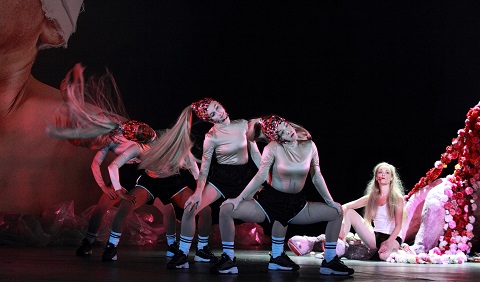 Ensemble dancers and Allison Cook (Salome). Photo Credit: Catherine Ashmore.
Ensemble dancers and Allison Cook (Salome). Photo Credit: Catherine Ashmore.
Jacobs believes that the dance is not a ‘true unveiling or an expression of the soul. It is a dance constructed for Herod’s gaze … On this night, Salome subverts the dance for her own gain, she uses it to radicalise herself’. It is not mystical, she declares, but ‘an escalation of her power, a ritualistic dance for the head of Jokanaan, an act of ritual preparation.’ Well, the notion that women can subvert the patriarchal, scopophiliac gaze is nothing new; even Flaubert suggested that Salome usurped power, that her movements evaded male determination: ‘With her eyes half-closed she twisted her body backwards and forwards, making her belly rise and her breasts quiver, while her face remained expressionless and her feet never stopped moving … From her arms, her feet, and her clothes there shot out invisible fire.’ But, what if there is no ‘movement’: can her dance still empower? Though conductor Martyn Brabbins drew radiant silk and riotous sleaze from the ENO Orchestra, I was unable to make sense of the schism that opened between visual image and musical motion.
Having turned all male heads, Salome then topples them. And, it is the severed head - in Wilde’s play, this is a magisterial and monstrous Medusa - that ultimately draws our gaze. But, Jacobs doesn’t give us a head, only a lumpen white plastic bag. This makes a nonsense of the text and psychology of the monologue - ‘If you had looked at me, you would have loved me’, she sings to the severed gore, desperate to command Jokanaan’s gaze.
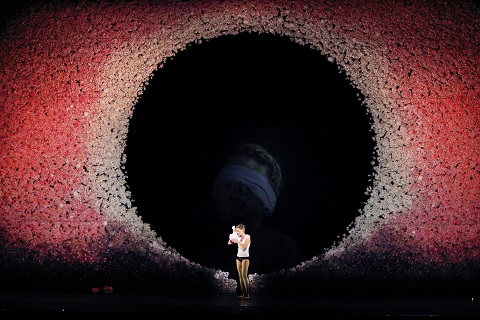 Allison Cook (Salome’s monologue). Photo Credit: Catherine Ashmore.
Allison Cook (Salome’s monologue). Photo Credit: Catherine Ashmore.
One thinks again of Pell’s portrait of Salome with its empty platter. Is this Jacobs’s design: if there is no head then our gaze remains fixed on Salome herself and thus the patriarchy does not re-exert its power? The director’s final image is equivocal: a flower-bordered black-hole, framing the bandage-eyed Bowie look-a-like; is this a mouth, a vulva, or what Elena Manafi (Senior Tutor/Programme Director PsychD In Psychotherapeutic and Counselling Psychology at the University of Surrey) describes in her programme article as ‘the abyss of the feminine’? Jacobs, it would appear, wants to turn Salome’s pathological narcissism into a ‘victory’, but her Salome is figuratively blinded by solipsism: and, spoiler alert, literally blinded by her mother’s hands which shroud her eyes from the truth that the lips she kisses are not Jokanaan’s - he’s still in the plastic bag - but Herodias’s own? Aren’t there enough Freudian threads in this tale already …
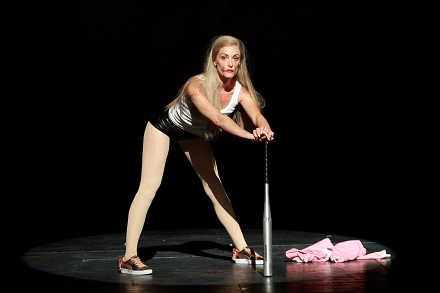 Allison Cook (Salome). Photo Credit: Catherine Ashmore.
Allison Cook (Salome). Photo Credit: Catherine Ashmore.
This Salome ends as the protagonist places a phallic gun in her mouth. Manafi argues that ‘Destruction becomes a form of liberation’, and that although Salome’s attempts to master and manipulate the male gaze have been ‘nothing but mimicry’ of patriarchal dynamics, her final act is an ‘outburst of violence that constitutes her emancipation’. But, Jacobs and Manafi seem to have forgotten that there is a theatrical audience: she becomes a prey to our gaze. As scholar Peter Conrad has observed, ‘Salome ceases to be a character and becomes an image, and opera turns simultaneously into a symphonic poem, into a ballet, and into a painting’. [2]
Jacobs allows for equivocation. But Angela Carter did just this nearly forty years ago, in the stories of The Bloody Chamber where the fantastical allows women to embrace their inner ‘darkness’: some critics argue that the female ‘victims’ of Carter’s fairy-tales become gradually empowered by embracing desire and passion as a human animal, others that Carter envisages women’s sensuality simply as a response to male arousal and that her tales can only reproduce patriarchal values rather than modify or shatter them.
Jacobs gives us arresting and intriguing visual images, but her Salome is smorgasbord of ideas and theories. Narraboth’s blood and the pony’s entrails are too slippery to tie the tableaux together.
Claire Seymour
Richard Strauss: Salome
Salome - Allison Cook, Jokanaan - David Soar, Herod - Michael Colvin, Herodias - Susan Bickley, Narraboth - Stuart Jackson, Nazarenes - Robert Winslade Anderson/Adam Sullivan, Herodias’s Page - Clare Presland, Soldiers - Simon Shibambu/Ronald Nairne, A Cappadocian - Trevor Eliot Bowes, Slave - Ceferina Penny, Jews - Daniel Norman/ Christopher Turner/Amar Muchhala/Alun Rhys-Jenkins/Jonathan Lemalu; Director - Adena Jacobs, Conductor - Martyn Brabbins, Designer - Marg Horwell, Lighting Designer - Lucy Carter, Choreographer - Melanie Lane, Orchestra of English National Opera.
English National Opera, Coliseum, London; Friday 28th September 2018.
[1]
Lawrence Kramer, ‘Culture and musical hermeneutics: The Salome
complex’, Cambridge Opera Journal Vol.2, No.3 (November 1990):
269—94
[2] Peter Conrad, Romantic Opera and Literary Form (Berkeley, 1981), p.154.
Photo credit: Catherine Ashmore
September 29, 2018
In the Company of Heaven: The Cardinall's Musick at Wigmore Hall
Palestrina’s musical devotions to Saints Peter and Paul opened with the composer’s six-voice motet, Tu es Petrus, and the parody mass which it inspired. With just a single voice to each part, Carwood generated a strong sense of forward movement and exploited the vibrant luminosity that Palestrina’s ‘antiphonal’ effects create, as the three higher voices alternate with the three lower strands in the opening phrases - an effect which reappears in the movements of the mass. There was a gradual blossoming as the music drove towards the confident statement, ‘Et tibi dabo claves regni caelorum’ (And I will give you the keys to the kingdom of heaven), but the mood remained buoyant and fresh. Though the six ‘solo’ voices cannot produce a rich sonorous blend such as might swell around a Baroque basilica during a liturgical ritual, bathing the congregation in an inspiring wash of resonant fullness, the differentiation of the individual lines, each sung with strong character, enabled Carwood to subtly highlight individual lines and phrases, which simultaneously injected muscularity into the evolving polyphony, with the brightness of the soprano and alto adding further ‘uplift’.
The movements of the Mass were interspersed with Gregorian chants for the Feast of Saints Peter and Paul - Introitus, Alleluia Tu es Petrus, Offertorium - Constitues eos and Communio Tu es Petrus - sung by tenor and countertenor voices from the rear of Wigmore Hall.
The Cardinall’s Musick deliver their repertory directly and without affectation, and the six voices invited an intimacy that is entirely appropriate for Wigmore Hall. But, I could not help reflecting that this music might not be similarly apt for the venue; it was not intended for ‘performance’ but for participation, in a spiritual sense, and would not have been delivered in a ‘static’ manner but rather during the ritual processions and acts of the liturgy, the sound moving through the architectural spaces with wondrous and elevating impact.
That said, The Cardinall’s Musick sang the Mass with assurance and some sense of the spiritual engagement it was designed to inspire. The interweaving of the even lines of the Kyrie resolved into the purity of a shining cadential ‘eleison’, the SSA group within the ensemble conveying heaven-aspiring lucidity. A light flowing bass line in the Gloria created relaxed momentum, though I felt that in this and other of the longer movements, greater variety of dynamics and colour would have communicated a stronger response to the text. Carwood demonstrated clear insight into the formal structure of the movements though, producing a measured sense of acceleration in anticipation of the ‘Cum Sancto Spiritu’. And, the same flexibility was evident and put to good effect in the Credo; the expansiveness achieved with the phrase ‘Et incarnatus est de Spiritu Sancto,/ Ex Maria virgine, et homo factus’ (And was incarnate by the Holy Ghost of the Virgin Mary, and was made man) was powerful. In the Sanctus and Benedictus, the tender unfolding conveyed peace and assurance, and again the strong but sweet bass line illuminated ‘Hosanna in excelsis’ from below, with the voices finding surprisingly translucence with the pronouncement of the blessing itself. With the Agnus Dei came a lowering of tessitura, suggesting the arrival of a point of rest, which was reassuringly achieved in the six-voice echo of the ‘Ite missa est’ (the Mass is ended).
More Palestrina followed the interval, with Saint Paul taking his turn to be venerated in the composer’s ‘Magnus sanctus Paulus’. Here, the power of the full eight-voice ensemble made itself felt in the decorative floridity of the appeal, ‘Qui te elegit, ut digni efficiamur gratia Dei’ (so that we may be worthy by the grace of God); when repeated in the concluding episode, the muscular counterpoint, driven from the bottom, truly conveyed a striving to be ‘worthy’.
Saints Mark, Bartholomew and Andrew were honoured in music by composers who are not such household names. Giovanni Bassano was employed in Venice as a wind player and became leader of the instrumental ensemble at San Marco Basilica. The rich homophony of the close of his ‘O rex gloriae’ a5 (published 1598) resolved into a lovely fluid Alleluia which wound its way expressively through the syllables. The four-part ‘Sanctus Bartholomaeus’ (published 1586) of Jacob Handl was followed by Thomas Crecquillon’s ‘Andreas Christus famulus’ (1546). Little is known of Crecquillon’s life, though he was associated with the chapel of the Emperor Charles V for ten or more years from 1540 and was sufficiently esteemed for a major retrospective of his motets to be published after his death (c.1557). Crecquillon’s eight-voice motet ‘Andreas Christi famulus’ was composed for the annual meeting of the Order of the Golden Fleece in 1546 and was for a time judged to be the work of Cristóbal de Morales. Here, as the contrapuntal glories extended the compass, the tuning was less consistently secure. Moreover, in this less familiar repertory, the singers were understandably more score-bound and sometimes lacking in animation.
Sacred music from Spain in honour of the Virgin Mary concluded the programme. Tomás Luis de Victoria’s ‘Vidi speciosam’ a6 (1572) was beautifully sung. The gently restful repetitions - ‘Flores rosarum et lilia convallium’ (She was surrounded by roses and lilies of the valley) - conjured the sweet fragrance of the Virgin who ascends from streams of water, as beautiful as a dove. Here, the singers captured the drama and spirituality of music, moving through the sublime harmonic progressions with an animation sometimes lacking elsewhere. Carwood sat at the side during the four-voice ‘Virgo prundetissima’ (1555) of Francisco Guerrero, a prolific composer who was born in Seville in 1528.
Sebastián de Vivanco (c.1551-1622) was born in Ãvila at roughly the same time as Victoria and has been rather overshadowed by the latter’s achievements and renown. However, with the full complement of voices reassembled, The Cardinall’s Musick showed us that, while less experimental than Victoria, Vivanco could craft imposing counterpoint. The ‘Magnificat octavi toni’ (published 1607) accumulated majesty through the evolving parts, building to a series of statements of comfort and certainty: ‘Quia fecit mihi magna qui potens est’ (For he that is might has done great things for me), ‘Suscepit Israel puerum suum:/Recordatus misericordiae’ (Concerning Israel, his child: he remembered his mercifulness). The blending of voices in the final Gloria Patri et Filio was reassuringly resonant and firm.
Despite my minor misgivings about the partnership of repertory and context, this was a beautifully sung programme - and a well-conceived one too, engagingly introduced and explained by Andrew Carwood. The Cardinall’s Musick will present another opportunity to enter the company of heaven in January next year , returning to Wigmore Hall to perform works focusing on Mary Magdalene and other saints.
Claire Seymour
In the Company of Heaven : The Cardinall’s Musick (Andrew Carwood, director)
Giovanni Pierluigi da Palestrina - Motet Tu es Petrus, Missa Tu es Petrus (interspersed with sections from Gregorian Chant Propers for the Feast of SS Peter and Paul), Magnus Sanctus Paulus a8; Giovanni Bassano - O Rex gloriae; Jacob Handl - Sanctus Bartholomeus; Thomas Crecquillon - Andreas Christi famulus; Tomás Luis da Victoria - Vidi speciosam; Francisco Guerrero - Virgo prudentissima; Sebastián de Vivanco - Magnificat octavi toni.
image=http://www.operatoday.com/The-Cardinall%E2%80%99s-Musick.jpg image_description= product=yes product_title=In the Company of Heaven: The Cardinall’s Musick (director, Andrew Carwood) at Wigmore Hall product_by=A review by Claire Seymour product_id= Above: The Cardinall’s MusickSeptember 28, 2018
Roberto Devereux in San Francisco
Donizetti traversed these sordid histories in 8 years (from 1830-1838). It took San Francisco Opera 13 years (Joan Sutherland as Maria Stuarda in 1971, Monserrat Caballé as Elizabeth I in 1978, and Joan Sutherland as Anna Bolena in 1984). Of course a couple of years ago the mighty Met managed to mount the whole bloody history in a few mere months.
This is opera history and Donizetti’s queens are opera history, rather history according to opera. There is no question which history is more real and true — crumbling parchment documents and a few words etched in stone from long ago or the delicate intimacies and huge tantrums that flew off the War Memorial stage last night at the final (of six) performances of Roberto Devereux. Donizetti’s bel canto miraculously achieved the Apollonian ideal — raw emotion absorbed into high art.
Soprano Sondra Radvanovsky portrayed history’s most terrifying queen in terrifying intricacies of voice, high d’s surreally emerging from nowhere to cap thrilling ascents of tortured lines, then other moments of descending lines, stepwise and sorrowfully slow. La Radvanovsky’s Elizabeth is terrifying, a persona of monumental presence, of absolute authority terrorised by love, a persona that is fully aware of her regal power, exuding the pleasure of executing astonishingly difficult vocalism, and surely of holding the 3000 spectators in the War Memorial in her thrall.
And a persona willing to fully suffer the torment of losing those she most loves, Roberto Devereux whom she blindly loves and the woman Devereux loves, her confident Sara.
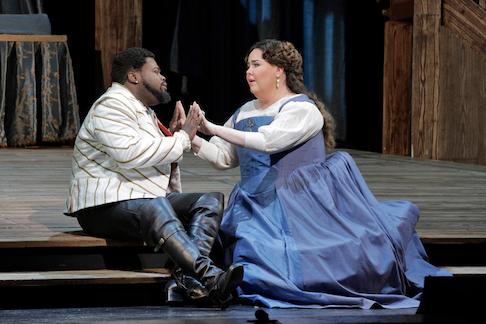 Russell Thomas as Devereux, Jamie Barton as Sara
Russell Thomas as Devereux, Jamie Barton as Sara
Elizabeth is hardly the only one to suffer. Sara’s husband, the Duke of Nottingham is Devereux’s best friend who must reconcile his love for and trust of his wife with his love and respect for his friend. Sara must reconcile her love for the queen with being her rival for Devereux’s love, and Devereux must reconcile his political and blatant personal betrayals of absolutely everyone with himself. So there is a lot to sing about.
And sing and suffer they do. After three hours of trying no one reconciled much of anything, to our very great pleasure. It was indeed an evening of bel canto! Italian conductor Riccardo Frizza established an unwavering dramatic pace that drove the betrayals and at the same time offered the protagonists all freedom to expand each moment of elation or despair and all gradations of joy and suffering in between. It was an all-too-rare conductorial achievement in parsing the emotional machinations of this difficult repertoire.
The voices of the protagonists were carefully matched. The all American cast was in prime vocal condition, and musical preparation was stylistically consistent. All voices were indeed beautiful, befitting the essence of bel canto. If the Radvanovsky sound is magisterial, mezzo-soprano Jamie Barton as Sara added the freshness of voice of a young woman in love. Tenor Russel Thomas as Roberto Devereux produces a limpid yet lush tenor sound throughout his full register, including its stratospheric tenorino reaches. In such company Adler Fellow Andrew Manea as the Duke of Nottingham strangely was not over parted. If his youth was obvious, his authority of presence, his command of style and use of his quite beautiful voice were formidable.
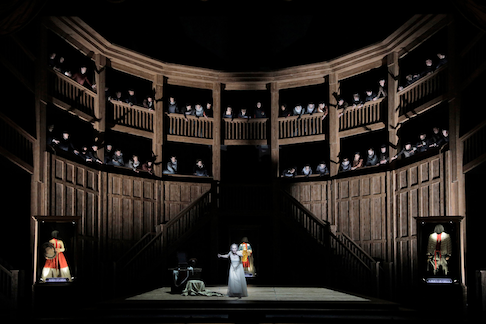 Sondra Radvanovsky as Elisabetta in final scene
Sondra Radvanovsky as Elisabetta in final scene
The well traveled production by British director Stephen Lawless belongs to Canadian Opera. Mr. Lawless took his cue from Donizetti’s quote of “God Save the Queen” in the overture to attempt to create levity, if not caricature of opera history. The surround was the galleries an Elizabethan theater indicating, I suppose, that we need not assume what we saw happen on the center stage acting platform was true or real, that it was, after all, only opera. There was a multitude of cute staging tricks that tried to keep us distanced from the distraught, often overwrought protagonists. They did not. We suffered.
That the production is not distinguished was of little importance to this evening. Mme. Radvanovsky grounded the production in high bel canto style that easily overcame all directorial conceits. This unique artist had the support of a well qualified cast. With Maestro Frizza we, right along with this distinguished cast, enjoyed a splendid evening of opera history.
Michael Milenski
Cast and production information:
Elisabetta: Sondra Radvanovsky; Roberto Devereux: Russell Thomas; Lord Cecil: Amitai Pati; Sir Walter Raleigh: Christian Pursell; Sara: Damie Barton; A page: Ben Brady; Duke of Nottingham: Andrew Manea; Nottingham’s servant: Igor Vieira. Chorus and Orchestra of San Francisco Opera. Conductor: Riccardo Frizza; Director: Stephen Laless; Set Designer: Benoit Dugardyn; Costume Designer: Ingeborg Bernerth; Lighting Designer: Christopher Akerlind. War Memorial Opera House, San Francisco, September 27, 2018
image=http://www.operatoday.com/Devereux_SF1.png
product=yes
product_title=Roberto Devereux San Francisco
product_by=A review by Michael Milenski
product_id=Above: Sondra Radvanovsky as Elisabetta I [All photos copyright Cory Weaver, courtesy of San Francisco Opera]
September 27, 2018
O18: Queens Tries Royally Hard
Subtitled as “The Ring Cycle of drag, tenors, and rock & roll, unfolding over three different nights,” I saw only the first, and was sated by the time Blythely After Hours came to a close with We Are the Champions sung in an Italian translation by Corrado Rovaris.
Starring one of the great operatic mezzos of our day, Stephanie Blythe uncompromisingly adapted the guise of star “tenor,” Blythely Oratonio. “He” begins the night singing upstage, back to us, intoning Pavarotti’s signature aria, Nessun dorma, in thundering chest tones, arms semaphoring, succeeding after a fashion, but somewhat hampered by initially tinny miking. (Daniel Perelstein’s sound design thereafter settled in to a good mix.)
When Mr. Oratonio finally turned to face us on the applause, “he” looked like Baba the Turk had wandered in from another opera. And it made me realize how much rather I would be hearing the mezzo in that or any other real opera role. Don’t get me wrong, Ms. Blythe, er um, I mean Mr. Blythely can sing the phone book with artistry and compelling delivery. And while she-as-he never slums stylistically essaying the copious pop material, neither does the performer ever quite consistently come into her own. For all her confident showmanship, the evening simply did not show off the magnificent richness of Stephanie Blythe’s potent instrument, with the insistent chest voice sharply pointed without turning over into her warm, womanly, not tenorly coloring.
To her great credit, the diva seems to be having a great time, one moment the complete esthete, another calculatedly vulgar, always engaged, ever energized to entertain us, and the vast majority of the audience was eating it up. Operatic tradition put-downs: big laugh. Singers’ ego disses: ha ha ha. Mezzo singing Vesti la giubba alternating with Send in the Clowns: how does she change gears like that?
Everyone did their level best to enliven and sustain the 90-minute goof. Rachel Camp (Bey) and Rob Tucker (Linda) were willing accomplices. A group of acolytes dubbed the Merepeople sang and cavorted gamely: Dane Allison, Messapotamia Lefae, Kathryn Raines, Bobby “Fabulous” Goodrich. Two of them chirped some agreeable interjected measures of the Flower Duet. Best of all, the vivacious guest star Brenda Rae wandered in to shuck her fur coat down to her bloody white Lucia gown, accompany herself on a Tori Amos song, and then sing counterpoint to Oratonio’s Faithfully with an operatically soaring The Winner Takes It All. A second guest appearance by Justin Vivian Bond was less assured, with a cue card having to be provided for her to get through her number.
Curiously for a festival that is top tier in every way, that sort of stumble occurred a couple times in the evening, with gentle prompts having to be provided to get things back on track. Indeed, the whole enterprise seemed to have the aura of a somewhat (intended?) slapdash, wee hours drag show. At the piano, the talented Daniel Kazemi provided excellent musical leadership and very satisfying arrangements. When he took off his suit jacket to reveal a leather vest and some toned biceps, the ripple through the audience told me exactly the hedonism and chicanery most were here for.
The inventive director John Jarboe mostly kept things moving at a good clip, and while the material he wrote (in tandem with the two stars) was a little loosey goosey, the pace at least was forward-looking, and he kept us from spending too long dwelling on one beat. Machine Dazzle’s costume and production was suitably Tacky Chic, and Drew Billiau lit the show with color and imagination.
Personally, in a slightly overlong evening of flimsy, jokey, pop material, I was hoping for more Blythe and less Blythely, more emphasis on her incomparable voice than her over-the-top assumed “persona.” That said, there are probably many satisfied customers who intend to come back to be similarly subjected to the second and third installments of the series: Fauréplay with Martha Graham Cracker, and Dito & Aeneas: Two Queens, One Night. As for me, Blythely After Hours was a good enough chuckle but I think for the moment I am queened out. . .
James Sohre
Queens of the Night, Blythely After Hours
Blythely Oratonio: Stephanie Blythe; Bey: Rachel Camp; Linda: Rob Tucker; Guest stars: Brenda Rae, Justin Vivian Bond; Merepeople: Dane Allison, Messapotamia Lefae, Kathryn Raines, Bobby “Fabulous” Goodrich; Writer/Director: John Jarboe; Music Direction/Arrangements: Daniel Kazemi; Costume/Production Design: Machine Dazzle; Lighting Design: Drew Billau; Sound Design: Daniel Perelstein
image=http://www.operatoday.com/Stephanie%20Blythe%20as%20Blythely%20Oratonio.jpg
image_description=
product=yes
product_title=Blythely After Hours: Opera Philadelphia
product_by=A review by James Sohre
product_id= Above: Stephanie Blythe as Blythely Oratonio
O18 Magical Mystery Tour: Glass Handel
How to even describe it without your thinking I am as bonkers as the mad Lucia I had seen at the festival earlier in the day? Let’s start in the venue, the long Annenberg Court that is the antechamber to the awesome Barnes Foundation art collection. (A gratis visit to the art was included in the evening.)
A small square stage platform is set in the center of the space, backed by two - count ‘em - two orchestras, a larger rectangular platform to the left, a raised platform with a large blank canvas to the right, beyond which are a bank of monitor screens. Chairs are placed around the space, set within a grid defined by blue lines. Rows of curious-looking, multi-colored dollies are parked at the ready. What could this wide-ranging spread possibly add up to?
Well, quite a lot as it turns out. Star counter-tenor Anthony Roth Costanzo, Visionaire, and Cath Brittan have conspired to present an artistic “happening” where singing, dance, fine art, and video are presented simultaneously to saturate the senses and create a one of a kind, on the spot experience. The 60-minute communal performance is anchored by the substantial interpretive gifts of Mr. Costanzo, and he sings magnificently, unstintingly, soulfully, and with unerring distinction of style alternating between Handel and Glass arias.
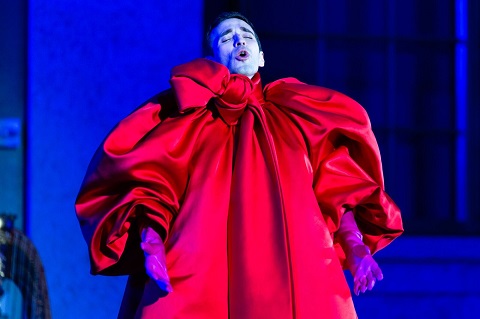 Anthony Roth Costanzo in Glass Handel, costumed by Raf Simons for Calvin Klein. Photo Credit: Dominic M. Mercier.
Anthony Roth Costanzo in Glass Handel, costumed by Raf Simons for Calvin Klein. Photo Credit: Dominic M. Mercier.
Anthony’s pure, pointed vocalizing has gained a bit in vocal heft since last I heard him, without losing any of the haunting, spiritual quality that informs his entrancing tone. He is an uncommonly expressive interpreter, not so much singing the vocal lines as embodying them. His participation is not only seminal to the project, it rightly dominates and inspires it.
For the audacious concept is this: Three gifted dancers will simultaneously perform, and a renowned painter will create a work of art in immediate “reaction” or “interpretation” as the arias are being presented. Dance world’s lithe and athletic luminaries Patricia Delgado, David Hallberg, and Ricky Ubeda take turns cavorting tirelessly with practiced abandon on the second stage, nimbly executing Tony-winning Justin Peck’s evocative, impromptu-seeming choreography.
Artist George Condo enters during the opening Grand Parade of performers and supers to take his place behind the large framed canvas at the other stage. Back lit like a shadow box, Mr. Condo spends the hour in silhouette painting a huge, abstract, cubist-inspired sketch that eventually filled the space and seemed at times like a magical, highly refined Etch-a-Sketch. Further afield past this canvas, video monitors screened installations, especially created for the event.
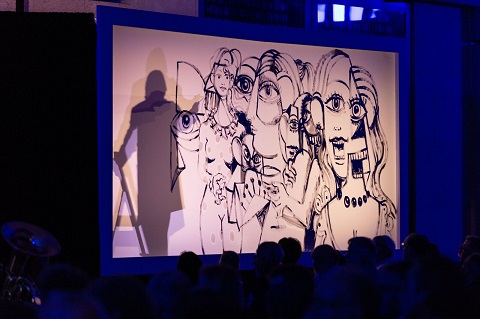 George Condo paints live at Glass Handel. Photo Credit: Dominic M. Mercier.
George Condo paints live at Glass Handel. Photo Credit: Dominic M. Mercier.
But wait, there’s more. Last year’s festival featured a premier of the opera We Shall Not Be Moved. In a reversal, the mantra of Glass Handel was that we SHALL be moved. Literally, and it happily turns out figuratively. For you see, fresh-scrubbed, attractive young supers manned those special dollies, and methodically moved audience members between the three staging locations. From the downbeat, a people shifter would put the dolly in place, put a hand on the shoulder to signal the intent to move the chair, tilt back and wheel the chair to a different vantage point. This was repeated with audience members in sequence.
I began directly in front of the singer, then went to the dance area, then finished in the painting area. While each had a different dynamic, all the while I was able to still enjoy the other concurrent elements. The hypnotic parade of spectators was itself a calculated element in the “performance art” nature of the project. As the music surged in the climactic aria, as the final touches and tweaks were daubed on the painting, and as the trio of dancers finally all assembled as one, the resettled audience had taken a mightily impressive “journey.” Although each element was exciting, it has to be said the real energizing presence of the evening was the towering, generous, inspiring contribution from Mr. Costanzo, first among equals.
There was so much to take in, we almost took for granted the two separate instrumental groups, one superbly essaying the Baroque glories of Mr. Handel, and the other restlessly, luminously liming the harmonies and pulsing rhythms of Mr. Glass. All this flash and dazzle would not have been possible without the dynamic and stylistically adroit conducting by Maestro Corrado Rovaris.
The technical elements were of necessity simple but competent, with Brandon Stirling Baker’s even lighting design solving many if not all of the challenges in lighting that space. Anthony’s costumes were over-the-top creations, starting with a red satin bell-shaped robe, with enormous puff sleeves that tied at the neck with an enormous billowing bow, contrasted with purple gloves. He eventually peeled that off to reveal a blue satin ball gown/shift emblazoned with Glass Handel, ending in a sort of androgynous white nightgown covered with Condo-like squiggles.
Did I mention it was revealed that the counter-tenor was prankishly wearing red satin high heels with rhinestone stripes under all that? The dancers were provocatively clad in the briefest of red briefs, with irregular rows of long red, silver, and black fringe creating cascades of visual movement. Completing the production “look,” the supers sported red tops and black slacks, while the black clad orchestra was accessorized with draped, wide red lanyards around their necks. This scintillating costume plot was created by Calvin Klein Chief Creative Officer Raf Simons. Kudos as well to stage manager Betsy Ayer who kept things flowing seamlessly.
I commend all concerned for taking this enormous leap of faith, this mighty artistic risk. There is much about this that portended that it shouldn’t work, but it did, and brilliantly, a stunning evening. The performers and creators were lavished with cheering ovations that called them back again and again. I am cheering them still: Bravi tutti!
James Sohre
Glass Handel
Music of George Frideric Handel
And Philip Glass
Countertenor: Anthony Roth Constanzo; Dancers: Patricia Delgado, David Hallberg’ Ricky Ubeda; Painter: George Condo; Conductor: Corrado Rovaris; Production: Anthony Roth Constanzo, Visionaire, Cath Brittan; Costume Design: Calvin Klein, designed by Chief Creative Officer Raf Simons; Choreography: Justin Peck; Videos: James Ivory and Pix Talarico, Mark Romanek, Tilda Swinton and Sandra Kapp, Tianzhou Chen, Daniel Askill, Maurizio Cattelan and Pierpaolo Ferrari, Rupert Sanders, AES+F, Mickalene Thomas; Lighting Designer: Brandon Stirling Baker; Production Format: Ryan McNamara; Video Consultant: Adam Larsen; Stage Manager Betsy Ayer; Rehearsal Director: Miguel A. Castillo
image=http://www.operatoday.com/Ricky%20Ubeda.jpg
image_description=
product=yes
product_title=Glass Handel: Opera Philadelphia
product_by=A review by James Sohre
product_id=Above: Ricky Ubeda
Photo credit: Dominic M. Mercier
September 26, 2018
Magic Lantern Tales: darkness, disorientation and delight from Cheryl Frances-Hoad
In 1668, the English scientist Robert Hooke published an article in Philosophical Transactions of the Royal Society of London, in which he described the projection of transparent and opaque objects, illuminated by sunlight or candle. Two years earlier, and two weeks before the Fire of London, Samuel Pepys had purchased a lantern from the London optician John Reeves recording in his diary, “Comes by agreement Mr Reeves, bringing me a lanthorn, with pictures on glass, to make strange things appear on a wall, very pretty”. Camera obscuras, magic mirrors, Laterna Magica, Phantasmagoria; for millennia, people have been enchanting, terrifying and transfixing each other with projected lights and shadows, shapes and colours, spinning tales of wonder and terror.
Cheryl Frances-Hoad’s forthcoming new recording, Magic Lantern Tales, similarly presents us a veritable son et lumière of musical light, colour, shapes and sounds. The cycle which gives the disc its title presents five poems from Ian McMillan’s collection Magic Lantern Tales (2014), written in response to interviews and documentary photographs by Ian Beesley. In 1994, Beesley was appointed artist-in-residence at the Moor Psychiatric Hospital in Lancaster, working on the unit specifically for the care of the extreme elderly, many of whom had been in the Moor for decades. H discovered a collection of old photographs in a chest of drawers, many of which were related to the First World War - soldiers in uniform, family gatherings, and weddings with the grooms in uniform - which had belonged to patients who had died in the hospital and who had no living relatives. Beesley describes these fading photographs as ‘a visual eulogy to forgotten lives’; they prompted him “to photograph and interview as many men and women who had experienced the First World War before it was too late”.
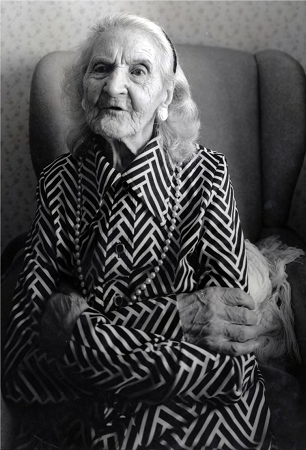 Lily Maynard. Photo Credit: Ian Beesley.
Lily Maynard. Photo Credit: Ian Beesley.
He and McMillan subsequently created a magic lantern show to present these personal narratives of the War by those who survived it. Now, Frances-Hoad has given musical expression to the stories of Lily Maynard (101), who told Beesley of her grief for her beloved, “We were thinking of getting married, when he went off to France , the Somme”; Harry Holmes (100), who was decorated for his bravery at Ypres when, whilst trying to retrieve wounded colleagues from no-man’s-land, he single-handedly captured five German soldiers; and Mabel Walsh (104), whose fiancé was killed in 1918 when struck in the head by a small piece of shrapnel, and who, like Lily, never married.
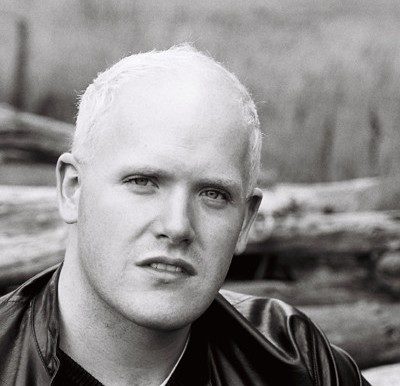 Nicky Spence. Photo Credit: Mardo Studio.
Nicky Spence. Photo Credit: Mardo Studio.
Frances-Hoad frames their memories with McMillan’s ‘Marching Through Time’, and so the cycle opens with a quiet but purposeful tolling, as pianist Sholto Kynoch summons Nicky Spence’s folk-tinged preface to the subsequent unfolding of the past, drawing the voice back to its anchor just as dissonant second and ninths reveal the narrator’s wish for release. Just over three minutes long, this is a marvellously crafted song which, through the expanding bare fifths and octaves in the accompaniment, the rhythmic and resonant intimation of military echoes, and the tense heightening of the vocal line, travels widely through time, place and emotions. The ascending line, “Stories rebuild just what wartime destroys”, spills intensely into a densely accompanied proclamation: “And a photograph is a kind of map.” Spence’s unaccompanied voice bursts with the anguished weight of memory, “That story lifting up the tentflap of history”. There is a subtle chromatic alteration in the repeated final line, “Stories as brittle as glass”, to which Spence adds timbral nuance, which is both beautiful and anguished. Such precise musical insight into the relationship between sound, sense and sensibility is characteristic of Frances-Hoad’s writing in all of the compositions recorded on this disc, and the results are deeply affecting.
The piano introduction to ‘Lily Maynard’ swings with a lovely lop-sided lilt, which is complemented by Spence’s warm, affectionate tone in the refrain, “Come on Lily, Let’s go walking”, and as the song and journey into memory proceed, so the enrichening of the piano’s harmony expresses first a sensuous passion, “Heating up the air something magical”, and then a pained portentousness, “And you pictured him in a trench/ Cowering and crying like a baby.” Spence’s repetitions of Lily’s name somehow seems both encouraging and tormenting, but the softness of the tenor’s head voice in the final refrain, “We’ll talk as we’re walking/ And pretend you’re young again,/ Lily”, follows Kynoch’s star-bound accompaniment into the air and we too are borne aloft on Lily’s dreams and memories.
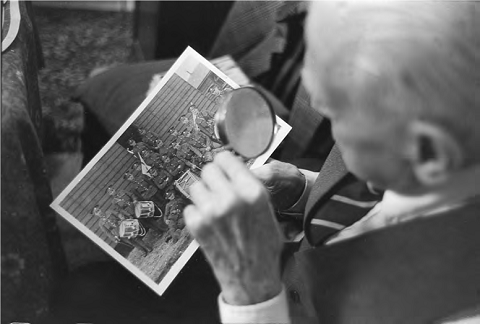 Harry Holmes. Photo Credit: Ian Beesley.
Harry Holmes. Photo Credit: Ian Beesley.
‘The Ballad of Harry Holmes’, like ‘Lily Maynard’, evokes a war-time song, but now wistfulness is replaced by chirpy resilience, as Spence’s narrator launches with rollicking gusto into this tale of brave Harry who meets bombs, barbed wire and a bonfire-sky with the pragmatic refrain: “All O want when I get through this,/Is a stroll, and a pint, and a kiss.” The rattling spikiness and quirkiness of the piano’s ringing tattoo - which reappears in various guises through the tale - brings Britten to mind, as does the text-setting. Spence’s expansive, galloping laudation, “I guess Harry was a hero”, is halted by the half-spoken whisper, “don’t take me…”, uttered in the “stinking night” to the dark terror. Frances-Hoad whips us through an extraordinary panoply of fluctuation moods and emotions. A cockney voice yelps with joy, “Harry, it’s over!”; the perennial bird-song stills the bombs; Harry’s chest puffs with pride on his home streets of Bradford; Harry-the-decorator dismisses his Military Cross in Yorkshire brogue, “a medal’s just a gaudy lump of tin”; he and Harry Ramsden of chip-shop fame hatch plots to frequent the Crown Inn when Harry R’s wife objects to his ale glugging. Frances-Hoad paints vivid pictures of Harry’s life and at the close, when Spence reflects, “Now Harry’s tale has been told”, we feel that we’ve travelled with him through his adventures and that we know him well, and love him.
The rhythmic ambiguities of the destabilising piano ‘clock-ticking’ in ‘Mabel Walsh’ suggest the centenarian’s straddling and merging of past and present. The effect is heightened by the piano’s gentle inter-verse ringing, a motif which is drily reiterated at the close as we hear “the hourly chimes/ Struck silent by that bastard war”.
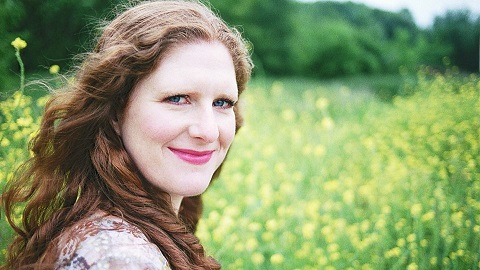 Cheryl Frances-Hoad.
Cheryl Frances-Hoad.
There is more magic and memory, as well as strong characters and strange places, in the other substantial ‘cycle’ included on the disc: The Thought Machine, ten settings of poems from Kate Wakeling’s children’s collection, Moon Juice (2016), which was commissioned by the Oxford Lieder Festival. Frances-Hoad’s delight in the whimsical and wry is ever-present in these songs, as is her feeling for the sophistication of a child’s perspective and assimilation of the ‘weirdness of the world’. We are sucked into an echoing cosmic vastness by the piano’s low shudderings and high tremors in ‘Telescope’, and by the slow intertwining, intoning and swooping of the two vocal lines, expertly pitched and co-ordinated by Sophie Daneman and baritone Mark Stone. We glide along the “dizzy black” motorway in ‘Night Journey’, Kynoch’s accompaniment a swirling kaleidoscope of colours and lights that form fantastic shapes in Daneman’s imagination. The singers bring Skig the Warrior and Rita the Pirate to vibrant life - the former more coward than combatant, the latter a swashbuckling gold-grabber who pinches your money with panache, to the tune of a Paganini caprice. The Hamster Man runs round and round his wheel in a wild fury; The light-fingered Thief is cheekily brazen - he even filches the last word of the song. Daneman gleams and teases with mystery in ‘Moon’, with the singers race impressively through the tongue-twisting text of ‘Comet’. After we’ve been pounded, spun and ‘shaken’ in ‘Machine’, bell-chimes send us in search of the ‘Shadow Boy’ as Stone and Daneman smoothly and assuredly traverse the wide-spanning vocal lines, reaching higher and higher as the tentative child tries his hardest to brave the dark.
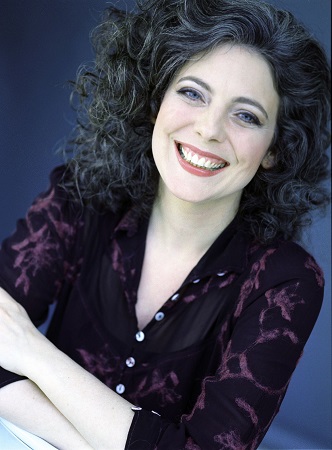 Sophie Daneman. Photo Credit: Sandra Lousada.
Sophie Daneman. Photo Credit: Sandra Lousada.
There are childhood experiences of a different kind in ‘Scenes from Autistic Bedtime’ which have their origins in a workshop for a projected chamber opera. The text was written by Stuart Murray, Professor of Comparative Literature at the University of Leeds and author of Representing Autism (2008), and the three scenes share the opening line, “It is shower time. It is bedtime”, as well as a continuous, shape-shifting piano accompaniment of splashes, splutterings and stutterings, played by Alisdair Hogarth. Treble Edward Nieland sings the child’s short phrases with a directness and clarity that is at first at little unnerving against the unstable piano accompaniment, but we hear too his mother’s voice (Natalie Raybould), by turns anxious then weary, relieved then resigned, but always loving. And, in the second scene she joins her child’s shower-song, in which the soaring voices, warmly lyrical cello (Anna Menzies) and glorious vibraphone chiming (Beth Higham-Edwards) grow into a glowing, intense expression of creativity, joy and laughter. There is darkness and confusion, even the threat of violence, in the third section, but if these scenes are disorientating at times, they are also uplifting and communicate with a striking strength that is both emotive and visceral.
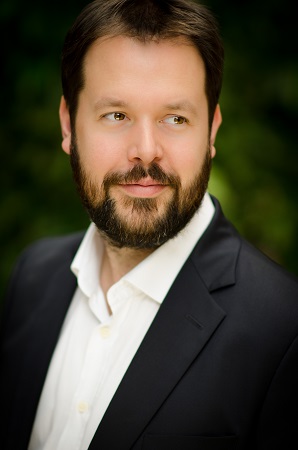 Sholto Kynoch. Photo Credit: Raphaelle Photography.
Sholto Kynoch. Photo Credit: Raphaelle Photography.
Frances-Hoad also conjures ‘alternative perspectives’ in Love Bytes: A Virtual Romance, in which ‘he’ (the cello) and ‘she’ (the vibraphone) articulate and enhance the strange conversation between two cyber-lovers, baritone Philip Smith and soprano Verity Wingate, who wonder just who exactly is on the end of the digital ‘line’. Frances-Hoad treads the fine line between a Walton-esque flippancy and the fragility of human connection and alienation; and, there is both wit and poignancy in their concluding reflection, “Perhaps it’s best/ We never meet at all”. Lament, an affecting setting of a text by Sir Andrew Motion, is sung with vivid emotional presence by mezzo-soprano Anna Huntley, accompanied by Hogarth. Hogarth also performs Invoke Now the Angels, conceived as a response to Britten’s Canticles I and II, which brings Wingate together with mezzo-soprano Sinéad O’Kelly and countertenor Collin Shay. This trio sing the a cappella A Song Incomplete, which sets text by Aristotle; Kynoch performs two short piano works, Star Falling and Blurry Bagatelle.
The works on this disc are varied in tone, context and form, but they are also consistent in the very visceral effects that they have upon the listener. Frances-Hoad’s Magic Lantern Tales disorientate and delight in equal measure.
Magic Lantern Tales is released on the Champs Hill label in November 2018.
Claire Seymour
image=http://www.operatoday.com/Magic%20Lantern%20slide%20circa%201900s.png image_description= product=yes product_title=Magic Lantern Tales: a new recording by Cheryl Frances-Hoad (Champs Hill, CHRCD146) product_by=A review by Claire Seymour product_id= Above: Magic Lantern slide c.1900A lunchtime feast of English song: Lucy Crowe and Joseph Middleton at Wigmore Hall
Where else to start but with Henry Purcell, as realised by Benjamin Britten. ‘Lord, what is man?’, one of Purcell’s divine hymns, setting Bishop William Fuller’s text and published in the second volume of the Harmonia Sacra in 1693, poses quite a weighty question for a lunchtime recital, and Middleton embraced its rhetorical power, issuing a sterling call-to-arms with a stabbing mordant deep from the darkness of the piano’s bass. Though her soprano has developed real weight and impact, Crowe could not quite match the incision of the drama that Britten shapes within the accompaniment’s flourishes, jangles and sudden gruff outbursts. A little challenged to find colour when the vocal line swooned low, Crowe did project the recitative-like line cleanly and with feeling, but what was missing was a symbiosis between sound and sense - at times I struggled to follow what the soprano was singing about even though I had the text before me. There was, however, a convincing progression through the tripping dance, ‘O for a quill drawn from your wing’, towards the concluding ‘Hallelujah’ in which Crowe flew brightly through the melismatic runs above the piano’s stamping praise.
I’d have liked a less emphatic ground bass in ‘O solitude’, though, and while Crowe’s soprano retains its beguiling purity of tone and crystalline sparkle, I did not find her phrasing consistently convincing. The singer-protagonist’s wonder at the trees, as fresh and green as ‘when their beauties first were seen’, rose with ethereal elation supported by Middleton’s delicate decorations, but in the subsequent reflection on the mountains whose ‘hard fate makes then endure/Such woes as only death can cure’, some unexpected dynamic fluctuations disrupted the indissolubility of the musical and semantic articulation of the text. Little of the theatre music or sacred music of John Weldon (1676-1736) is well-known, excepting the concluding work of Crowe and Middleton’s seventeenth-century triptych: the ‘Alleluia’ found in one source of Weldon’s anthem O Lord, rebuke me not, the latter’s renown being a consequence of its misattribution to Purcell and Britten’s subsequent realisation. Middleton found nuance and sensitivity in the piano’s engagement with the repetitive vocal phrases, and the latter were agilely negotiated by Crowe.
Over the rim of the moon (1918) by Britten’s contemporary Michael Head followed. The high piano chords which introduce ‘The ships of Arcady’ had a lovely swing, both gentle and propulsive like the ebb and flow of the moon-tugged tide, and Middleton conjured a Debussyian sea-scape of rippling wavelets. Crowe’s unmannered directness communicated strongly though a little more give and take would have drawn us in still further. In Francis Ledwidge’s final stanza, when the poet-narrator dreams of Arcady as he looks across the waves and pauses, alone, drifting slowly into reverie as he stares through the ‘misty filigree’, there is time in the music for lingering, but such opportunities for poetic reverie felt at little rushed at times. However, the soprano spanned the arching lines persuasively, both here and in the subsequent song, ‘Beloved’, where the melody often ranges high and low within a single phrase. Middleton’s octave doublings deepened the Romantic intensity of this brief but passionate ode to music, nature and love. In his introduction to Songs of the Field (1916), Lord Dunsany affectionately nicknamed Ledwidge, ‘the poet of the blackbird’, because of the frequency with which he returned to the bird’s artless song and the simple forms and language with which he represented its beauty. Crowe confirmed the aptness of this phrase through the sweet simplicity of manner and melody in ‘A blackbird singing’, though it was a pity that Ledwidge’s relaxed rhymes were again often indistinguishable. ‘Nocturne’ was an unsettling expression of the poet’s grief for his homeland which captured the melodic melancholy of Georgian wistfulness.
Head was the composer of more than 100 songs and, apart from a few well-known songs, we do not hear enough of them in the concert hall. The same might be said of John Ireland whose vocal compositions stand at the heart of his output and which were described by the scholar William Mann as ‘perhaps the most important between Purcell and Britten’; so, it was good to have five of Ireland’s songs at the centre of this programme - and, indeed, they inspired wonderfully communicative expression from Crowe and Middleton. The duo captured the philosophical depths and mysteries of Aldous Huxley’s poem, ‘The trellis’, in the timelessness of the piano’s initial quiet rocking which blossomed so richly, and in the searching lyricism of the vocal melodies which Crowe brought to a ravishing close, suggestive of the secret transfiguration of a poet enveloped by the ecstasy of love: ‘None but the flow’rs have seen/ Our white caresses/ Flow’rs and the bright-eyed birds.’ ‘My true love hath my heart’ rippled with sensuousness, and the performers communicated the spontaneity that Ireland evokes, as feelings well up and overspill. In contrast, they revealed the heart-ache that lies beneath the sparse economy of the composer’s setting of Christina Rossetti’s ‘When I am dead, my dearest’, creating a deep, quiet anguish from such simple means. The flowing naturalness of ‘If there were dreams to sell’ conveyed a gentler fatalism, but ‘Earth’s Call’ brought a concluding flood of sensuous, even dangerous, emotions. The piano writing here is tremendous, and Middleton relished the musical narrative, truly conjuring ‘every natural sound’.
The three settings from William Walton’s Façade that closed the recital programme did not seem Crowe’s natural territory, not least because Edith Sitwell did not merely provide Walton with his texts, but also influenced his musical setting, the rhythms of which were shaped by her own recitation of the poems which the composer notated. In Laughter in the Next Room (1948), Sitwell’s brother, Osbert, described the creative process: ‘I remember very well the rather long sessions, lasting for two or three hours, which my sister and the composer used to have, when together they read the words, she, going over them again and again, while he marked and accented them for his own guidance, to show where the precise stress and emphasis fell, the exact inflection or deflection.’ Crowe’s diction did not really do justice to such meticulous collaboration and the songs’ linguistic acrobatics, but she coped very well with the challenging oddities and angularities of Walton’s intonations and inflections. The three songs selected, ‘Daphne’, ‘Through Gilded Trellises’ and ‘Old Sir Faulk’, are all based on popular song - English, Spanish and American, respectively. Middleton’s accompaniment wriggled and writhed with Hispanic flair and Crowe blanched her tone effectively at the close of ‘Through Gilded Trellises’: ‘Ladies, Time dies!’ But, one felt, though, that the soprano needed to throw her innate poise and composure to the wind, in order to release the extravagance, eccentricity and sheer mad gaiety of Walton’s and Sitwell’s cryptic archness.
Crowe’s encores found her back on more comfortable and familiar ground. After an unaccompanied and beautifully elegiac performance of the Irish folk-song ‘She Moves through the Fair’, the soprano was joined by Middleton to take us ‘Down by the Salley Gardens’, as set by Britten, bringing the recital back to its beginnings. The two songs coloured this lunchtime presentation of glorious English song with a lovely Celtic tint.
Claire Seymour
Lucy Crowe (soprano), Joseph Middleton (piano)
Purcell - ‘Lord, what is man?’ (realised by Benjamin Britten), ‘O solitude, my sweetest choice’ (realised by Benjamin Britten); John Weldon - ‘Alleluia’ (realised by Benjamin Britten); Michael Head - Over the rim of the moon; Ireland - ‘The trellis’, ‘My true love hath my heart’, ‘When I am dead, my dearest’, ‘If there were dreams to sell’, ‘Earth's call’; Walton - three settings from Fa çade (‘Daphne’, ‘Through gilded trellises’, ‘Old Sir Faulk’)
Wigmore Hall, London; Monday 24th September 2018
image=http://www.operatoday.com/Crowe%20%C2%A9%20Marco%20Borggreve%2C%20harmonia%20mundi%20usa.jpg image_description= product=yes product_title=Lucy Crowe (soprano) and Joseph Middleton (piano): BBC Radio 3 lunchtime recital at Wigmore Hall product_by=A review by Claire Seymour product_id= Above: Lucy CrowePhoto credit: Marco Borggreve
September 24, 2018
O18: Mad About Lucia
As the more “traditional” offering in the O18 Festival, director Laurent Pelly has nonetheless helmed a potent, uniquely stylized staging of this perennial favorite with a decidedly sinister underbelly. With more contemporary resonance than is comfortable, Pelly emphasizes the subjugation of Lucia, forced into a politically expedient marriage by a mentally and physically abusive brother.
Lucia’s squirm-inducing confrontation with Enrico, followed by the lying, emotional manipulation by Raimondo portend her descent into madness with brutal clarity. This Lucia is visibly troubled from the outset, and Pelly/Rae have developed a physical manifestation for the girl that makes us fear for her well-being, long before the wedding.
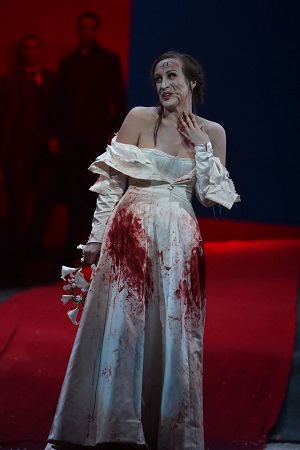 Lucia (soprano Brenda Rae) re-emerges at the wedding festivities, covered in Arturo’s blood. Photo Credit: Kelly & Massa.
Lucia (soprano Brenda Rae) re-emerges at the wedding festivities, covered in Arturo’s blood. Photo Credit: Kelly & Massa.
The luminous soprano Brenda Rae was a Donizettian’s dream, singing with poised limpid tone, savvy musical execution, and flawless coloratura. This was an utterly perfect match of artist to role. I was already convinced that no one is singing this famously difficult part better when I saw her do it in Santa Fe last summer. But unlike that flaccid staging, Pelly and Rae have collaborated to realize a staggering theatrical portrayal to match its musical eloquence.
Ms. Rae’s hapless heroine is afflicted with alarming physical tics, a slight stoop to the side, uncontrollable pumping of the fists and arms, as if fending off physical violence such as is visited upon her in her duet with her brother. Her consistency in maintaining this physicality was a motivic visual, informing us of how relentlessly her brother must brutalize her. It also inexorably builds in intensity after her unwarranted rejection by Edgardo, and her forced wedding to another patriarchal bully, Arturo. “That” she is going to snap is certain, even if “when” is not. It is to the great credit of all concerned that this thrice familiar story throbbed with emotional spontaneity.
Brenda Rae is a wonder in this repertoire. Her attractive lyric instrument has good bite and power, and she never needs to push to make her effects. Her intelligent delivery of the text invests each phrase with truth and empathy, and her unerring sense of line is a joy to hear. Florid passages are not only technically flawless but also theatrically vital. Her alluring tone is even from top to bottom, and her stage demeanor exudes star quality. There is no finer Lucia in her generation of young singers.
I am also an admirer of tenor Michael Spyres, his solid, rolling tenor possessed of uncommon beauty and vitality. Mr. Spyres has all the goods to succeed in the notoriously daunting role of Edgardo. He has an enviably good extension at the top of the staff, and if one or two of the highest reaches were slightly veiled, he knows just how to use his gifts, and knit them together to make a splendid impression. He has also gained in stage presence since last I saw him, presenting a dramatic persona that had an engaging natural ease.
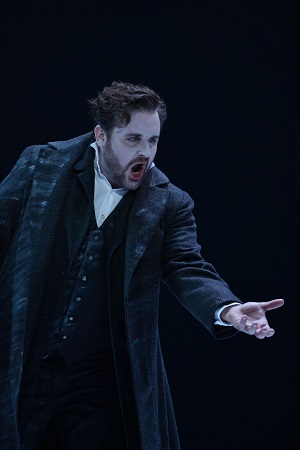 Michael Spyres as Edgardo. Photo Credit: Kelly & Massa.
Michael Spyres as Edgardo. Photo Credit: Kelly & Massa.
As Raimondo, Christian Van Horn’s very first portentous utterance announced: “Star bass!” This lanky singer not only cuts a handsome figure but also sings with laser-focused, persuasive intensity. Already hailed as a prodigiously promising talent, on the basis of this overwhelming performance, I would say the promise has been fulfilled. The excellent baritone Troy Cook has such a self-centered character to portray as Enrico, and he immerses himself into it with such convitcion, it is almost hard to stop hating him long enough to realize he is singing superbly. Mr. Cook’s buzzy, responsive baritone is a thing of great beauty, with a rock solid technique, thrilling in the exposed climaxes.
The minor roles were cast from equal strength. Andrew Owens’ bright, steady tenor made the most of Arturo’s brief assignment; tenor Adrian Kramer was a suitably brash presence as Normanno, his solid vocalizing having a hint of baritonal richness; and Hannah Ludwig’s Alisa was served by an unusually plummy, opulent mezzo that made an especially notable contribution to the famous sextet. Elizabeth Braden’s exceptional chorus not only sang with stylish elan, but also executed the complicated staging with aplomb.
Corrado Rovaris knows his way around every note of this atmospheric score, and he paced the show with stylistic acumen. Maestro Rovaris has a keen sense of theatre and he flawlessly partners the orchestra with the singers, ebbing and flowing as they live the drama together. The ardent vitality in the pit supports the unfolding tragedy with a characterful presence.
Chantal Thomas is a frequent collaborator with Mr. Pelly, often with playful, jocose set designs. On this occasion Ms. Thomas has crafted an eerie, almost spectral look, setting the tale first on a set of foreboding snow-covered hills, with a non-descript stage high structure stage right that loomed with foreboding. After a moody lighted cabin appears behind the cloud-filled scrim during Regnava nell silenzio, the up right edifice revolves to form the basis of the homestead, with more and more scrim-and-skeletal-frame walls flying in, always cutting off Lucia and forcing her forward, eventually onto the apron.
In a brilliant decision, Mr. Pelly plays the wedding scene cramped onto that forward space, blocking by the inch, and reinforcing the fact that Lucia is fatally trapped in a familial web. The Wolf’s Crag scene opens Act Two in a desolate ruin that recollects the squarish structure that opened Act One. The main hall of Lucia’s madness is a startling coup de theatre, a massive solid red wall, cut high up with arrow slits, and dressed with a single wonky row of akimbo black chairs. A red carpet lines the hill from the massive doorway to the forestage. Masterful.
The show began with an hallucination, with Lucia appearing in her wedding dress atop the largest hill, only to recede as huntsmen peopled the scene. At the end, the male chorus returned to the hill to observe Edgardo’s demise as the snow took up again. Throughout, poor Lucia’s wandering faculties were underscored with startling touches. For example, Edgardo exits upstage in an overcoat during the love duet, leaving Lucia in a down right position, then reappears in shirtsleeves to complete her imagined version of the “happy ending” of the duet, now bathed in a surreal light. In her climactic cabaletta, Lucia climbs to stand, tottering on a chair. After she releases her final high note, her cry of death, she falls into a mosh pit of choristers who hoist her aloft into a blazing special, a bloodied white flower in a sea of oppression.
The hauntingly effective lighting design was by the always commendable Duane Schuler. Mr. Pelly served as his own costume designer and his muted, texture suits, overcoats, and court wear were handsomely stolid. David Zimmerman’s hair and make-up designs were effectively austere and there were even surreal streaks of primitive facial marks in one scene if my eyes did not deceive me.
I have seen many another accomplished production of this showpiece in my day, but none other quite gripped me by the collar and never let go like this one. O18’s Lucia di Lammermoor is a nonpareil melding of engrossing theatre and stunning music.
James Sohre
Donizetti: Lucia di Lammermoor
Lucia: Brenda Rae; Enrico: Troy Cook; Edgardo: Michael Spyres; Raimondo: Christian Van Horn; Arturo: Andrew Owens; Normanno: Adrian Kramer; Alisa: Hannah Ludwig; Conductor: Corrado Rovaris; Director and Costume Design: Laurent Pelly; Set Design: Chantal Thomas; Lighting Design: Duane Schuler; Wig and Make-up Design; David Zimmerman; Chorus Master: Elizabeth Braden
image=http://www.operatoday.com/OPLucia.jpg
image_description=O18 Lucia
product=yes
product_title=Lucia di Lammermoor, Opera Philadelphia Festival
product_by=A review by James Sohre
product_id=Above: The wedding guests catch Lucia (soprano Brenda Rae) as she collapses.
Photo credit: Kelly & Massa
O18 Poulenc Evening: Moins C’est Plus
… but more on that later.
I have to say Ms. Racette is giving a wholly committed, theatrically vivid, musically thrilling account as Elle in Francis Poulenc’s monodrama. The libretto is by Jean Cocteau, based on his own play. In the fifty-minute running time, Elle is having a last, difficult phone conversation with her former lover who is about to marry another woman. In an anguished attempt to stay the inevitable, the woman desperately processes the reality of her unrequited love.
There is no aspect of this complex “conversation” that eludes this fine performer. Her sudden shifts of temperament, her calculating tactics, her frightened outbursts as the phone disconnects, the occasional catch in the voice, her aching persistence, all combine to make as good a case for the somewhat repetitive script as possible. Moreover, Elle is a perfect vocal fit for Racette at this point in her illustrious career.
The conversational writing of the vast majority of the score is easily encompassed by her full-bodied soprano, the middle and lower registers “speaking” with a ripe presence, and the top congenially negotiated. In my recent encounters, her very top notes have sometimes been characterized by a more generous vibrato than in the past, but on this occasion the singing was wonderfully controlled in the upper reaches of Poulenc’s leaping phrases, and they were generously weighted with searing drama.
A take-no-prisoners performance of such accomplishment and artistry does not come along every day, and Patricia Racette’s traversal is a memorable marvel of this or any other festival. Her partner in music-making, pianist Christopher Allen proved a thrilling collaborator, finding orchestral colors in his virtuosic playing.
With the evening marketed as Ne quittez pas, this short piece was preceded by a noble attempt to fill out the program and create a “first act” based on Poulenc songs, piano works and a dash of Apollinaire, to “set up” the opera proper, and to provide a backstory for Elle’s predicament. What looked good on paper proved problematic in execution.
The premise is that it is past closing time at a nightclub-cum-cabaret, not unlike the Living Arts Theatre, the venue we are sitting in. A chain-smoking, brooding pianist (Mr. Allen) is being chided by the owner (Ames Adamson), who for some reason has a cockney accent, urging him to find new material for the house’s fading diva (presumably Elle whom we have yet to meet). The owner storms off and leaves the pianist to play some introspective Poulenc. And smoke. And smoke. And. Smoke.
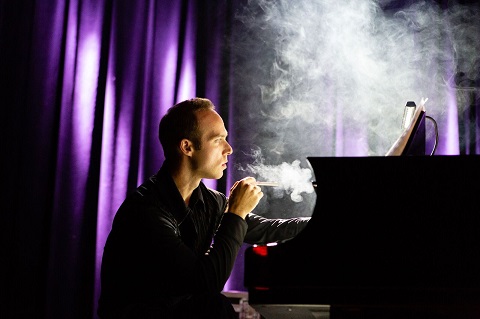 Christopher Allen. Photo Credit: Dominic M. Mercier.
Christopher Allen. Photo Credit: Dominic M. Mercier.
There is a beating at the door that interrupts the pouty piano player. It is a hipster brother and sister team, Paul and Elizabeth/Lise, (Marc Bendavid and Mary Tuomanen ), hell-bent on upheaval and debauchery who have a handsome man (Le jeune homme) somewhat unwillingly in tow. They argue, they smash things, and the brother insists they play “The Game,” in which the young man must inexplicably do whatever bawdy act he is bid. None of these characters is likable, sympathetic, or appealing, although they are physically attractive. I looked at my watch. Twenty minutes have passed and not a note has been sung by anyone. Opera, anyone?
Finally, le jeune homme begins performing a series of rather randomly assembled Poulenc songs (they may have had an intended logic that eluded me). He started out performing intimate acts against his will, later giving in more eagerly to his fate. Edward Nelson performs his assignments with a most agreeable, burnished baritone, although a few of the uppermost notes were not without effort. Still, Mr. Nelson thereafter admirably performed an almost non-stop recital while being spun around, shoved, forced into various carnal positions, stripped to the waist, tied up, blindfolded, and man-(and woman-) handled. I sometimes wondered how he managed to sing at all, much less as mellifluously as he did. After sixty longish minutes, this “prequel” premise eventually limped to an end with a baffling lack of closure. The intermission chatter in my part of the house was marked by confusion, belying the clarity of set-up to which the venture aspired.
Not that there is not merit to be found in this concept. Director James Darrah is clearly talented. His varied and focused La voix humaine was a model of invention, unity of purpose, and honestly motivated emotions. In the first act however, Mr. Darrah seemed more intent on shocking than informing. That said, he used the space creatively, elicited brazen performances from the performers, got in our faces with fervent intent, and made undeniably bold choices. Too bad he didn’t also instill some heart and soul into the proceedings. The relentless abrasiveness was not helped by over amplifying the actors.
Tony Fanning is credited for the efficient, effective production design. Mr. Fanning has created sort of oversized triptych of mirrors on stage center, matching the red and pink hues of a mirrored faux bar house level right. The grand piano occupies stage right and an unused drum trap set stage left. Handsome long, red, tube shaped lamps hover somewhat portentously over the center stage action. The wide-ranging playing space extends to a semi-circular aisle running between the rear seats and the prime table seating. Actors even wind up in the actual, operational side bar and the balcony. This immersive use of the environment was a solid plus.
Pablo Santiago worked considerable magic with an eclectic lighting design, and he came up with some great solutions in defining the areas in a sprawling playing space, including judicious use of the house lights. His shifts of intensity and colors ably underscored the personal journey of the characters, most especially Elle. Chrisi Karvonides’ effectively shifted from tongue-in-cheek bohemian kink (Act One) to understated elegance for Elle in “La voix humaine.” David Zimmerman provided an effective hair and make-up design.
Why Elle has returned to this venue to make her phone call is not entirely clear. It was curious that the pianist entered after she did, and then pretended at first to be asleep on the piano. Did he miss his places call? In my memory, Elle did not refer to his obvious presence, although Act One clearly seemed to establish him as a character with a relationship to her.
Was the baritone meant to be her former lover on the phone? I guess. Was the sister meant to be his bride? How did his homosexual attraction to the brother figure in? Ah well, better to not keep looking for answers and revel instead in Patricia’s glorious star turn, reason enough for rejoicing.
In the end, however well-intended, Ne quittez pas, for all its admirable professionalism, left me wanting less.
James Sohre
Ne Quittez Pas: A Reimagined La voix humaine
Music by Francis Poulenc
Libretto by Jean Cocteau (based on his play)
Additional songs and music by Francis Poulenc
Elle: Patricia Racette; Le jeune home: Edward Nelson; Paul: Marc Bendavid; Elizabeth/Lise; Mary Tuomanen; The owner: Ames Adamson; Pianist: Christopher Allen; Director: James Darrah; Production Design: Tony Fanning; Costume Design: Chrisi Karvonides; Lighting Design: Pablo Santiago; Wig and Make-up Design: David Zimmerman.
image=http://www.operatoday.com/Marc%20and%20Lise.jpg
image_description=Marc Bendavid as Paul and Mary Tuomanen as Elizabeth/Lise
product=yes
product_title=Ne Quittez Pas, Opera Philadelphia Festival
Marc Bendavid as Paul and Mary Tuomanen as Elizabeth/Lise
product_by=A review by James Sohre
product_id=Above: Marc Bendavid as Paul and Mary Tuomanen as Elizabeth/Lise
Photo credit: Adam Larsen
September 23, 2018
O18: Unsettling, Riveting Sky on Swings
Former composer in residence Lembit Beecher is well known in the city, not least for last year’s intriguing staging of I Have No Stories To Tell You. He has grown considerably even since that commendable accomplishment.
While that piece was driven by flashbacks, Sky on Wings is a surreal journey into Alzheimer’s in which there are fewer if any memories. The (in-)action is moving into an uninformed future, which in actuality becomes just a muddled “now.” Hannah Moscovitch has crafted a lean libretto that cunningly contrasts the condition of the institutionalized, hallucinatory Martha with the still occasionally lucid, but desperately degenerating Danny.
But this is anything but a maudlin wallow, thanks to the wit and clarity of Ms. Moscovitch’s cogent dialogue and monologues, and owing to Mr. Beecher’s skittering scoring that occasionally settles into lush, serene moments that can take your breath away. Too, the scripting allows the two main characters to inevitably develop a satisfying co-dependence that blessedly eschews cliché.
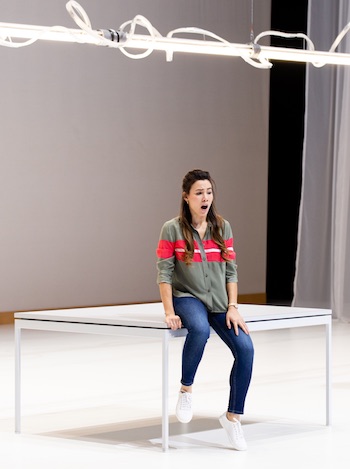 Sharleen Joynt as Winnie [Photo by Dominic M. Mercier]
Sharleen Joynt as Winnie [Photo by Dominic M. Mercier]
There is a four-person chorus of Elders that not only contributes to the unease of the sound world, but also performs smaller featured moments. There are many sound palettes in the composer’s arsenal that evoke echoes of Stockhausen, the layered dissonances, the muttered gibberish, the occasional Sprechstimme, the leaping vocals. But the conversational rhythms and vocal lines are distinctly Beecher’s. The masterful orchestration with its exposed solo winds, rackety brass, slithering strings, manic keyboard licks, and tricky ensemble requirements made a vibrant impression in the intimate Perelman Theatre.
That is perhaps largely owing to conductor Geoffrey McDonald whose concise, minimalist baton work unleashed accuracy and fire from his players and vocalists. This is such a tightly interwoven, often restless creation that one slip could be fatal, but Maestro McDonald’s laser focused attention to detail brought the score thrillingly to life. That the cast could not have been bettered was probably because the roles were created with (at least two of) them in mind.
Beloved star mezzo Frederica von Stade as Danny takes the most linear journey in the show. Her character is an accomplished professional, admired for her intellect and her writing, who is woefully aware of her debilitating affliction. I don’t personally know Ms. von Stade’s age but I do know that she wowed me as a definitive Cherubino in the 1970’s and well, I know how much older I am now.
Remarkably, her singing has lost little of the fresh, immediately ingratiating quality of her earlier career. While there is a noticeable break between registers today, she still commands secure tone and admirable technique. Indeed, when vocal lines carry her to impassioned, sustained outbursts above the staff, Flicka can still pour out heated, gleaming high notes. Moreover, she remains a superb actress. Her conflicted state runs the gamut from anger to self-pity to determination to defiance, but never to acceptance of her fate.
One of the most affecting moments is when “Danny” insists she can remember the name of her dog, then can’t, then tentatively calls for “Sparky,” with neither she nor we being sure that is really his name. The perfection of that horrifying moment sent a chill racing down my spine (there it is again just recollecting it). Frederica von Stade is still assuredly at the top of her game.
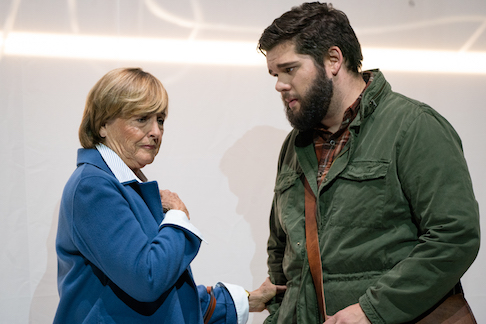 Danny (mezzo-soprano Frederica von Stade) and son Ira (tenor Daniel Taylor) realize she has Alzheimer’s [Photo by Steven Pisano]
Danny (mezzo-soprano Frederica von Stade) and son Ira (tenor Daniel Taylor) realize she has Alzheimer’s [Photo by Steven Pisano]
As her contrasting acquaintance Martha, Marietta Simpson is her artistic equal, albeit with a very different assignment. “Martha” is already well down the path to dementia, not fighting it as hard since she doesn’t even quite know what the fight is. Consequently, much of her vocalizing is more incoherent, more diffuse, often evolving into stammered nonsense and non sequiturs.
I never heard this acclaimed artist live before, but it is my pleasure to encounter her even late in her career. She has incredible concentration and effortlessly meets all the demands of this difficult role. The substantial voice does have a slight huskiness, but it is a warm patina that serves the aging character well. Ms. Simpson is unstinting in her commitment to represent the warts of the character and the debilitating effects of the condition, succeeding in encompassing all the demands of wide-ranging vocal lines.
Singly or in tandem, the two ladies are giving true star performances, by turns heart wrenching and heart warming. It is subtly ironic that these two women need absolute presence of mind to portray two women who have lost theirs. Bravi!
As Martha’s resigned, if impatiently tolerant daughter, Sharleen Joynt’s pure, glinting soprano ably tossed off the angular writing assigned to her. As Danny’s sympathetic son, Daniel Taylor showed off a solid, ringing tenor that was rich and intense. The quartet of Elders (Veronica Chapman-Smith, Maren Montalbano, George Somerville, Frank Mitchell) were simply phenomenal in their concerted focus and execution. A Greek Chorus gone wrong, they prowled the stage like caged animals one moment and framed meaningful “still” stage pictures they next. They raged, they howled, they moaned, they stuttered, and they provided a disturbingly complex aural commentary and background for this tragic story.
In another irony for a piece where everything is unsettled, the accomplished director’s name is Joanna Settle. Ms. Settle has worked miracles with her gifted collaborators, creating an engrossing stage piece out of a horrible “accident” we can’t look away from. Her unerring skill at blocking is coupled with a total commitment to character explorations that are unnerving in their honesty and variation. By the end of the piece we know these people, and suffer with them. In a brilliant touch, the director deploys actual old supernumeraries in an unending single file parade upstage, visually underscoring that there is no end to this scourge that knows no demographic.
Andrew Lieberman contributed a spare, accomplished set design, a half a white “box” stage right and upstage, with two oversized door frames, with a wall of white gauzy drapes stage left. The set pieces consisted merely of a large heavy table and two white chairs that were moved about to suggest various locales. For effect, a pipe flew in with a stage-width tubular squiggle attached. The pipe adjusted to various heights, and the scribble changed color to reflect the emotional states of the characters. Spoiler alert: it finally crashes and short-circuits at a crucial moment. The only other set element was a mid-stage pipe that flew in, on which an 8 foot high scrim was able to be drawn to bisect the action.
Tilly Grimes has designed spot-on contemporary costumes that brilliantly represent the characters wearing them. Rarely has modern day stage dress been so unobtrusive yet so revelatory. Pat Collin’s magnificent lighting design is ably complemented by Daniel Perelstein’s subtle, effective projections. Together, the pair has crafted a tellingly subliminal suggestion of shifting moods and altered reality. David Zimmerman’s apt hair and make-up design was especially affective with the weathered look of the Elders.
Sky on Swings is an important, innovative new work mounted with such obvious skill and care that it emphatically embodies all that Opera Philadelphia is attempting to achieve with their bold festival concept. Its triumph sheds glory on all concerned.
James Sohre
Sky on Swings
Music by Lembit Beecher
Libretto by Hannah Moscovitch
Danny: Frederica von Stade; Martha: Marietta Simpson; Winnie: Sharleen Joynt; Ira: Daniel Taylor; Elder #1: Veronica Chapman-Smith; Elder #2/Elderly Woman: Maren Montalbano; Elder #3: George Somerville; Elder #4/Administrator: Frank Mitchell; Conductor: Geoffrey McDonald; Director: Joanna Settle; Set Design: Andrew Lieberman; Costume Design: Tilly Grimes; Lighting Design: Pat Collins; Projection Design: Jorge Cousineau; Sound Design: Daniel Perelstein; Wig and Make-up Design: David Zimmerman
image=http://www.operatoday.com/SKY%20ON%20SWINGS%2020%20SP.jpg
image_description=Marietta Simpson as Martha and Frederica von Stade as Danny [Photo by Steven Pisan]
product=yes
product_title=O18: Unsettling, Riveting Sky on Swings
product_by=A review by James Sohre
product_id=Above: Marietta Simpson as Martha and Frederica von Stade as Danny [Photo by Steven Pisan]
September 21, 2018
Vaughan Williams: A Sea Symphony — Martyn Brabbins BBCSO
Although Brabbins has not hitherto recorded much Vaughan Williams, he is a superlative conductor of British music and of 20th century British music in particular, so the prospect of a new Hyperion series with Brabbins is intriguing.
The brass fanfare sparkles, strong and bright, rather than brassy, introducing the first line "Behold, the Sea! ". In many ways, this symphony is a secular hymn to the sea and what it might represent, so the voice parts are integral to meaning. For a moment the orchestra sings on its own but the voices rise upon the crest, chorus and orchestra surging forwards together. A roll of timpani, and again the anthem "Behold the Sea!" repeated wave after wave. The tide fades, introducing a new theme highlighted by rhythms that suggest shanty song. Hence the interplay between the first soloist and the chorus, "a chant for the sailors of all nations, Fitful, like a surge". This call and response relationship also suggests sacred song. The flags flying here include a special one "for the soul of man"......a spiritual woven signal for all nations, emblem of man elate above death, Token of all brave captains and all intrepid sailors and mates". Though the influence of Debussy and Ravel is significant, the Sea Symphony is very much part of the English choral tradition, albeit in very sophisticated form. After a brief lull, the music surges forth again, underlined by organ. The baritone returns, singing of the "pennant universal", the chorus and soprano repeating the words in concurrence. Then, as so often in chorale, the first verse returns, the soprano at first on her own, the theme elaborated by the baritone, chorus and orchestra together.
The second movement is introduced by mysterious low harmonies, setting the mood "On the beach at night alone". Here, the organ is particularly resonant, the brass and low timbred winds calling out as if in hymnal. At first the baritone is alone, but gradually joined by small than full chorus. "All nations, all identities......This vast similitude spans them". The voices and orchestra repeat the themes, like waves, rising and falling in volume and force. Beautifully judged orchestral playing, the solo instruments heard clearly, before blending back into the whole, rather like stars in a night sky. The fanfare in the scherzo movement was more tumultuous than the fanfare at the very start, for it describes the churning of waves "in the wake of the sea-ship after she passes" - wild but not "motley" given the precise definition in the music, which Brabbins kept sharply focused.
If A Sea Symphony is a journey. it is one which proceeds, like many journeys, looking backwards at turns, but ever forward. Hence the final movement, titled The Explorers, where the ship appears to be taking off into unknown territory. The scherzo movement operated like a Dies Irae, a monent of judgement clearing the way for a more esoteric future. "After the seas are all cross'd, ........The true son of God shall come singing his songs." The mood is now altogether more esoteric, the first verse serene yet expansive with long lines that seem to stretch and search. Shimmering strings echo the voices of the chorus, then joined by brass and winds, and later organ, repeat the harmonies. After this long choral section, the symphony reaches a new stage. Farnsworth and Llewellyn lead the way ahead "fearlessfor unknown shores on waves of ecstasy to sail". The solo violin defines yet another stage, with an element of peaceful bliss. Thus we are prepared for the section "O thou transcendent". Farnsworth's voice glows, the relative lightness of his baritone well suited to the luminous imagery in the text. In the finale, the energy and exuberance of the first movemen returns, invigorated "Away ! Away O soul! hoist instantly the anchor!" Llewelyn rallies the chorus and the orchestra surges yet again. Sea shanty rhythms are heard again as the "ship" sets forth. The motif "Behold the Sea" is reprised before the very last section, but as the "ship" sails out of sight, silence gradually descends, as if some form of transcendence is achieved. Brabbins's instinct for structure, honed from years of experience in modern music, pays off handsomely in this last movement, which unfolds with great coherence. This A Sea Symphony feels like the herald of a new age, as indeed it was, connecting also to other 20th century music of spiritual yearning.
As a bonus, this recording includes Darest thou now, O soul, a three minute miniature for unison voices and string orchestra, (a hymn with orchestra !) using the same Walt Whitman text which Vaughan Williams used in Towards the Unknown Region. It is an excellent choice, complementing A Sea Symphony not only in terms of poetic ideas but also taking up the violin line near the end of the symphony.
Anne Ozorio
image=http://www.operatoday.com/Sea_Symphony_Hyperion.png
image_description=Hyperion Records CDA68245[ CD]
product=yes
product_title=
product_by=Ralph Vaughan Williams : A Sea Symphony. Martyn Brabbins, BBC Symphony Orchestra, BBC Symphony Chorus, Elizabeth Llewellyn, Marcus Farnsworth,
product_id=Hyperion Records CDA68245[ CD]
price=$19.98
product_url=https://amzn.to/2I5BlFQ
Simon Rattle — Birtwistle, Holst, Turnage, and Britten
Short as it was, this fanfare was more substantial than it might have seemed at first. Like the composer himself, it was forthright and direct — no messing about. Hence the gruff low timbres and pugnacious sassiness, punctuated by percussion, with woodwind interjection, and later a tuba solo. Characteristic Birtwistle quirks and earthiness. Oddly enough the piece sounded like the way Birtwistle speaks in conversation. Since Birtwistle and Rattle have had a long relationship that goes back to the mid 1970’s, Donum Simoni is personal, like an autographed portrait of the composer with an affectionate dedication to an old friend.
In a masterstroke of provocative but inspired programming, Rattle followed Birtwistle with Gustav Holst. Holst’s Egdon Heath (A homage to Thomas Hardy) op 47 (1927) is rooted in the idea of timeless landscape. Like Hardy’s Wessex, Egdon Heath doesn’t exist, though it feels as though it should. Low rumbling harmonies, long, ambiguous string lines that seem to be hovering between tonalities: like mist above a heath. Tempi speed up, but clear, long lines return and an anthem-like motif emerges : almost Elgarian in the way that it evokes time and place. A single trumpet rang clear and the sounds dissolved into the ether around them. Though Rattle has built his reputation on new music, he has done a lot of Elgar and Sibelius. This Egdon Heath was a beautifully textured tone poem rich with feeling. Rattle is making connections between Holst and Birtwistle, who creates imaginary landscapes, rough hewn from almost organic forces, merging past, present and future in co-existing layers. Some may scream that Holst isn’t “modern” but yes he was, in his own way. Rattle’s gift for intelligent musical juxtapositions is one of his strengths, from which we can learn.
Rattle and Mark-Anthony Turnage have worked together for decades, too. Rattle premiered Turnage’s Remembering ‘in memoriam Evan Scofield’ with the LSO at the Barbican last year and with the Berliner Philharmoniker in Berlin. Turnage’s Dispelling the Fears from 1994/5 is a much earlier work. Trumpet players Philip Cobb and Gábor Tarkövi are principals of the LSO and the Berliner Philharmoniker respectively, so this performance was also a drawing together of past, present and future. The two trumpets stalk each other in dialogue and at cross-purposes, connecting and disconnecting with the orchestra around them. Though it is a serious work, there’s wit in it too, which connected it, in turn, to Benjamin Britten’s Spring Symphony.
Britten’s Spring Symphony (1948) is big, flamboyant and bursting with good-humoured high jinks — an excellent choice with which to open a new season. Rattle and the London Symphony Orchestra were joined here by soloists Alice Coote, Elizabeth Watts and Allan Clayton with the London Symphony Chorus (Simon Halsey), the Tiffin Boy’s Choir, the Tiffin Girls’ School Choir and the Tiffin Children’s Chorus (James Day). The Spring Symphony is more than symphony : it is a piece of music theatre, where visuals count. Here, the youth choruses walked into the Barbican Hall and sang from the edge of the platform, up one aisle and on the stage itself. Not quite as stunning as last year’s Berlioz Damnation of Faust when Rattle and the LSO were joined by young singers who seemed to materialize everywhere. But the difference lay in the music itself. Cheerful as the Spring Symphony is, there’s something very “English” about it, and its high spirits need a certain degree of discretion. In terms of Britten’s output it occupies a strange place. It’s not Peter Grimes, but closer to another genre dear to Britten’s heart : community music-making for the sheer pleasure of making music together.
Thus the sprawling structure, four parts with twelve distinct sections, which together form a large, impressionistic portrait of Spring in its many manifestations, a Birtwistle “landscape” of sorts. If there’s any symphonic predecessor, it might be Mahler’s Symphony no 3 where summer rushes in with exuberant vigour. Like the god Pan, artists don’t follow rules : they create. Thus the many different texts from various sources, some medieval, some modern, and the variety of settings and styles. Wisely, Rattle didn’t try to homogenize them, but kept the separate parts distinct, so each shone on its own merits. A blazing “Shine out, fair sun !” set the mood. There are many Brittenesque elements in the piece which would be fun to isolate, and relate to, later works, but it is enough that the work as a whole flows naturally as a series of tableaux. Lively performances : everyone having a good time. Which is as things should be. Rattle, a consummate communicator, knows how to share his enthusiasm with performers and with audiences. A lot of fuss these days is made of grim-faced pious “music education” but this is how things actually work in the real world. Note the final section “London to thee I do present the merry month of May”.
Anne Ozorio
image=http://www.operatoday.com/Harrison_Birtwistle.png image_description=Harrison Birtwistle [Source: Wikipedia] product=yes product_title=Simon Rattle — Birtwistle, Holst, Turnage, and Britten product_by=A review by Anne Ozorio product_id=Above: Harrison Birtwistle [Source: Wikipedia]September 20, 2018
OSJ: A Funny Thing Happened on the Way to the Harem
This is an extremely tricky piece to pull off in 2019, a comedy that is about holding women against their will with the hopeful expectation of romantic capitulation. Factor in the East (Muslims) versus West (Christians) undertones and well. . . anyone see the possible contemporary pitfalls here? Happily, the gifted director Michael Shell essayed the challenges, and effectively trod a fine line between a somewhat “battle of the sexes” take on the comedy and a commendably honest appraisal of two differing sets of cultural mores.
Mr. Shell has coaxed his superior cast to find the heart of their characters, to avoid off-putting stereotypes, and to embody complex, conflicted human beings. The humor is derived from well-intended, honestly motivated mismatching rather than the underlying misogyny. The latter is certainly found in the piece, but the director commendably uses it as cultural background, not a #MeToo statement, allowing the audience to draw its own conclusion.
Knowing that the serious moments of reflection will play better contrasted to a light touch elsewhere, Michael discovers every moment he can to conjure up humor with playful stage business, scrappy physical confrontations, and a tongue in cheek nod to the absurdity of the premise. The well-judged, fluid blocking resulted in stage pictures that morphed spontaneously into attractive tableaus. In the end, the cumulative effect of Shell’s direction, resulting in the believable benevolence of Pasha Selim forgave whatever hijinks may have come before.
That the denouement worked so affectingly was largely owing to Nathan Stark’s star turn as Selim. Never mind that Mr. Stark has one of the finest voices in the business, he doesn’t sing a note in this one! Ah, but what he does have in abundance is star quality. And comic sensibilities. He has a way of making self-absorbed characters appealingly unaware of their ridiculous pomposity. And Nathan has a charisma that can fill out a potentially one-dimensional personage to ingratiate himself not only to an audience, but to other characters on stage. I don’t have to go out on much of a limb to say that Nathan Stark is the most enjoyable Pasha Selim of my experience. He is in great company with the superb cast of singers who DO sing.
Constanze is an Everest of a role, written by young Wolfgang with arguably more abandon than consistently good vocal sense. It has daunted many a practitioner, not least of which the great Joan Sutherland who famously withdrew from a new Met production being mounted especially for her because she just couldn’t get it in her voice. On this occasion, the role held no fear for the highly accomplished soprano Rebecca Davis, whose limpid, often fluty singing was not only beautifully judged but also uncannily even in production.
Ms. Davis was in complete charge of a performance that included fiery, accurate coloratura pyrotechnics, jaw-dropping ease shifting registers, heartfelt outpourings of love for Belmonte, and heartbreaking protestations to Selim. This was one of those rare Constanze traversals that perfectly matched artist with role, a bravura achievement.
Matthew Grills was a totally commendable Belmonte. A light-voiced tenor who has also performed Pedrillo, Mr. Grills has a honeyed sound that can indeed also encompass the meatier demands of Belmonte’s heroic music, especially in a house the size of the California Theatre, which is very congenial to young lyric singers. His fluid phrasing and pulsating, arching sense of line ably informed the role, and his assured rendition of Ich baue ganz for once left us wanting more.
Ashraf Sewailam was anything but the usual caricature as a handsome, determined Osmin. Mr. Sewailam has all the rumbling low notes in order as he must relentlessly drill below the staff (youthful Wolfgang again!), but in the mid and upper range his burly bass blooms with compelling beauty. When Osmin does need to stutter or bluster, Ashraf is up to the momentary bouts with low (pun intended) comedy. He pulls of the neat trick of being sympathetic because his Osmin utterly clueless that he is somewhat despicable.
Completing the cast, Katrina Galka was a pert, silver-toned Blonde. Part hellion, part Gloria Steinem, part Kewpie doll, the attractive Ms. Galka’s enjoyably animated antics were a perfect balance to Constanze’s comparatively sedate presence. Moreover, Katrina has a sound technique, innate musicality, and ravishing soprano that delights the ears and touches the heart. Michael Dailey was a strapping, handsome Pedrillo that was quite pleasantly cast against the usual type. No second banana he, Mr. Dailey’s well-schooled, appealing tenor had substantial body and he deployed it winningly in crafting a character the held his own in this gifted cast. Andrew Whitfield’s full-throated chorus completed the ensemble.
George Manahan conducted a knowing reading in the pit, one that admirably relaxed into a stylish interpretation after just a bit of stiffness in the opening instrumental pages. Maestro Manahan has a fine understanding of the pace and arc of the piece, and his instrumentalists responded with a polished panache. The instances of transparent ensemble and solo passages were especially revelatory.
Opera San Jose can be counted on to produce accomplished physical productions and this was no exception. Set designer Steven Kemp’s lavish, richly detailed Moorish structures and plentitude of flora elicited well-deserved gasps and bursts of applause. Not to be outdone, Ulises Alcala dazzled the eye with a diverse array of colorful Turkish garb balanced by more sedate, well-tailored Western travel clothes. Pamela Z. Gray’s diverse, responsive lighting design was notable not only for its rich washes and area lighting, but also for abruptly highlighting sudden asides by Pasha and almost immediately restoring. Christina Martin’s accomplished make-up and wig design was a notable contribution, especially her visual transformation of Mr. Stark into Pasha Selim.
This interpretation found the dialogue performed in English with the vocals all performed in German, seeming just a bit artistically schizophrenic. I know there is a history of such practice (Fledermaus, anyone?) but for my money, pick one and stick to it. Never you mind, the opening night audience had more than plenty to cheer, and cheer they did. The conviviality and festive atmosphere spilled over well into the evening with a lively 35th opening night party.
For the company’s Mozart enthusiasts who clamored for The Abduction from the Seraglio to finally join the roster, this polished, ebullient performance surely proved worth the wait.
James Sohre
Cast and production information:
Konstanze: Rebecca Davis; Blonde: Katrina Galka: Belmonte; Matthew Grills; Osmin: Ashraf Sewailam; Pedrillo: Michael Dailey; Pasha Selim: Nathan Stark; Conductor: George Manahan; Director: Michael Shell; Set Design: Steven Kemp; Costume Design: Ulises Alcala; Lighting Design: Pamila Z. Gray; Wigs/Makeup Design: Christina Martin; Chorus Master: Andrew Whitfield
image=http://www.operatoday.com/abduction_5.png
image_description=Rebecca Davis as Konstanze [Photo by Pat Kirk]
product=yes
product_title=OSJ: A Funny Thing Happened on the Way to the Harem
product_by=A review by James Sohre
product_id=Above: Rebecca Davis as Konstanze [Photo by Pat Kirk]
Superlative Lohengrin from Bayreuth, 1967
James King was a steady, sturdy singer, though less magical in sound than Harper. Among his memorable recordings are Das Lied von der Erde (with Fischer-Dieskau, Bernstein conducting) and Solti’s Ring Cycle (in which he sang Siegmund to Régine Crespin’s utterly lovable Sieglinde).
Here we have the two at Bayreuth, in a broadcast recording of a performance of Lohengrin from July 30, 1967. This was the first season of a new staging for the work, by Wolfgang Wagner, replacing a highly abstract one by his brother Wieland, who had died the year before. Five tenors appeared in the course of the summer in one or more of the eight performances. In the performance released here, James King took over from Sandór Kónya on three hours’ notice, and received much praise for his “wonderfully bright-toned, heroic tenor voice that is expressive without ever sounding schmaltzy.” The other singers were also praised to the skies.
Critics can be easily swayed, of course, and I was prepared for some disappointment when I started to listen. Astonishingly enough, the critics were right! These performances are among the best ever recorded, and without the benefit of patch sessions or even of having two or three performances to blend together. Five of the six singers named above produce a stream of firm tone, clear in pitch and without excessive vibrato, while also conveying the dramatic meaning vividly. What a relief this must have been to Wagner lovers who had become accustomed to much barking, ranting, and wobbling. (There are many instances of the latter in a Munich performance of Lohengrin from 1963, under Knappertsbusch, recently released and featuring entirely German and Scandinavian singers. See my somewhat pained review . There are instances also in the recent Concertgebouw recording, which I likewise reviewed here. The one truly cherishable element in the latter recording is the luminous reading of the title role by Klaus Florian Vogt.)
Harper and King, caught in their prime, are marvelous to hear. Her Elsa is at once warm and ethereal. (Don’t ask me how this is achieved.) His Swan Knight conveys a sense of natural command and self-control. True, King could have started the bridal-chamber scene more quietly (as Jess Thomas did, memorably, on Kempe’s 1962-63 studio recording), but his interpretation shows keen awareness of the shifts in the Lohengrin-Elsa relationship in the course of the scene, including some memorable touches of ruefulness as Lohengrin begins to realize that Elsa cannot hold to her promise not to question him about his origins. King’s reading of the role is familiar to collectors from a studio recording (apparently otherwise of uneven quality) conducted by Rafael Kubelik. As for Harper, Elsa seems to be one of the “biggest” roles that she undertook. Strauss’s Arabella was another. I imagine that this demonstrated good judgment, enabling her to protect the core of her sound for some years.
The one weak point in the casting, for my taste, is Donald McIntyre in the dramatic-baritone role of Telramund. McIntyre was a highly intelligent artist, much recorded (e.g., for Boulez: Golaud, 1969, and Wotan, 1976). When he sings quietly or in half-voice, as in parts of his long Act 2 colloquy with Ortrud, this is a major assumption of a major role. But other passages, even in that same scene and also near the end of Act 2, show him forcing the voice and producing much woofy tone or a spray of consonants with little linking tone. I suppose, though, that a case can be made for having Telramund, when he gets frustrated, sound like the nasty, petty dwarf Mime in the Ring Cycle.
Grace (born Goldie) Hoffman, from Cleveland, ended up making her career in Europe, singing major roles (e.g., Brangäne) in Vienna and at La Scala. Here she shows her extensive stage experience, creating a credible character for Ortrud yet always keeping the sound clear and full. (A revealing detail: Harper, Hoffman, and King all have enough flexibility to manage the occasional mordent in their vocal lines.)
Karl Ridderbusch was one of the world’s great exponents of such leading roles as Hans Sachs and Baron Ochs. As King Heinrich, he is unsurpassable: authoritative and eloquent. (Here is his Act 1 address.)
American baritone Thomas Tipton was a new name to me: he, like Hoffman, performed mainly in Europe, and he also acted in some films. His enunciation in the role of the Herald is splendid, his tone solid and sweet.
Even the small roles are admirably taken, such as the Four Noble Boys, sung by women who manage to sound like adorable piping youngsters.
The Bayreuth orchestra plays superbly. I have rarely heard a live recording of such a complex work in which ensemble and intonation were so precise. (YouTube offers the Preludes to Acts 1 and 3 .) The brass are particularly splendid, except for some almost inevitable mismatches of pitch in the passage—with multiple fanfares coming from all directions—that begins the opera’s finale scene. I was put off by the sound of the solo oboe and clarinet in quiet episodes in the prelude to Act 3, but that is probably a matter of taste. (I have often disliked the sound of German and Austrian oboists.) The Bayreuth chorus, under the renowned Wilhelm Pitz, is, if anything, even better than the orchestra.
Kempe (1910-76) is heard here in his last season at Bayreuth. (He would thereafter devote himself more to orchestral conducting, notably in Zurich, Munich, and London.) He chooses tempos astutely and artfully adjusts them to match the twists and turns of the drama and the capabilities of his marvelous singers. All in all, his reading is self-effacingly masterful, fully up to the level of his aforementioned studio recording.
One warning: microphone placement is not always ideal. Heather Harper’s first statements in Elsa’s Act 2 scene with Ortrud are somewhat undefined because she is at that point singing from the castle’s balcony (as the stage directions require). Once Elsa joins Ortrud downstairs, Harper’s voice registers beautifully again. The orchestra is often a bit more recessed than in the best studio recordings, but I never felt that I was missing anything crucial.
I would recommend (as do many other critics) Kempe’s studio recording, on EMI, as anybody’s first introduction to the work. It shows all the usual advantages of the studio process, with none of the disadvantages. Everything sounds as spontaneous as in a live performance. The Elsa, Ortrud, and Telramund are Elisabeth Grümmer, Christa Ludwig, and Dietrich Fischer-Dieskau, and all are unsurpassed in their roles, though Fischer-Dieskau’s voice might not have been able to carry as Telramund in a large hall such as the Met. The Lohengrin, Jess Thomas, was, like James King, an American. He sings almost as beautifully (though somewhat less steadily toward the end of the bridal-chamber scene), and his pronunciation of German is better. (King often pronounces the letter “r” the American way, toward the front of the mouth. “Ich” often becomes “ick.”)
For his studio recording, Kempe opened the usual five-minute cut in Act 3 after Elsa faints. The CD re-release of that EMI recording includes the libretto and translation on a fourth disc.
There are other major studio recordings of Lohengrin that are worth getting to know: I have read much praise for the ones conducted by George Solti, featuring Jessye Norman, Plácido Domingo, and Hans Sotin, and by Claudio Abbado, featuring Cheryl Studer, Siegfried Jerusalem , and Kurt Moll. Mark Elder’s concert recording (mentioned above) has marvelous playing, plus Vogt as a most unusual Lohengrin.
Still, Kempe’s 1967 Bayreuth performance, despite making the 5-minute cut in Act 3, leaps into the top class of performances available to the eager lover of Wagner and of great singing. Not least, it sounds alive and exciting, never like the product of a sleek recording factory. We’re lucky to have it, 50 years later, in what I suspect is better sound than ever. (An earlier release of the same performance can be heard on YouTube.) The booklet-essay is very informative, full of quotations from newspaper reviews of the performance, and well translated. No libretto.
Ralph P. Locke
The above review is a lightly revised version of one that first appeared in American Record Guide and appears here by kind permission.
Ralph P. Locke is emeritus professor of musicology at the University of Rochester’s Eastman School of Music. Six of his articles have won the ASCAP-Deems Taylor Award for excellence in writing about music. His most recent two books are Musical Exoticism: Images and Reflections and Music and the Exotic from the Renaissance to Mozart (both Cambridge University Press). Both are now available in paperback, and the second is also available as an e-book.
image=http://www.operatoday.com/Lohengrin_Kempe.png image_description=Orfeo C850113D product=yes product_title=WAGNER: Lohengrin product_by=Heather Harper (Elsa), Grace Hoffman (Ortrud), James King (Lohengrin), Thomas Tipton (Herald), Donald McIntyre (Telramund), Karl Ridderbusch (King Heinrich). Bayreuth Orchestra and Chorus, conducted by Rudolf Kempe. product_id=Orfeo C850113D [3 CDs] price=$54.99 product_url=https://amzn.to/2DhCQSG
September 19, 2018
Isouard's Cinderella: Bampton Classical Opera at St John's Smith Square
We may relish our submission to fantasy but flippancy and human foolishness are necessary ingredients too, and Bampton Classical Opera, in presenting their twenty-fifth anniversary production - Cinderella, by the Franco-Maltese Nicolò Isouard who died 200 years ago at the age of 41 - have found the perfect recipe for their magic spell.
(Isouard’s three-act opéra-féerie was premiered at the Opéra-Comique on 22 nd February 1810. See my article, Bampton Classical Opera Goes to the Ball , for further information about Isouard and Cinderella.)
Jeremy Gray’s designs aptly juxtapose dull monochromes with dashing technicolour, mirroring the ugliness-beauty dichotomy embodied by the three young women who reside in the house of the ostentatious Baron de Montefiascone - here attired in shiny silver pyjamas (costumes by Jess Iliff) and played with haughty self-importance by bass Alistair Ollerenshaw. The sampler above the fire-place proclaims ‘Home Sweet Home’, but while the 1970s woolly wall-paper may be soft as silk, the mood in the kitchen is spiky and spiteful. As Cinderella (Kate Howden) labours with brushes and brooms, the Baron’s step-daughters, Clorinde (Aoife O’Sullivan) and Tisbe (Jenny Stafford), sabotage the sagging washing-line, only pausing from their malicious mischief-making to rejoice when the morning-post brings their invitations to Prince’s Ramir’s gala ball.
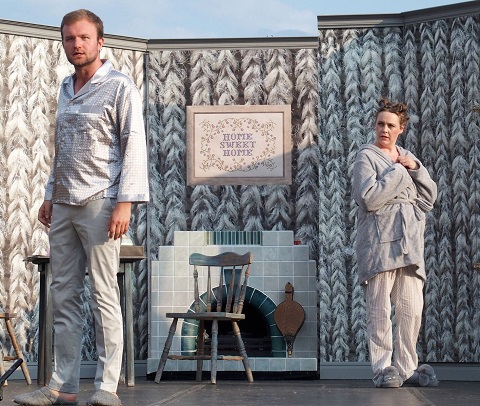 Alistair Ollerenshaw (Baron de Montefiascone) and Aoife O’Sullivan (Clorinde).
Alistair Ollerenshaw (Baron de Montefiascone) and Aoife O’Sullivan (Clorinde).
Despite Cinders’ despondency, Gray uses light and visual motifs to hint that Fate may be kinder than family and elevate the down-trodden lass to higher realms. In the corner of the yard stands a cubist tree offering golden apples, and as Cinders gently plucks the fruit, the branches are bathed in a pink glow which seems to suggest that the future will prove rosy. Indeed, in Act 2 the apples are transformed into magical lanterns which gleam warmly.
But, all good fairy-tales need a fairy-godmother - or, in this case, godfather, in the form of Prince Ramir’s tutor, Alidor (Nicholas Merryweather). Alidor stumbles on to the set cloaked in grubby grey rags and pushing a supermarket trolley filled with an eclectic assortment of oddments - a gramophone, bird-cage, flower-pots, a straw hat - but despite his beggar-disguise, there is no hiding Alidor’s wealth of wisdom and kindness. His royal tutee (Bradley Smith) may be an ingenue as far as romance and courtship are concerned, but just one glance at Cinders sees Prince Ramir smitten, and he can rely on Alidor to concoct a plan to win his bride.
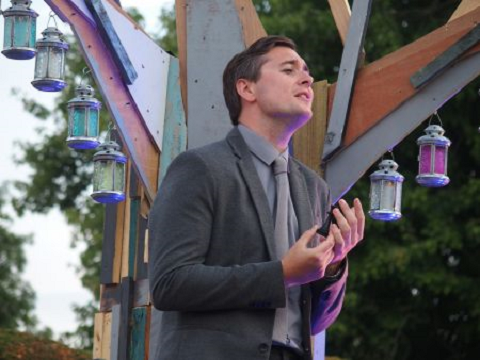 Bradley Smith (Prince Ramir).
Bradley Smith (Prince Ramir).
Gray waves a magic wand - with a little help from a twirling ‘Mary Poppins’ whose umbrella dispenses fairy dust - to transport us to the ball, the grey fronds adorning the Baron’s walls blossoming into a forest of pink roses. Clorinde and Tisbe swap their fluffy slippers for some slinky frocks and set off in hot pursuit of their ‘Prince’, lured by the lurid gold medallion of office sported by one Dandini on his puffed-up chest, leaving Ramir free to woo Cinderella over a game of chess.
 Nicholas Merryweather (Alidor).
Nicholas Merryweather (Alidor).
Isouard really does suggest that the devil has all the best tunes. Simple airs and romances suffice for Cinderella and her Prince, but the two sisters are blessed with characterful duets and a sparkling solo each, proving that virtue and virtuosity are certainly not bedfellows. Aoife O’Sullivan and Jenny Stafford made a wonderfully wicked pair, relishing the capricious coloratura and blending in curlicues of thirds and sixths the melodiousness of which belied the sisters’ malice. O’Sullivan demonstrated a thrilling sparkle and superb precision in Clorinde’s Act 2 show-piece which, designed to catch the Prince’s ear and eye, inspired the ball-goers to fling themselves into a bolero worthy of Torvill and Dean. Tisbe’s rueful lament in Act 3 was no less impressive and, miraculously, even managed to suggest that this harpy had a heart after all.
Nicholas Merryweather always commands a stage; thus, although we are more used to seeing and hearing the baritone in comic guise, he was a masterful mentor, using his strong baritone to convey the maturity and insight that his naïve charges lack. Merryweather also ensured that we heard every word, whether spoken or sung - even when he seemed to be singing with his mouth stuffed full with bananas. Kate Howden’s diction was less clear, but she captured Cinderella’s sweetness and warmth, singing with beautiful tone in her romances with tenor Bradley Smith’s Prince Ramir. I’d like to see both of these singers in roles which offer them greater vocal and dramatic challenges. And, the same goes for tenor Benjamin Durrant, whose Dandini would give Liberace a run for his money, and Ollerenshaw, who had little to sing but who proved a sterling foundation in the ensembles, really making his presence felt vocally. The energy and wit of Lucy Cronin and Susanne Dymott in various choral roles also made a vivid contribution to the whole.
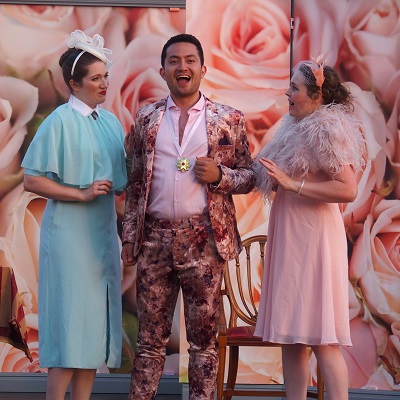 Tisbe (Jenny Stafford), Dandini (Benjamin Durrant), Clorinde (Aoife O’Sullivan).
Tisbe (Jenny Stafford), Dandini (Benjamin Durrant), Clorinde (Aoife O’Sullivan).
Conductor Harry Sever made the most of Isourd’s instrumental colours and the musicians of CHROMA produced a variety of orchestral hues; I particularly enjoyed the nasally windings of the woodwind duets, and there were strong contributions from the horns (Lizzi Tocknell and Richard Bayliss) and harpist Oliver Wass. With the musicians seated behind the set and Sever visible to the cast on two side-screens, it was not surprising that the ensemble occasionally slipped. St John’s Smith Square is not a kind venue for opera, but Gray and his cast did well to overcome the challenges of space and acoustic.
Given the slightness of Isouard’s ‘drama’, we can forgive some occasional hamming in the dialogues and longer ensembles; for there was plenty of sharp wit and neat detail in Gray’s direction and Gilly French’s English translation. Unlike the Brothers Grimm or Charles Perrault, Isouard offers us no dark terrors, political inferences or journeys into the psyche. Simply and sincerely, his music tells a familiar tale, but such is the score’s charm that we’re drawn into a story that we’ve heard so many times before. Goodness triumphs over greed, justice over jealousy. Once again, Bampton Classical Opera have shown us that dreams really can come true.
Claire Seymour
Isouard: Cinderella
Clorinde - Aoife O’Sullivan, Tisbe - Jenny Stafford, Cinderella - Kate Howden, Prince - Bradley Smith, Dandini - Benjamin Durrant, Alidor - Nicholas Merryweather, Baron - Alistair Ollerenshaw, Chorus -Lucy Cronin, Susanne Dymott; Director/Designer - Jeremy Gray, Conductor - Harry Sever, Associate director/Choreographer - Alicia Frost, Costumes - Jess Illif, CHROMA.
St John’s Smith Square, London; Tuesday 18th September 2018.
image=http://www.operatoday.com/Cinders%20and%20Prince.jpg image_description=Isouard’s Cinderella: Bampton Classical Opera at St John’s Smith Square product=yes product_title=Isouard’s Cinderella: Bampton Classical Opera at St John’s Smith Square product_by=A review by Claire Seymour product_id= Above: Kate Howden (Cinderella) and Bradley Smith (Prince Ramir)Photo credit: Bampton Classical Opera (photographs taken at Bampton Deanery, July 2018)
The Royal Opera House lets everyone in on the act
With inviting new entrances, extended foyers and terraces and a new café, bar and restaurant, together with an extensive programme of ticketed and free daytime events, activities and festivals for people of all ages, the Royal Opera House is now, for the first time, open to the public every day from 10am.
At the heart of this project is a brand new Linbury Theatre, the West End’s newest and most intimate theatre, which provides an additional world-class stage for The Royal Ballet, The Royal Opera and a host of internationally celebrated artists and partners. In its inaugural Season, the Linbury Theatre showcases an astonishing range of work, from an 18th-century rarity to 21st-century world premieres - with 25 per cent of seats priced at £25 or less.
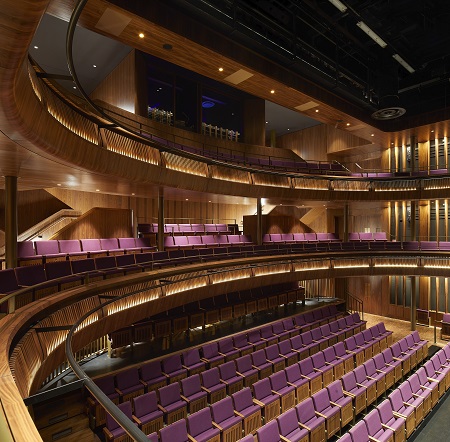 Newly designed Linbury Theatre. Photo Credit: Hufton+Crow.
Newly designed Linbury Theatre. Photo Credit: Hufton+Crow.
The project, designed by award-winning architects Stanton Williams, unites
19th-century grandeur with 21st-century elegance. The new bar and
restaurant provide delicious food and drink in beautifully designed spaces,
and are open to both performance goers and other members of the public.
Chief Executive of the Royal Opera House, Alex Beard, said:
“We are delighted to open the doors to a transformed Royal Opera House,
with our new Linbury Theatre, new entrances, foyers and terraces, a new
café, bar and restaurant and refurbished Clore Studio, as well as an
extensive programme of daytime events, activities and festivals. The Royal
Opera House is now open every day from 10am, and we want as many people as
possible to visit one of the world’s most beautiful theatres, to experience
our art forms and to get a taste of the remarkable creativity at play
here.”
The final construction cost is estimated at £50.7m, with all of the funds raised from philanthropy.
 Royal Opera House Main Foyer. Photo Credit: ROH/Luke Hayes.
Royal Opera House Main Foyer. Photo Credit: ROH/Luke Hayes.
The elegant, newly-created spaces will be brought alive with a year-round daytime programme of events, activities and festivals for audiences of all ages: events will range from workshops demonstrating the magic of backstage theatre crafts to guest artist performances and immersive events. The new front-of-house displays will include stunning costumes charting some famous episodes in the history of The Royal Ballet and The Royal Opera.
The new Royal Opera House Shop, open Monday-Saturday from 10am until after the last interval on a performance evening, and on Sunday 10am-6pm, boasts a diverse range of specially designed products inspired by our theatre and art from some of Britain’s most exciting designers.
image=http://www.operatoday.com/Royal%20Opera%20House%20exterior%20%28c%29%20ROH%2C%20Photo%20by%20Luke%20Hayes%202018%20%281%29.jpg image_description=ROH new exterior product=yes product_title= product_by= product_id=Above: Royal Opera House exteriorPhoto credit: ROH/Luke Hayes
September 18, 2018
A Winterreise both familiar and revelatory: Ian Bostridge and Thomas Adès at Wigmore Hall
Just one of the interpretations of Schubert’s Winterreise offered by Ian Bostridge in an article in the Guardian at the time of the publication of the tenor’s award-winning book, Schubert’s Winter Journey: Anatomy of an Obsession , but one which at times must have felt so relevant to the singer’s own experience of the work. Bostridge has been studying and performing Schubert’s cycle of 24 settings of poems by Wilhelm Müller, which the composer told his friends had ‘cost me more effort than any of my other songs’, for more than 30 years. In more than 100 performances, he has been partnered by many different pianists, sung the work in venues both intimate and vast, made a film of the cycle (directed by David Alden, in 1994), and taken it onto the stage in performances of Hans Zender’s ’composed interpretation’ of Winterreise (1993), complemented by Netia Jones’s video designs, The Dark Mirror .
It is surely a work that Bostridge has ‘lived’, and certainly which he re-lives, physically, psychologically, emotionally, with every fresh performance. And, ‘fresh’ is an apt word, for while Bostridge’s vocal and expressive ‘identity’ is distinctive and striking, his performances of Winterreise traverse a wide emotional spectrum which embraces existential despair, self-lacerating irony, gentle wistfulness and wild delusion with varying degrees of emphasis. I’ve lost count of how many times I have heard Bostridge perform Winterreise. Certainly, I remember, as a student, attending his first solo recital at Wigmore Hall in February 1995, and I have enjoyed countless lieder recitals by the tenor in the subsequent 23 years. Returning to the Hall last night to hear him sing Winterreise once again, partnered by Thomas Adès, I reflected that I too might stand accused of being afflicted by the mesmeric potency of this music and voice.
This performance of Winterreise was a remarkable symbiosis of the familiar and the revelatory. And, the subtle, pining beauties that Adès coaxed from the piano part played no small part in creating a journey which ventured at times into deeply introspective terrain, but which was always richly imaginative. I have heard Adès perform Winterreise with Bostridge several times, writing reviews of their performances at the Barbican Hall in 2015 and, the previous year, at the Aldeburgh Festival in Snape Maltings . Perhaps the expressive diversities and differences between those two performances, just six months apart, should have prepared me for the invention and spontaneity of this recital at Wigmore Hall. It was an enactment of human desolation which was strange, terrifying and captivating in equal measure, and which held me spellbound.
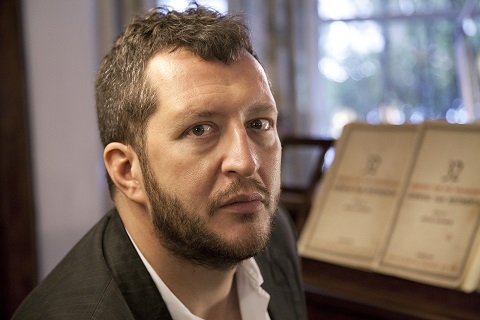 Thomas Adès. Photo Credit: Brian Voce.
Thomas Adès. Photo Credit: Brian Voce.
I don’t think I’ve attended a performance of Winterreise in which I have been so aware of the pianist’s presence - participating in, contributing to, depicting, inciting, reflecting on the wanderer’s psycho-physical journey. I noted, of the duo’s Barbican Hall performance, that ‘the generally restrained dynamics, particularly from Adès, asked us to listen with discernment to the gestural minutiae’, and in the intimacy of Wigmore Hall Adès dared to retreat still further, playing with an astonishingly delicate touch, shaping every utterance with exquisite suppleness.
The wanderer did not so much as step out with a purposeful tread in ‘Gute Nachte’ as float, carried by dreams and memories through the bleak iciness to which he seemed insensible. The piano’s accents were but tender emphases, as if the traveller’s foot had sunk into soft snow, and Adès’s sweet pianissimo faded still further in the second stanza as darkness enveloped the world. Bostridge was at one with this ethereal landscape, his whispered ‘Gute Nacht’ a farewell not just to his beloved, but also to recognisable realities. But, in ‘Die Wetterfahne’ the traveller’s unpredictability immediately revealed itself in the flash of fire with which Bostridge scorned the weather-vane, ‘Da dacht’ ich schon in meinem Wahner,/ Sie pfiff’ den armen Flüchtling aus’ (In my folly I thought it mocked the wretched fugitive). There was a terrible, unhinged quality to the anger.
In song after song, Adès surprised me with the emotive suggestiveness of the slightest of gestures. The pinpoint delicacy of the frozen tears which fall unnoticed in ‘Gefrorne Tränen’ conjured a painful innocence when the traveller realises that he has been weeping; and here, the darkness of Bostridge’s confused low murmuring, ‘Ei Tränen, meine Tränen’, was shocking, all the more so in the light of the deceptive lyricism of the final stanza. This warmth, though, was immediately numbed by the rapid curtailment of the piano’s brief swellings in the introduction to ‘Erstarrung’, and Bostridge’s oscillation between heated avowals and insubstantial musings. The fourth stanza of this song perfectly exemplified Adès’s engagement with the poet-narrator’s journey, the quiet, even circling of the right-hand being underpinned by a sharply defined bass line in which a triplet figure came to the fore, as if literally pushing the wanderer onwards.
But, despite the compelling impetus a pause did come, in a strange vision of the linden-tree which seemed to carry Bostridge away from the present, his voice becoming blanched and eerie as the dangerous rustling branches beseeched, ‘Komm her zu mir, Geselle, Hier findst du Ruh’!’ (Come to me, my friend, here you shall find rest!). The arrival of the cold wind woke us all from such mysteries, and as Bostridge declared, ‘Ich wendete mich nicht’ (I did not look back), the piano seemed almost to disappear. From my seat in the Hall, I could appreciate how closely Adès watched, followed, responded to Bostridge in ‘Wasserflut’ (Flood), in which the tenor emphasised the traveller’s instability and volatility, through startling tonal contrasts. And, again, there was that telling detail from Adès: in the third stanza he seemed to emphasise the difference between the piano’s dotted rhythm and the singer’s triplets (a discrepancy which has been subject to much, unresolved critical debate), lagging behind the vocal line and sharpening the poignancy of the traveller’s address to the snow, ‘Folge nach nur meinen Tränen,/ Nimmt dich bald das Bächlein auf’ (You’ve only to follow my tears and the stream will bear you away).
The languor of some songs created a heavy, wretched woefulness, as when the wanderer confronts the motionless, ice-crusted stream in ‘Auf dem Flusse’ (On the river), and here the indignation of Bostridge’s rhetorical outburst - as the poet-narrator imagines that beneath the stillness a torrent rages, like that in his own heart - was complemented by the tautness of the piano bass trills, the left hand being somehow both melodious and discomforting. The piano emerged slyly from the shadows at the start of ‘Irrlicht’ (Will-o’-the-wisp), and though the poet-speaker declares himself calm, as he makes his way down the dry bed of the mountain stream, there was fear in the rising vocal portamenti of the last stanza and in the piano’s final whispered taunt.
In contrast, I scribbled the word ‘deranged’ in my programme alongside the text of ‘Rückblick’ (A backward glance), and I think that says it all: this traveller seemed to have become detached from the real, and the corporeal, existing ‘somewhere else’ in a world of his own tortured imaginings. In ‘Rast’ (Rest) the juxtaposition of Bostridge’s light head-voice, as he drove on without rest through the storm, and the dense piano left-hand chords deepened this sense of ‘lostness’ still further, and the final pang of anguish which afflicts the traveller’s heart was viciously tense. By ‘Frülingstraum’ (Dream of Spring), both pianist and singer had submitted to an almost psychotic unsoundness, deviating alarmingly between frenzy, desolation and dreaminess. The slowing at the end of this song, which emphasised the clarity of the low piano bass line, seemed to prepare for the weary weight and torpor of ‘Einsamkeit’ (Loneliness); here, single words, ‘Einsam’, ‘Leben’, seemed almost detached from any semantic context, and Bostridge’s voice was bleached of all colour in the wanderer’s concluding reflection on a past when he was not so wretched.
The arrival of the mail-coach brought no promise or joy, Adès’s poundings ringing with indifference: ‘Die Post bringt keinen Brief für dich’ (There will be no letter for you). There was a further pained paring of emotional connectedness in the unisons of ‘Der greise Kopf’ (The hoary head), in the cold simplicity of the piano’s arpeggio-triplets in the prelude to ‘Die Krahe’ (The crow) - as even as a child’s music-box - and in Bostridge’s fragmented address to the ‘wunderliches Tier’, strange creature, whose overhead circling casts a perturbing shade. At the close of the song, Bostridge turned his back on the audience, gazing into the belly of the piano, lost in terrifying absurdity and unease.
It didn’t seem possible that we could descend any further into existential desolation, but we did, and by the time we had travelled from impetuous last hopes (‘Letzte Hoffnung’), through the taunting barking of dogs and rattling of chains in the village (‘Im Dorfe’) and into pure delusion (‘Täuschung’) what was most chilling was the way the supreme control executed by singer and pianist served a seemingly irredeemable irrationality. The proverbial hopelessness of trying to argue with a madman was palpable.
And so it seemed oddly but wonderfully ‘wrong’ that we could admire Adès’s lovely voice-leading in ‘Der Wegweiser’, especially as the sign-post led us only to the essence of human isolation: the slowing, fading declaration of acceptance that the wanderer must travel the one road from which no man has ever returned (‘Eine Strasse muss ich gehen,/ Die noch Keiner ging zurück’). And, that Bostridge, in ‘Das Wirtshaus’ (The inn), could colour so tenderly the traveller’s acknowledgement that the graveyard is to be his place of rest. Adès did not conjure defiance at the start of ‘Mut!’ (Courage!) so much as half-hearted self-encouragement, though there was fierce anger in the final two chords, which almost whipped us with their bitter accents.
I don’t think I’ve ever heard Bostridge sing ‘Die Nebensonnen’ more beautifully, the eloquent decorations of Adès’s introductory phrase inspiring a lyrical gentility which made nihilist submission to darkness and death seem almost consoling. But, should we have been tempted by apparent intimations of solace, Adès revealed our foolishness at the start of ‘Der Leiermann’: the left hand’s upward acciaccatura, which resolves to form the bare fifth of the hurdy-gurdy man’s dirge, here crunched onto the beat, an aggressive and disturbing intrusion - and this was, for once, no pianissimo, but a forceful, sustained expression of contempt and pain. The clanging dissonance of these first two bars, though not stated again, lingered and cast an acerbic shadow over the song, draining the traveller of a life-pulse, even as he marvelled at the organ-grinder’s steadfastness - ‘Dreht, und seine Leier/Steht ihm nimmer still.’ (He turns the handle, his hurdy-gurdy’s never still). The silence - both relief and horror - which engulfed the traveller was absolute.
Claire Seymour
Schubert: Winterreise D911
Ian Bostridge (tenor), Thomas Adès (piano)
Wigmore Hall, London; Monday 17th September 2018.
Photo credit: Sim Canetty-Clarke
Stars of Lyric Opera at Millennium Park, 2018
The first part of the evening was devoted to excerpts from works by Giuseppe Verdi surrounding judiciously chosen selections from operas by Saint-Saëns, Mozart, and Puccini. The second half of the concert featured a selection form Act I and the whole of Act II from Puccini’s La bohème, with which the new season will open on 6 October 2018. The Lyric Opera Orchestra was conducted by Domingo Hindoyan, who will make his debut with the company in the performances of La bohème. The Lyric Opera Chorus was prepared by its Chorus Master Michael Black; the Chicago Children’s Chorus was prepared by Josephine Lee. General Director of Lyric Opera Anthony Freud provided welcoming and introductory remarks along with prefatory commentaries for the musical selections.
After a lyrically gentle and subsequently rousing performance of the overture to Verdi’s La forza del destino, led by Hindoyan with thoughtful precision, vocal selections began with the aria “Eri tu” (“It was you”) from Verdi’s Un ballo in maschera. Baritone Zachary Nelson performed the piece as an evocative reflection on the conflicting emotions of live, presumed betrayal, and hatred. Nelson’s assumption of the character Renato’s persona was evident from the start as he recalled with touching legato the happy days of love presumed lost. The emotional shift focused here on the intonation of “Traditor!” left no doubt of the fury now predominant in Renato’s heart. Nelson’s final, summary line, “O dolcezze perdute, o speranze d’amor, d’amor, d’amor,” (O lost delights, o hopes of love, of love, of love”), was sung with urgency and a gracefully held top pitch to close. In the following, two-part selection from Verdi’s Ernani, bass Adrian Sâmpetrean expressed Silva’s initial lament at finding his niece Elvira the object of unexpected suitors; in the following cabaletta Silva’s determination to exact revenge emerged in rapid melodic ardor. Sâmpetrean’s many roles in bel canto opera make especially suitable his assumption of this part in n early Verdi masterpiece. The voice maintains an attractive vibrato in the middle range, which Sâmpetrean allows to color individual lines distinctly. His credible shift into the cabaletta showed further decorative and dramatic sensitivity in underscoring the character’s text. Later in the first part of the concert the Lyric Opera Chorus performed with gusto and absolute control the “Anvil Chorus” from Il trovatore. Also a treasured Verdian favorite, the Lyric Opera Chorus performed together with soloists Whitney Morrison and Mario Rojas the brindisi “Libiamo” from Act I of La traviata. The timing between Chorus and soloists was comfortably observed and followed the impassioned lead projected by Rojas.
A trio of soloists provided significant interest to the remaining selections before intermission. While taking the place of the regrettably indisposed Elizabeth DeShong, mezzo-soprano J’nai Bridges sang an unforgettably mesmerizing account of the aria “Mon coeur s’ouvre à ta voix” (“My heart opens to your voice”) from Samson et Dalila by Saint-Saëns. The arching lines of this seductive aria were taken with gracefully languid tempos as Bridges emphasized with extended notes key words such as “tristesse” (“sadness”) and l’ivresse” (“intoxication”). Her low pitches on these textual elements communicated an emotional shiver, just as Bridges’s voice rose upward in fervent appeal. This stunning vocal range was then capped by a final “Je t’aime” (“I love you”) taken here piano in intimacy. Danielle De Niese’s Lauretta from Puccini’s Gianni Schichi was a delight of maidenly enthusiasm with vocal flights shading into diminuendo. In her performance of “Placido è il mar: (“Calm is the sea”) from Act II of Mozart’s Idomeneo Ann Toomey’s voice bloomed impressively in phrases alternating with the Lyric Opera Chorus. Toomey’s dramatic top notes are a natural extension of the vocal line, the latter sung here with seamless legato. The decorative embellishments applied to Elettra’s aria were a further revelation in Toomey’s lovingly sculpted version of this Mozartean gem.
The second part of the concert presented excerpts from Puccini’s La bohème sung by the cast that will perform in the new production of this work at Lyric Opera in the next month. Michael Fabiano and Maria Agresta sang Rodolfo and Mimì joined, for Act II, by De Niese and Nelson as Musetta and Marcello. In the roles of the new lovers who discover each other in Act I Fabiano and Agresta fit their parts ideally. As a result, they are able to approach their vocal lines with truly individual color. As Rodolfo Fabiano sings “Che gelida manina” as a natural feeling of the poet who seeks to express the new inspiration of his heart. Likewise, Agresta transforms vocal innocence into a revelation of love’s magic by the close of the act’s duet. In the ensemble of Act II the sprightly yet urgent line performed with melting lyrical beauty by De Niese’s Musetta was a credible balm to the seemingly aloof Marcello. In the latter role Nelson’s voice resonated through the ensemble until both couples were, for now, united.
As a sample of this new production and much of the forthcoming season the evening’s concert provided an exciting introduction with the promise of an enjoyable season to come.
Salvatore Calomino
image=http://www.operatoday.com/Full%20Stars%20of%20Lyric%20Opera%20at%20Millennium%20Park%20Cast_c.%20Todd%20Rosenberg.png
image_description=Stars of Lyric Opera at Millennium Park Cast [Photo © Todd Rosenberg]
product=yes
product_title=Stars of Lyric Opera at Millennium Park, 2018
product_by=A review by Salvatore Calomino
product_id=Above: Stars of Lyric Opera at Millennium Park Cast [Photo © Todd Rosenberg]
September 16, 2018
Classical Opera: Bastien und Bastienne on Signum Classics
Following their vivid staging of the twelve-year-old Mozart’s La finta semplice at the Queen Elizabeth Hall in June this year, Classical Opera’s MOZART 250 journey sees them arrive at another adolescent staging-post, Mozart’s first Singspiel: the one-act pastoral, Bastien und Bastienne, which the company will perform at Wigmore Hall on Tuesday 18th September , and which they have just released on the Signum Classics label .
The scholarly paths to an authoritative score and full appreciation of the derivation of the libretto have been complicated by ambiguities, convolutions and a lack of extant evidence; drawing on recent scholarship by Linda Tyler [1], the source issues are helpfully summarised by artistic director and conductor Ian Page in an informative liner booklet article. The surprise discovery in the 1980s of the ‘lost’ autograph manuscript of Bastien und Bastienne in the Library of Jagiellonian University in Krakow (where it resides as an open-access source) enables Classical Opera to perform Mozart’s original 1768 setting of the libretto by Friedrich Wilhelm Weiskern and Johann Heinrich Friedrich Müller.
The libretto of the artless pastoral parody, the prodigious Mozart’s fourth work for the stage, began life as a French comedie lyrique - Les amours de Bastien et Bastienne - which was presented on 26th September 1753 by the Comédiens Italiens Ordinaires du Roi, with a text by Monsieur and Madame Favarts (who also starred as the eponymous beloveds) and Harny de Guerville. Les amours was itself a parody of Rousseau’s Le devin du village of 1753, which had great success at the Paris Acadèmie Royale de Musique in the second half of the 18th century and early 19th century. The Favarts and de Guerville turned Rousseau’s Arcadian archetypes into real, dialect-speaking peasants, and Les amours was translated into German and set to music by Johann Baptist Savio. Performed in Vienna at the Karntnerthortheater on 5 th May 1764, and in Salzburg in 1766, it was this text which was modified by Weiskern and Müller, with some further tinkling by Johann Andreas Schachtner, a trumpeter at the Salzburg court, and which was set by Wolfgang the Wunderkind in 1768.
Bastien und Bastienne was allegedly commissioned by the Viennese physician and ‘magnetist’ Dr Franz Anton Mesmer (who would later make his own parodic appearance in Così fan tutte) although, as Rudolph Angermüller, the editor of the 1974 Bärenreiter-Verlag Neue Mozart-Ausgabe score, points out, there is no evidence to verity the claims of Georg Nikolaus Nissen (who was married to Mozart’s widow and was one of the composer’s first biographers) that ‘the German operetta Bastien und Bastienne composed by him for the salon theatre of Dr. Mesmer, the well-known friend of the Mozart family, was performed in Mesmer’s garden house in a Vienna suburb’. [2]
Angermüller notes that on 10th January 1768, Mesmer had married Maria Anna von Bosch, the wealthy widow of an Imperial Court Advisor, Ferdinand Konrad von Bosch, and that the garden theatre at the Mesmers’, ‘an open-air theatre cut out of Box hedge’, at the property in the suburb Landstraße that Maria had from her deceased husband, was in 1768 not yet finished.
But, Angermüller keeps an open mind, writing in the Foreword to the Ausgabe score: ‘It is also possible that Nissen … got to know the host of the performance, Dr. Anton Mesmer, or his younger cousin, Joseph, one of the famous educationalists of that time, who could have been at the performance, and learned about it from them. But why then did Maria Anna in 1792 tell the first Mozart biographer, Friedrich von Schlichtegroll, nothing about this performance, at which she must have been present? And then Leopold, who sent news of every success and every advantageous development back to Salzburg, does not inform his Salzburg friends of a performance and its preparation. It must be admitted that Leopold’s letters between 24 September and 12 November 1768 have not been kept. Could he have told of Bastien und Bastienne in these lost letters? If that were the case, a performance in the house of Dr. Anton Mesmer could also have taken place in October, 1768.’
Whatever, the first officially recorded performance of Bastien und Bastienne took place 122 years after its composition, in Berlin on 2nd October 1890 at the Architektenhaus - whether the premiere, or second performance, we cannot reliably determine at present. But, however interesting such details and detours of historical provenance are, I digress. What of the work itself, and of this recorded performance by Classical Opera?
Some have suggested that the theme of the overture, or ‘Intrada’, bears an uncanny resemblance to the principal theme of the first movement of the Eroica; but when you consider that Beethoven’s themes are so often ‘just’ arpeggios and scales, and that here, Page and The Mozartists, led by Matthew Truscott, show how Mozart’s extended arcs above pulsing static strings beautifully capture the dramatic spirit of pastoral romance, then such coincidences seem just that.
The drama is rather slim, as is the musical content: sixteen numbers are interspersed with spoken dialogue. But, Page ensures that things swing swiftly along. I’m not sure that Anna Lucia Richter’s Bastienne sounds convincingly tormented by the anguish of abandonment in her short opening aria - that may be her ‘fault’, or Mozart’s - but she certainly sings with beguiling directness and clarity of line. It’s also an advantage to have a German native in the role as the dialogue speaks true (though there are no weaknesses among the cast of three in terms of the delivery of the spoken text) and the horns’ punctuation of Bastienne’s ensuing declaration of self-solidarity underlines her feisty core, while the strings’ tender tone hints at future capitulations to her heart’s desires.
The same strings make a good job of imitating Colas’s raucous bagpipes, as the Magician descends the hill to alleviate Bastienne’s afflictions and bass-baritone Darren Jeffery’s darkly shining resonance evinces confidence and authority. Whether Colas’s subsequent actions justify such self-assurance is another matter - at times the Magician-cum-Meddler seems to wilfully wind up the woeful Bastienne! - but, his later ‘spell’ is a show-piece of sub-Audenesque lexicographical melodrama, underpinned by vicious nerve-tingling Sturm und Drang exhibitionism from The Mozartists. We are even provided with an Appendix, so that one can hear the aria with the revised text of 1769, should one prefer ‘Diggi, daggi,/Schurry, Murry,/Horum, Harum,/Lirum/Larum’, in place of ‘Tatzel, Brätzel,/ Schober, Kober,/Indig, Windig,/Kuffer, Puffer,’ etc.
As the ‘drama’ unfolds, Richter’s tone does not consistently convey naïve innocence, but the vocal phrases are always eloquent, and dynamic and harmonic nuances are brought to the fore (the role of Bastienne will be taken by Ellie Laugharne at Wigmore Hall). And, Richter’s vocal precision plays a big part in communicating Bastienne’s anger and indignation at her beloved’s predilection for the superficial flattery and material luxury offered by the noblewoman from the castle. Moreover, her lovely ‘siciliano of sincerity’ wonderfully captures her serene acceptance of the rejection dished out by her fickle lover: artful artlessness indeed.
Tenor Alessandro Fisher makes characteristically excellent use of the text in Bastien’s first aria, in which declares that he has seen sense and will return to his beloved Bastienne. How irritating to be told by Comas, as Page’s translation puts it, that he has ‘been given the push’ (Man hat dir den Abschied gegeben). Bastien’s lines lie quite low and sadly we don’t often get the opportunity to enjoy the beauty of Fisher’s dulcet head-voice. But, the tenor conveys a strong feeling of the virility of youthful masculinity, though not without a core of sensitivity. Bastien’s confidence in the neglected Bastienne’s devotion - suggested by the unadorned honesty of Fisher’s declaration, ‘Und wenn sie vor Liebe brennet,/Muß die Glut von mir entstehn.’ (And if she burns with love,/ Must the embers arise from me.) - is simultaneously represented and mocked by the strings’ vibrant scalic flourishes; and, not exactly supplanted but certainly diluted by the simply serenading and urgent declaration of Bastien’s yearning to behold his beloved’s rosy cheeks once more. However, before their reconciliation, we have a wonderfully disingenuous duet of mutual contempt in which Page captures the characters’ dichotomy of emotions in the contrasting pace and mood of the sections within the number.
This disc is ‘filled out’ by Mozart’s Grabmusik which Classical Opera presented at Wigmore Hall in January 2016 . At Wigmore Hall next week, the programme will begin with Haydn’s La Passione Symphony, and Bastien und Bastienne will be complemented by a selection of arias from an anonymous collection of Viennese Comedy Arias from the 1750s, which demonstrate the musical language and style that Mozart deliberately replicated in his 1768 Singspiel.
Classical Opera perform Bastien und Bastienne at Wigmore Hall on 18th September. Ian Page will give a pre-concert talk at 6pm.
Claire Seymour
Anna Lucia Richter (Der Engel (Grabmusik)/Bastienne), Alessandro Fisher (Bastien), Jacques Imbrailo (Die Seele (Grabmusik)), Darren Jeffery (Colas); Ian Page (conductor), The Mozartists.
Signum Classics SIGCD547 [66:24]
[1] Tyler discusses the textual origins and evolution of the opera in ‘ Bastien und Bastienne: The Libretto, Its Derivation, and Mozart’s Text-Setting’, Journal of Musicology, Vol.8, No.4 (Autumn, 1990): 520-552.
[2] Georg Nikolaus Nissen, Biographie W. A. Mozarts (Leipzig, 1828; reprint ed., Hildesheim, 1972), 127.
September 15, 2018
A Stunning Semiramide from Opera Rara
Rossi apparently found the environment creatively advantageous, writing to Giacomo Meyerbeer (with whom he had previous worked on the dramatization of an aspect of the same legend) that Rossini’s home was, ‘Delicious, really, in all its pleasant surroundings: beautiful gardens, a voluptuous small chapel, lake, hills, woods, and a magnificent, elegant house. We’re drafting the outline: he approved all the situations that I had already settled on. He began to compose yesterday’. Work went well, and Rossi later reported, ‘We’ve made an Introduzione a la Meyerbeer […] even Colbran will appear in it. A grand spectacle, an imposing picture’. [1]
Semiramide was the last opera that Rossini wrote for the Italian stage, before he upped sticks for Paris. Richard Osborne describes Rossini’s opera as ‘the apotheosis of the Italian neoclassical style and a consummate example of music's ability to map sensation for sensation's sake … destined to hold the stage for as long as there were singers to sing it.’
Opera Rara certainly has indeed found the ‘singers to sing it’, and we heard them first at the BBC Proms in 2016 , a performance of Semiramide which was, for me, one of the ‘stand-out moments’ of that Proms season. Now, Rossini’s opera has become the first recording to be distributed for Opera Rara by Warner Classics, a partnership which was announced in July this year. Warner Classics have assumed worldwide distribution for Opera Rara recordings and this includes all future recordings as well as Opera Rara’s recent, awarding winning releases - including International Opera Award-winning recordings of Offenbach’s Fantasio and Donizetti’s Les Martyrs .
Semiramide is no conventional seria ‘heroine’: rather a megalomaniac murderer who has assassinated her husband, with the help of her admirer Assure, in order that she can grab the throne of Babylon for herself. However, as Shakespeare’s Gertrude found, mariticide never does run smoothly, and her path to the crown is complicated by her passion for Arsace - who, unbeknown to them both, is her son.
By the end of the nineteenth century, Semiramide had largely disappeared from the stage. When the opera was given its first modern performances on 17th December 1962 at La Scala, it was largely as a vehicle suited to the talents of Joan Sutherland and Giulietta Simionato. It’s a long listen, even by the standards of the early-nineteenth century: without cuts, it runs to roughly three hours and forty-five minutes.
So, who would or should buy this box-set, which includes the libretto in Italian and English, and a detailed, informative, illustrated liner article by Benjamin Walton, alongside four discs comprising nearly four hours of music?
First, anyone who wants to hear terrific bel canto singing by a cast who appreciate that the beauty of the style is the symbiosis of expressive vocalism and dramatic vitality. As the eponymous Queen, Albina Shagimuratova demonstrates far more control over her technique than Semiramide does over her passions, but her effortless coloratura is far from colourless. The Act 1 showpiece, ‘Bel raggio lusinghier’, in which - her spirits lifted by the chirpy woodwind and buoyant chorus of the aria-preface - Semiramide rejoices in the return to Babylon of Arsace, shines with ripples of rapture. The virtuosity dazzles - the shimmering string tremolandos seem to flow from her vocal frissons - but is also affecting. The rhythms are unfailingly vivacious, the phrasing heart-stirring. Sir Mark Elder whips up an instrumental and choral revel which Shagimuratova rides with gleaming glory. The complex, long throne scene that ends the Act is expertly shaped by Elder, and the soprano paces the scene and articulates the text superbly: I can almost believe in her avowal of devotion and service to her people, so thrillingly does she crest the vocal waves with fullness of tone and depth of feeling. Then, we feel the claws of fear - her blood curdles, she cannot breathe - that grip her when her dead husband seems to rise from his tomb: the pounding, accusatory thumps of the orchestra inspire more terror than any director is likely to conjure on stage.
Daniela Barcellona is a sincere Arsace. In her presentation aria, ‘Eccomi alfine in Babilonia’, we sense every ounce of the veneration which infuses Arsace’s soul upon his return to Babylon, believing that his dying ‘father’, Fradate, has sent him there to answer a call from Semiramide, while his heart burns with passion for Azema. His awe is evoked by momentous silences which are emphasised by playing of tremendous clarity by the woodwind and by the violas’ insistent ostinato flutterings, though the strings’ ascending pizzicato and a nasally riposte from the woodwind sound a note of danger. Arsace’s homage to the temple of Baal descends with resonating reverence, Barcellona demonstrating both textual awareness and vocal precision. Her voice overflows with love, and memories of feelings love inspires, in the following cavatina, ‘Ah! quel giorno’: here, the dark colours of her mezzo shine with paradoxical brilliance. Elder keeps things moving along, while giving space for Barcellona to relish the text, to make velvety flights through her melodic range and to demonstrate her command of the coloratura. The latter is also evident in ‘In si barbara sciagura’, in which the vibrant orchestral contribution never ‘accompanies’ but always heightens and complements.
And, in duet, Shagimuratova and Barcellona complement each other wonderfully. In Act 1, when the Queen confesses her love, Shagimuratova’s soprano has a lovely ‘cleanness’ that belies her murderous previous actions, though perhaps the beautiful curlicues and outbursts don’t entirely deceive us even if Arsace duped, submitting to images of peace and joy. Barcellona’s runs and roulades slip by like silk but leave the impression of the plushness of velvet: bel canto at its very best.
Mirco Palazzi’s smooth bass makes him a deceptively spiteful Assur. In his Act 2 duet with Semiramide, in which her guilt leads her to blame and reject her accomplice-assassin, Palazzi’s agile bass resonates with lithe indignation and a piercing resentment founded on truth, ‘Remember … who drove me to treachery’. His threat to rob of her of both her sanity and her throne descends to menacingly purposeful depths, but Assur’s warning that the Queen should fear the shade cast by her husband’s hovering shadow rings purely and with a beguiling warmth and directness which is undoubtedly disturbing, and which makes Palazzi’s subsequent extended descent into insanity even more distressing.
Alongside the central principals, Barry Banks sails through Idreno’s vocal flights with ease, and his Act 2 courtship of Azema, ‘La speranza più soave’, is beautifully shaped, shuddering with passion. The minor roles of Azema, Mitrade, and the high priest Oreo, are stylishly taken by Susana Gaspar, David Philip Butt and Gianluca Buratto respectively. Embedded in the Royal Albert Hall Arena, James Platt cut a disturbing white-suited ‘Ghost of King Nino’, but deprived of the visual context Platt still makes a cavernous impression.
Semiramide gives us Babylonian myth by way of Voltaire, with a dash of Hamlet and Oedipus; the joy of a recording, over a staging, is that we don’t really have to ‘make sense’ of the characters … they can be histrionic and hyperbolic and still sound wonderful. Elder’s ability to craft extended sequences of tension is second to none, and he is ably abetted by the Orchestra of the Age of Enlightenment. The first forty bars of the Sinfonia give us a wonderful taste of what is to come: there are urgent palpitations from the lower strings, from which bursts an explosion of colour. Release follows in the form of the relaxed blend of horns and bassoon, before a flash of fire consumes us with the entry of the full orchestra. The flames are assuaged by the woodwind but dancing pizzicato dialogues in the strings keep the embers smoking. It’s hard to believe that just a few minutes have passed, so many emotions have we traversed. And, as we proceed the musical landscape is never settled emotionally, but always perfectly structured and executed. Detail and diversity serve the drama, to an effect which is both immediate and slow-burning.
So, to return to my earlier question, who should buy this Opera Rara recording? Lovers of Rossini, of beautiful and dramatic singing, but also those interested in history and legend - mythic, operatic or otherwise.
2019 will see the release of Opera Rara’s recording of Donizetti’s L’Ange de Nisida, which received its world premiere at the Royal Opera House under Sir Mark’s baton, in July this year. Before that, on 21st November, Opera Rara will present the original version of Puccini’s one-act Le Villi , the composer’s first stage work, at the Royal Festival Hall; this performance will unite Ermonela Jaho - the star of Opera Rara’s first foray into verismo territory, Leoncavallo’s Zazà - with American baritone, Brian Mulligan, and the young Armenian tenor, Arsen Soghomonyan. Le Villi will subsequently be recorded for release by Warner Classics.
Claire Seymour
Rossini: La Semiramide (recorded at the Henry Wood Hall, August/September 2016)
Albina Shagimuratova (Semiramide), Daniela Barcellona (Arsace), Mirco Palazzi (Assur), Barry Banks (Idreno), Gianluca Buratto (Oroe), Susana Gaspar (Azema), David Butt Philip (Mitrane), James Platt (L’ombra di Nino); Sir Mark Elder (conductor), Orchestra of the Age of Enlightenment & Opera Rara Chorus.
Opera Rara, ORC57 [4 CDs: 66:48, 65:18, 63:16, 36:21] image=http://www.operatoday.com/OperaRara%20Semiramide%20recording%202018.jpg image_description=Rossini:Semiramide. Opera Rara: Sir Mark Elder and the Orchestra of the Age of Enlightenment. product=yes product_title=Rossini:Semiramide. Opera Rara: Sir Mark Elder and the Orchestra of the Age of Enlightenment product_by=A review by Claire Seymour product_id=Opera Rara ORC57 [4CDs] price=£44.87 product_url=https://amzn.to/2xpwdaTSeptember 14, 2018
Dorothea Röschmann at Wigmore Hall: songs by Schumann, Wolf and Brahms
The patent sincerity of Röschmann’s singing - not to imply anything other than sincerity about Martineau’s! - was evident from the very first of the late Gedichte der Königin Maria Stuart, ‘Abschied von Frankreich’. Its deceptive simplicity was not exactly mirrored but perhaps paralleled in the figures almost, yet never quite, remembered from the piano music in Martineau’s part. These are not quite fragments, late though they may be; nor are they anything like so disturbing as the Gesänge der Frühe, op.133, for piano solo, which I find almost impossible to listen to.
There is certainly something suggestive of the fragment too them, though, not least as a reaction to a bare-bones simplicity (sometimes) that itself proves suggestive of a (mis)remembered Bach as chorale writer. Certainly the tension evoked between ritual and expression in ‘Nach der Geburt ihres Sohnes’ brought Schumann’s Leipzig predecessor to mind, as did the rock-solid, continiuo-like piano part to the closing ‘Gebet’. If that were the church as rock of St Peter, Röschmann suggested a more emotional disciple: imploring, trustful, and in the last place visibly, audibly moved, just as she had been in the preceding ‘Abschied von der Welt’. Wagner, the only one of these three to have been born in Leipzig, came to mind not only in the vocal line, but also in the arioso-like piano writing - at least in this performance - of ‘An die Königin Elisabeth’, the colour of Röschmann’s lower range both lacerating and comforting; ‘Doch des Schicksals Walten zerriesst das Segel oft, dem wir vertraut.’
An expansive, almost Straussian vocal account of ‘An eine Äolsharfe’ opened the selection from Wolf’s Mörike-Lieder. Repetitions of the words ‘wie süss’ were operatic in the best sense, at least so far as Lieder-singing is concerned: alert to a drama that needed no stage. Ghosts of Schubert and Wagner - composers far too little considered together - haunted ‘Das verlassene Mägdlein’; indeed, Schoenberg, in one of his many synthetic not-quite-reconciliations came to mind too. Intervals proved properly generative, Webern within an aural stone’s throw. Relief and instability characterised ‘Erstes Liebeslied eines Mädchens’. Each song was unquestionably considered on its own terms, yet formed part of a programme too: following on, contrasting, questioning. And so, when the opening of ‘Denk es, o Seele!’ seemed reminiscent of ‘Das verlassene Mägdlein’, it was equally important for it to proceed as it did, very much in its own way, albeit mediated by the experience so far. ‘Verborgenheit’ offered a dark, almost operatic climax to the set that yet offered something of necessary or at least anticipated reconciliation: again not entirely unlike Schoenberg.
The second half was given to Brahms. Alte Liebe’s simplicity was apparent - until one listened to the piano harmony: never exaggerated, yet ever so telling. A noticeably later (1888 to 1876) Auf dem Kirchhofe suggested that special vehemence one often hears in the late piano pieces, its Bach allusion poignant on many levels; we were reminded once again just how much the entire German musical tradition owes to the Lutheran chorale. Röschmann’s evocation of life surging through the veins as the moment of transformation in Unbewegte laue Luft suggested, not inappropriately, the ‘namenlose Freude’ of Fidelio, whilst the early Liebestreu (1853) sounded intriguingly close to a recollection of Senta’s Ballad that yet ended in soft-spoken (sung) tragedy. Meine Liebe ist grün and Wir wandelten both did - and expanded upon - what their titles and poems suggested, both seemingly preparing for the moments of frozen time experienced in Nachtigall .
A final Von ewiger Liebe seemed to want to return to the earlier world of Schumann, yet could not, exploring instead its own, beautifully judged melancholic passion: echt-Brahms. And yet, was that just a hint of proto-Mahlerian irony? Or was that just me? We were left to wonder - and indeed to desire more, which we received in two finely contrasted encores: Schumann’s Die Lotosblume, in which a similar tension between the ironic (Heine) and the sincere (Schumann) was to be heard, and reconciliatory Liszt, in the guise of Es muss ein Wunderbares sein.
Mark Berry
Dorothea Röschmann (soprano) and Malcolm Martineau (piano)
Schumann: Gedichte der Königin Maria Stuart, op.135; Wolf: Mörike-Lieder: ‘An eine Äolsharfe’, ‘Das verlassene Mägdlein’, ‘Erstes Liebeslied eines Mädchens’, ‘Begegnung’, ‘Denk es, o Seele!’, ‘Auf ein altes Bild’, ‘Verborgenheit’; Brahms: Alte Liebe , op.72 no.1, Auf dem Kirchhofe, op.105 no.4,Der Tod, das ist die kühle Nacht, op.96 no.1,Unbewegte laue Luft, op.57 no.8, Liebestreu, op.3 no.1, Meine Liebe ist grün, op.63 no.5, Wir wandelten, op.96 no.2, Nachtigall, op.97 no.1, Von ewiger Liebe, op.43 no.1. Dorothea Röschmann (soprano)/Malcolm Martineau (piano).
Wigmore Hall, London, Monday 10 September 2018.
image=http://www.operatoday.com/DR%20Harald-Hoffmann.jpg
image_description=Dorothea Röschmann
product=yes
product_title= Dorothea Röschmann (soprano) and Malcolm Martineau (piano) at Wigmore Hall
product_by=A review by Mark Berry
product_id=Above:
Photo credit: Harald Hoffmann
September 13, 2018
Two of Garsington Opera's 2018 productions to reach a wider audience
Garry Walker conducts with a cast that includes Grant Doyle (Enric), Susan Bickley (Carmen), Alan Oke (Rookie), Sam Furness (Gaspar), Lauren Zolezzi (Nuria), Ben Edquist (Remo), Claire Wild (Caridad) and Louise Winter (Pilar) with the Garsington Opera Orchestra. The production was directed by Stewart Laing.
Before that, on Friday 14 September at 19.00, Garsington Opera’s production of Mozart’s final opera Die Zauberflöte , directed and designed by Netia Jones will be available online for free on OperaVision for six months at https://operavision.eu/en/library/performances/operas/magic-flute .
This colourful and quirky new production features Louise Alder (Pamina) winner of the Dame Joan Sutherland Audience Prize at the 2017 BBC Cardiff Singer of the World. The cast includes Benjamin Hulett (Tamino), Jonathan McGovern (Papageno), James Creswell (Sarastro), Sen Guo (Queen of the Night) and Adrian Thompson (Monostatos). The Three Ladies are sung by Katherine Crompton, Marta Fontanals-Simmons and Katie Stevenson. Christian Curnyn conducts with the Garsington Opera Orchestra and Chorus.
image=http://www.operatoday.com/Garsington%20Logo.jpg image_description= product=yes product_title= product_by= product_id=
September 12, 2018
The Path of Life: Ilker Arcayürek sings Schubert at Wigmore Hall
I first heard Istanbul-born, Austrian tenor Ilker Arcayürek at Easter this year, when he performed J.S. Bach’s St. John Passion with the Academy of Ancient Music at the Barbican Hall. On that occasion, I admired Arcayürek’s effortless lyricism which, as if loaded like honey on a gilded painter’s brush, also infused this all-Schubert recital at Wigmore Hall. Arcayürek displayed a beguilingly easeful delivery of both text and melodic line: he clearly had lots of power in reserve, but for the most he kept it there, focusing our attention instead on the naturalness of his vocal expression. The tenor has a direct gaze and an earnest desire to communicate, without mannerism or artifice; in fact, it was perhaps a pity that he did not perform these songs from memory, particularly as the music stand and score seemed largely redundant. Accompanist Ammiel Bushakevitz has a similarly relaxed, unfussy manner. His relaxed differentiation of the different strands within the piano textures, and their relative import, made a considerable contribution to the full gamut of emotions and experiences encountered this ‘Path of Life’.
The recital was divided into two parts, eight single songs prefacing the 20-minute ‘Einsamkeit’. Bushakevitz’s introduction to ‘Fischerweise’ burbled insouciantly, a fitting opening for this carefree work-song (we heard Schubert’s 2nd version, Op.96 No.4), though some telling rubatos and subtleties infused it with an artistry more elevated than one might expect of a fisherman’s ditty. ‘An Silvia’ was similarly untroubled, though again, not without thoughtful communication of the text. After the dreamy softness of the poet’s second-stanza reflections on his beloved’s gentle child-like charm, the final stanza was more forthright and purposeful in its resounding dedication of the song to Sylvia’s honour, and Bushakevitz’s Mozartian clarity kept over-sentimentality at bay.
In ‘Der Wanderer an der Mond’ we enjoyed the beautiful warmth of Arcayürek’s tenor as it rose to question the moon, ‘Was mag der Unterschied wohl sein?’ There was attentiveness to the expressive details of the text here, too, the tenor’s precisely rolled ‘r’ - ‘Wir wander Beide rüstig zu’ - furthering the currents of the piano’s rippling chords, and conveying the briskness of the poet’s journey through the night with his lunar companion. Bushakevitz complemented such nuances, neglecting not the smallest dynamic gesture or harmonic colouring, as the piano’s gentle rhythmic fluctuations created an ambiguous balance between irony and innocence. In contrast, ‘Atys’ unfolded like a heavy, burdensome sigh. Occasionally Arcayürek had a tendency to throw away the last word or syllable of a phrase, which weakened the intensity of the rhymes, but there was effective rhetorical energy in the central section, ‘Ich liebe, ich rase, ich hab sie gesehn’ (I live, I rage, I have seen her) etc., and the tensions of the major/minor alternations with the return of the main melody were expressive.
I found some of the central songs in the sequence a little too slow, and although the mood of dream-like rapture evoked by Bushakevitz’s refined rhythmic freedom and Arcayürek’s dulcet head-voice in ‘Sei mir gegrüsst’ (I greet you) produced a lovely wistfulness, the slow tempo also drew attention to the imprecision of the articulation of some of the poet’s rhymes, and Arcayürek lost his way a little through the chromatic twists and turns. The piano bass resonated with melancholy weight in ‘Wehmut’, from which the light tenor line floated, detached from the world, lost in forlorn musing. Again, though, I thought that the languorous tempo weakened the impact of the harmonic journey, and the expressive shifts between major and minor modes; it also made it more of a challenge for Arcayürek to centre the pitch, particularly when beauty vanished and passed away at the close (‘Entschwindet, und vergeht’).
The steady tempo suited ‘Der Wanderer’ however, emphasising Bushakevitz’s discerning ebbs and flows and Arcayürek’s attentiveness to the text: the ardency of his cry, ‘Wo bist du?’, was complemented by the piano’s repeating triplets which created a strong onward narrative yet were also laden with emotion. The changing moods of the stanzas unfolded persuasively, and the piano’s delicate, suspended final cadence became the persistent whisper that tortures the poet: ‘Dort, wo du nicht bist/ dort ist das Glück!’ (There, where you are not, there fortune lies!’)
This was truly beautiful singing, though perhaps still an interpretation-in-progress. The crafting of the vocal line’s appoggiaturas, the intended effect of the different notation employed for the rhythms of tenor and piano (do Schubert’s dotted and triplet rhythms denote the same thing?), the balance between loveliness and narrative: further reflections on such matters will surely follow and deepen Arcayürek’s performance. With the appearance of the ‘Geisterhauch’ (ghostly whisper), Arcayürek dropped only an octave from the question, ‘Wo?’, but the deep plummet to a low G# surely emphasises the poet’s weary, anxious despondency. However, such tiny concerns were pushed aside by the easy mellifluousness of ‘Litanei auf das Fest aller Seelen’ (Litany for the Feast of All Souls) which, lying fairly low in the tenor’s range, showcased the gentleness of the vocal rises; there was a consoling warmth here and it was a pity that we heard only two of the poet’s seven stanzas.
And so, the path had taken us to ‘Einsamkeit’. I felt that Bushakevitz played too freely with the rhythm of the piano introduction, rushing through the semibreves and distorting the mood of the opening verse in which the poet-speaker yearns for the solitude which will serve as a sacred refreshment to his spirit. But, the threat of mental disintegration which follows was powerfully conveyed and the accumulation of tension and pace as the stanzas progressed was well controlled. Perhaps the silent pause which follows the easing back preceding the return of melancholy might have been just a little longer - the sort of risk-taking that pushes the emotive power of the setting further still - and the agony of the pain of longing even more piercing? Arcayürek wonderfully conveys enraptured introspection but the anguished suffering of Schubert’s wanderers is less persuasive.
If I were to venture any ‘criticism’, it would be that this recital was all just too achingly beautiful -though, I confess, this is hardly cause for complaint, and (as regular readers of this journal will know), my own preferences tend towards the bitter, burning distortions and troughs of despair of the interpretations of Ian Bostridge. Arcayürek and Bushakevitz clearly enjoyed their lunchtime visit to Wigmore Hall, as did the warmly appreciative audience. Arcayürek grew up in the district of Vienna in which Schubert died, and his encore, ‘Wandrers Nachtlied II’, showed his instinct for the Schubertian alliance of freshness and vulnerability - something I would be very happy to hear again.
Claire Seymour
The Path of Life : Ilker Arcayürek (tenor), Ammiel Bushakevitz (piano)
Schubert: ‘Fischerweise’, ‘An Silvia’, ‘Der Wanderer an den Mond’, ‘Atys’, ‘Sei mir gegrüsst’, ‘Wehmut’, ‘Der Wanderer’ D493, ‘Litanei auf das Fest aller Seelen’, ‘Einsamkeit’.
Wigmore Hall, London; Monday 10th September 2018.
image=http://www.operatoday.com/Ilker_Arcay%2B%2Brek_38_-%C2%AE_2017_JaninaLaszlo%5B1%5D%20%281%29.jpg image_description= product=yes product_title=Ilker Arcayürek (tenor) and Ammiel Bushakevitz (piano), BBC Radio 3 Lunchtime Concert at Wigmore Hall, 10th September 2018 product_by=A review by Claire Seymour product_id= Above: Ilker ArcayürekPhoto credit: Janina Laszlo
September 11, 2018
Heine through Song: Florian Boesch and Malcolm Martineau open a new Wigmore Hall season
The re-commencement of cultural calendars and customs can be reassuring. But, in fact this recital was far from a routine affair, not least because I doubt that many in the capacity audience were familiar with the lieder of Robert Franz (1815-1892), nine of whose songs opened this concert in which the work of Robert Schumann served as a landing light. Moreover, one of the intriguing aspects of this thoughtful programme was the opportunity that it provided to compare settings of the same text by different composers, either as presented side-by-side, or as recalled from oft-visited memories. And, the relationships intimated by the programme were in no way arbitrary. Franz, who by 1842 had become director of the Singakademie in Halle, where he organised choral festivals, sent his first book of songs to Schumann, who published it in 1843 having written a detailed and favourable review of the edition in his Neue Zeitschrift für Musik. Franz Liszt, who was later one of Franz’s influential supporters, published his own book about Franz in 1872.
The lied was the sole outlet for Franz’s compositional creativity. Born in Halle in 1815, he composed more than 300 songs. If the nine songs presented here are a good benchmark, then Franz’s predominantly strophic songs don’t run a gamut of emotions and moods. Indeed, the composer himself professed, ‘My Lieder are not meant to create excitement but rather peace and calm’. But, they display consummate crafting of small-scale poetic canvases, never melodramatic, always discretely appropriate to the sentiments of the text.
And, the songs have a compelling fluency, which Boesch and Martineau emphasised by flowing briskly segue through the songs. Perhaps, in fact, it might have been nice occasionally to have had a little time to pause and take in the perfume of each individual song; and, a similar forward impetus characterised the whole recital, Schumann’s ‘Belsazar’ closing the first half almost as an appendix to the final song of the Liszt sequence, ‘Loreley’, and Leiderkreis racing onwards from the six songs by Schumann that commenced the second half. Even within songs, there was infrequently room for ponderance upon changes of emotional direction; we were carried on a magic carpet that offered vistas of diverse terrain but did not rest to take in the view of the fluctuating Romantic landscapes.
But, to return to Franz’s lied, these were delivered from the first with striking directness, definition and focus. Boesch’s baritone is a mighty beast, but when the poet-speaker reflected, “Wenn ich in deine Augen seh’,/ So schwindet all mein Leid und Weh’ (When I look into your eyes, all my pain and sorrow vanish), it sank low in wonder and diminished to a spine-tingling breath-whisper; Martineau, unfailingly refined, relayed the urgency of ‘Ich will meine Selle tauchen’ (Let me bathe my soul) with a wonderfully light touch. ‘Im Rhein’, shone with nobility and reverence, while ‘Am leuchtenden’ (One bright summer morning) evinced, first, breezy relaxation, then, as Boesch made expressive use of his head voice, the pathos of nature which weeps at man’s foolishness. Martineau’s piano accompaniment was an eerie Will-o’-the-wisp in ‘Ich hab’ im Traum geweinet’ (I wept in my dream), and in this song much was made of dynamic contrasts and of the drama supplied by the motivic drama.
Not surprisingly there was greater sensuous and impassioned rhetoric in the sequence of lieder by Liszt. The bitterness of ‘Vergiftet sind meine Lieder’ (My songs are filled with poison) was quite shocking, the bizarre twistings of the piano playout adding further painful contortions to the singer’s angry, declamatory sneer, somehow simultaneously ironic and honest: ‘Ich trage im Herzen viel Schlagen,/ Und dich, Geliebte mein’ (Many serpents dwell in my heart,/ and you, beloved, too). In contrast, ‘Ein Fichten baum steht einsam’ (A spruce tree stands lonely) sank low in contemplative inscrutability, while the unusual melodic perambulations of ‘Du bist wie eine Blume’ (You are like a flower) were sung pianissimo as if transfixed. This song whetted the appetite for Schumann’s setting of this song, which would follow the interval. Indeed, both the Franz and Liszt sequences were punctuated at the close with a song by Schumann, serving as signposts to the second half of the recital when the composer would be placed exclusively in the spotlight. Appropriately, ‘Abends am Strond’ (Evening by the sea) was sung with carefully measured sentimentality while, later, ‘Belsazar’ rang with dramatic colour and clamour, the text made vivid, almost ‘tactile’ in its terror, the piano accompanied tumbling riotously.
The high drama, though, never excluded subtlety, and the performers’ control of tone, timbre and dynamic was even more strongly felt in the later Schumann songs, dating from 1840-41 - a time in Schumann’s life when elation and despondency must have seemed his mutual friends, the ecstasy of his love for Clara competing with despair and frustration that her father would not allow them to marry. Martineau’s tender, touching playout to ‘Die beiden Grenadier’ (The Two Grenadiers; from Romanzen und Balladen II Op.49) was an eloquent, soulful statement of the French prisoner-of-war’s unwavering dedication to his Emperor and its delicacy prepared perfectly for the first flower-song of Myrten Op.25, ‘Die Lotosblume’. Here, though the melody is simple, Boesch found much nuance in the fragmented line, and the piano’s startling change of harmonic direction with the line ‘Der Mond, der is ihr Buhle’ (The moon is her lover) plunged us into nocturnal raptures. But, Schumann’s lachrymose inclinations returned until the ‘solitary tear’ of ‘Was will die einsame Träne?’ dissolved, a mere memory of disappointed love; and, the ironic wistfulness of ‘Du bist wie eine Blume’, contrasted starkly with the ethereal idealism of Liszt’s setting. The star of ‘Es fiel ein Reif in der Frühlingsnacht’ (There fell a frost one night in spring) sparkled with magical softness.
And, so, on to Liederkreis - the Op.24 set, heard less frequently than the Op.39 collection of Eichendorff settings that Schumann began four months later. The nine poems drawn from the ‘Junge Leiden’ (Youthful sorrows) section of Heine’s Buch der Lieder must have seemed to express the composer’s own longing for a lover who is just out of reach, and Boesch and Martineau conveyed every fluctuation of emotion felt by the poet-narrator, from his somnolent rising (‘Morgens steh’ ich auf und trage’) - the lazy rubato here was delicious authentic - through the shifting kaleidoscope of love’s dramas, to the tired stoicism of ‘Anfangs wollt’ ich fast verzagen’ (At first I almost lost heart).
The performers’ ability to keep the narrative pushing onwards, even when quietly taking us into their confidence at moments of intimacy, was notable. Thus, after the agitation of ‘Es treibt mich hin’ (I’m driven this way) had spilled into the angry piano postlude, the harmonic suspensions of ‘Ich wandelte under den Bläumen’ (I wandered among the trees) transported us into the melancholy of the mysteries which trouble the meandering poet, only for the piano’s dry hammerings in ‘Lieb Liebchen, leg’s Händchen’ (Lay your hand on my heart, my love) to snap us back to the grim reality of death as the carpenter fashions the poet’s coffin. Boesch’s wonderfully mellifluous rendition of ‘Schöne Wiege meiner Leiden’ did not neglect the almost insane wretchedness of thwarted love, a desperate anguish which overflowed into Martineau’s dark farewell, which was a veritable narrative in itself.
There was a lovely give-and-take within the rolling phrases of the barcarolle, ’Berg und Burgen schau’n herunter’ (Mountains and castles look down), which temporarily assuaged the violence of ‘Warte, warte, wilder Schiffmann’ (Wait, O wait, wild sailor). And, a similar rhythmic flexibility captured the ambiguous oscillation between expectation and resignation of the final song, ‘Mit Myrten und Rosen’; here, Boesch’s tender head-voice - ‘Doch auf neu’ alte Glut sie belebt,/ Wenn der Liebe Geist einst über sie schwebt’ (But the old glow shall revive them again, when one day Love’s spirit floats over them) - trembled with the beauty of fragile hope, as if the poet barely dared to believe.
Finally, two encores, from Dichterliebe, offered a microcosm of the recital’s wonderfully persuasive wanderings amid the emotional extremes of a poet’s love: ‘Hör’ Ich das Liedchen klingen’, in which the beloved’s song makes the poet’s breast burst with ‘wild affliction’, and ‘Ein Jungling liebt ein Mädchen’, which dismissed Love’s capriciousness with a swift swipe of insouciant sarcasm.
Claire Seymour
Florian Boesch (baritone), Malcolm Martineau (piano)
Robert Franz - ‘Im wunderschönen Monat Mai’ Op.25 No.5, ‘Die Rose, die Lilie’ Op.34 No.5, ‘Wenn ich in deine Augen seh’’ Op.44 No.5, ‘Ich will meine Seele tauchen Op.43 No.4, ‘Im Rhein’ Op.18 No.2, ‘Hör ich das Liedchen klingen’ Op.5 No.11, ‘Am leuchtenden Sommermorgen’ Op.11 No.2, ‘Ich hab’ im Traum geweinet’ Op.25 No.3, ‘Allnächtlich im Traume’ Op.9 No.4; Robert Schumann - ‘Abends am Strand’ Op.45 No.3; Franz Liszt - ‘Ein Fichtenbaum steht einsam’ S309, ‘Du bist wie eine Blume’ S287, ‘Im Rhein, im schönen Strome’ S272/1, ‘Vergiftet sind meine Lieder’ S289, ‘Loreley’ S273; Robert Schumann - ‘Belsazar’ Op.57, ‘Die beiden Grenadiere’ Op.49 No.1, Three lieder from Myrthen Op.25 (‘Die Lotosblume’, ‘Was will die einsame Träne?’, ‘Du bist wie eine Blume’), ‘Tragödie’ Op.64 No.3, Liederkreis Op.24.
Wigmore Hall, London; Saturday 8th September 2018.
image=http://www.operatoday.com/Lukas%20Beck.jpg image_description= product=yes product_title=Florian Boesch (baritone) and Malcolm Martineau (piano), Wigmore Hall, 8th September 2018 product_by=A review by Claire Seymour product_id= Above: Florian BoeschPhoto credit: Lukas Beck
September 10, 2018
Elgar Orchestral Songs - SOMM
Elgar's genius for oratorio, and large scale works for orchestra and voice somewhat eclipse his ventures in art song, apart from the masterpiece Sea Pictures, and the more recently acclaimed Fringes of the Fleet. Those who have treasured SOMM's first collection of Elgar songs for voice (with Catherine Wyn-Rogers, Christopher Maltmann, Neal Mackie and Malcolm Martineau) will seek this out, for they make good companion pieces. In any case, there are some real treasures here, such as Elgar's Song Cycle op 59 which deserves greater appreciation. Heartfelt thanks to SOMM Recordings for bringing this back into the repertoire.
The first disc in this 2 CD set (offered at the price of one) features Elgar's Song Cycle op 59 and his Two Songs op 60 plus Pleading, The King's Way, Follow the Colours and incidental music to Grania and Dairmid. The soloists are Kathryn Rudge and Henk Neven, with Barry Wordsworth conducting the BBC Concert Orchestra.
Elgar's Song Cycle op 59 was initially planned as a set of songs to texts by Gilbert Parker, a Canadian born novelist who was later to be knighted for services to Britain during the 1914-18 war. "O soft was the song", "Was it some golden star?" and "Twilight” are tender, and almost elegaic. They were written for a concert in memorial of A J Jaeger, Elgar's friend, whom he immortalized in the Enigma Variations. Henk Neven's burnished timbre gives them personal, intimate warmth.
The cycle develops to a high point with "The Wind of Dawn", initially written in 1888 to a poem by Alice, before she and Elgar were married. In its original form it was a song for voice and piano. In the bolder orchestration the strings surge, suggesting heaving passion, since the text is daringly erotic, for the era. The full orchestra rises to expansive crescendo, the mezzo (Kathryn Rudge) soaring above. It is a song worthy of Sea Pictures, and indeed, the imagery includes references to "the sea stream'd red from the kiss of his brow". A pity it was created after Sea Pictures had made its mark. It would be interesting to speculate why Elgar concluded this cycle - for it is a cycle - with "The Pipes of Pan". the words are by Adrian Ross who wrote hits for musical theatre, though this text refers to Greek mythology. But Pan is the god of fertility and robust disorder, a shepherd whom polite society cannot contain. Pan is a musician, too,who plays his pipes and enchants those who pay attention. This song therefore connects to "The Wind at Dawn", with its fulsome sense of adventure. Ever enigmatic, Elgar could be making cryptic links between himself and his muse Alice, thus affirming the joy of life even at a time of sorrow.
More secret humour in the Two Songs op 60 — poems purportedly by Pietro D'Alba, who was in fact young Carice's pet rabbit. The words are Elgar's own, and whimsical, the composer claiming that they were folk tunes from "Leyrisch-Turasp, 1909", a place which doesn't exist. Nonetheless, the fantasy gave Elgar a chance to write florid mock-Slavic drama, crashing climaxes blending with delicate expressiveness.
Pleading op 48 is a reverie which might suggest Richard Strauss in autumnal mood, but we're back to exuberance with Follow the Colours: a Marching Song for Soldiers written for the Royal Albert Hall's Empire Day in 1908. The text, by a military officer, is jingoistic, but Elgar seems to relish the opportunity with high spirits. The deliberately four-square rhythm evokes images of "Thousands, thousands of marching feet" stomping mindlessly in strict formation. Thus The King's Way isn't as banal as it might seem on the surface. It surges forth with almost parodic expansiveness. "Let every voice in England say - God keep the way by night and day - The King of England's Way!" But the poem - again by Alice, who must have had a sharper mind than she gets credit for, refers explicitly to the "newest street in London town - the Kingsway which had recently been constructed. destroying older parts of London in the process.
William Butler Yeats and George Moore collaborated on the play Grania and Diamid, a Celtic Revival tale of ancient Ireland. Elgar sets the Introduction with dark, brooding chords which suggest forests and mysterious forces. Hunting horns are complemented by harps, for this is an Irish, not a Teutonic Wagner saga. "There are seven that pull the thread" is a keening song of mourning, with lush harps and strings, written for low female voice. It's Elgar, but he doesn't seem to have been much taken by it.
The second disc in this set features eleven songs for voice and piano (Nathalie de Montmollin, Barry Collett) which have not previously been recorded. They are enjoyable, but the first disc, with the orchestral songs, is the one to focus on.
Anne Ozorio
image=http://www.operatoday.com/SOMMCD271-2-cover-hires-1024x1024.jpg
image_description=Edward Elgar: The Hills of Dreamland - orchestral songs. Kathryn Rudge, Henk Neven, Barry Wordsworth, BBC Concert Orchestra.
product=yes
product_title=Edward Elgar: The Hills of Dreamland - orchestral songs. Kathryn Rudge, Henk Neven, Barry Wordsworth, BBC Concert Orchestra.
product_by=A review by Anne Ozorio
product_id= SOMM Recordings SOMM CD2712 (2 CDs) (£11.64)
Prom 74: Handel's Theodora
Certainly, connoisseurs among his own circle spoke favourably of the oratorio. The Fourth Earl of Shaftesbury wrote to Handel’s friend James Harris, on 24th March 1750: ‘I have heard [Theodora] three times, and venture to pronounce it, as finished, beautiful and labour’d a composition, as ever Handel made.’ But, he added, ‘The Town don’t like it at all’. [1] It was one of Handel’s biggest flops. The first performance on 16 th March 1750, at the Theatre Royal Covent Garden, was followed by only two further performances that season (audiences were so poor that Handel undertook radical revisions), and one further single-performance revival in 1755.
The libretto by Thomas Morell takes us to 4th-century Antioch, where the Roman governor, Valens, has proclaimed that in celebration of the Emperor birthday all citizens must make sacrifice to Jove and join in a feast to the Emperor’s honour. In facing the threat of death for her refusal to abide by Valens’ decree, the Christian princess Theodora displays religious fidelity, personal integrity and steadfast bravery which are equalled by the Roman soldier Didymus who, loving Theodora, pleads for clemency and then attempts to save her by sacrificing himself in her place.
Why did this composition by the man who during the 1730s and ‘40s had single-handedly developed the unique form of the English oratorio, combining elements from Italian opera seria, English anthems and other forms, which such public and financial success, fall so flat on public ears? Various reasons have been proposed: the preachy moralising and solipsistic self-righteousness of the one-dimensional characters, the lack of ‘action’, the unfashionably tragic ending. With regard to the latter, Ruth Smith (in ‘Comprehending Theodora’ [2] ) observes that Handel chose not to set Morell’s conclusion, in which the courage of Theodora and Didymus during their execution resulted in the conversion of Septimius and a thousand Roman onlookers. We can only speculate why Handel rejected this ending (and also the ‘hallelujah’ which Morell supplied as a replacement) but the librettist’s original conclusion would have supplied some invigorating uplift; and, would have overcome the aloof detachment which seems to perfume the noble-born Theodora, whose Christian devotion is not used in service of her people.
That said, while Handel was later reported by Morell to have wryly commented that the Jews would not come because it was a Christian story, and the ladies would not come because it was a virtuous one, there would seem to have been much for Handel’s audiences to admire and enjoy in Theodora: bravery and self-sacrifice in the face of persecution, the loving constancy of youthful devotion, unwavering acceptance of and submission to the will of God - after all, one would expect them to have shared Theodora’s confidence in the blessings of heavenly after-life.
There is certainly no lack of potential for drama here. Though Theodora eschews heroic spectacle and grandeur, Handel’s other two late oratorios, Susanna and Jephtha, similarly place human drama centre-stage; and the conflict between human love and spiritual devotion surely invites the sort of vigorous emotional energies that Peter Sellars generated at Glyndebourne in 1996 when he put Theodora on the operatic stage, focusing on the rousing power of Theodora’s religious fervour.
There were, however, few stirring emotional heights or peaks of dramatic intensity in this performance of Theodora in the penultimate performance of this year’s BBC Proms season by Jonathan Cohen and Arcangelo. There was music-making of exquisitely beautiful poise and sensitivity, and Cohen directed his singers and musicians in a performance of utmost care and conviction, fashioning effectively broad canvases. He established a mood of apt solemnity, but the stylish playing of his 38 instrumentalists did not lack rhythmic buoyancy or crispness of articulation. Handel claimed that ‘He saw the lovely youth’ was the best chorus he ever wrote, and the 36-strong chorus gave no cause to dispute this, though it was perhaps a ‘polite’ rather than rendition fired with revolution. The female voices frequently provided radiance and freshness; muscular strength and vigour came from the men; the diction of all was excellent. The homophonic blend in ‘Go, gen’rous, pious youth’ warmed the heart.
There was, however, a lack of emotional variety: though there were moments of expressive intensity, serenity was the dominant mode. Even though the syncopations had a lively spring, the Romans’ orgy at the start of Part 2 was a tasteful homage to Caesar rather than a hedonistic knees-up. Perhaps the Royal Albert Hall is simply too large a venue to communicate a sufficiently realistic human drama to overcome the characters’ tendency towards poised detachment.
The singing of the cast of five soloists could scarcely be faulted. In the title role, Louise Alder tackled the task of embodying a Christian martyr to match that of Handel’s other Gospel-derived oratorio with characteristic composure and vocal sweetness. She captured Theodora’s true nobility from her first Air, ‘Fond, flatt’ring world, adieu!’, accompanied by lovely smooth strings, and occasional flared with frissons of passion, as expressed by the decorative ornaments which adorned the da capo repeat of ‘Angels, ever bright and fair’, here expressing the ecstatic consolations of faith as she was led to prison. Theodora’s double-scene aria from her prison cell, which closed the first part of the performance, sank low in long mellifluous lines of unwavering devotion and glowed with colour at the top, injecting the sort of dramatic elevation that Handel often uses a closing choral number to provide. But, the very beauty of her singing seemed to carry Alder’s Theodora into heavenly realms and weaken our ability to feel and share her human dilemmas.
Alder’s two duets with Iestyn Davies’ Didymus - a role written by Handel for Guagagni - were a highlight. In his Airs, Davies projected into the large arena with apparent effortless, and never at the expense of grace of phrasing or purity of tone. ‘Kind Heav’n, if virtue be thy care’ in which the conflicted Roman calls upon God to fire him with courage to save the captive Theodora, was animated and agile, the wide range easily encompassed. But, at the final reckoning - while Didymus’s sombre piety (‘Or lull’d with grief’ as a treat) was not in doubt - I hadn’t quite been convinced of Didymus’s inner schism between soldierly duty and personal desire.
Handel gives Septimius some lovely music to sing, and the lovely tone of Benjamin Hulett made a strong impression, especially in his Part 1 Recitative and Air, ‘I know thy virtues … Descend, kind pity’. The high lines seemed to present no difficulty, although elsewhere Hulett’s tenor did not always carry with sufficient strength. Projection was also a problem, at least initially, for bass Tareq Nazmi, whose Valens rather lacked focus and presence in Part 1, though the characterisation of the later recitatives was more strongly shaped. Irene, Theodora’s friend and fellow Christian, can - as the late Lorraine Hunt-Lieberson showed in Sellars’ production - become the emotional core of the drama, but here Ann Hallenberg’s elegant singing was too charming and emotionally disengaged from the text and context to convince me of the sincerity and depth of her love for her friend. ‘As with rosy steps the morn’ was charmingly sung, but Hallenberg might have been singing about the coming of springtime, rather than stirring her fellow Christians to forbearance in the face of religious persecution.
On this occasion, Cohen and his musicians made a superb case for the musical magnificence of Handel’s Theodora but the oratorio’s dramatic energies and emotional relevance were sadly absent.
Claire Seymour
Prom 74: Handel - Theodora
Valens, President of Antioch - Tareq Nazmi (bass), Didymus, a Roman Officer - Iestyn Davies (counter-tenor), Septimius, a Roman Officer - Benjamin Hulett (tenor), Theodora, a Christian - Louise Alder (soprano), Irene, a Christian - Ann Hallenberg (mezzo-soprano); conductor - Jonathan Cohen, Arcangelo.
Royal Albert Hall, London; Friday 7th September 2018.
[1] Quoted in Music and Theatre in Handel’s World: The Family Papers of James Harris , ed. Donald Burrows and Rosemary Dunhill (Oxford: Oxford University Press, 2002).
[2] Eighteenth Century Music 2/1 (2005): 57-90.
Photo credit: BBC/Chris Christodoulou
Remembering and Representing Dido, Queen of Carthage: an interview with Thomas Guthrie
In 2016 director Daisy Evans invited us to enter the creative processes involved in staging and performing Henry Purcell’s The Fairy Queen - “we’re creating it as we go along” - presenting riotous rehearsals during which luvvies, divas and techies roamed around a stage littered with lights, ladders and electric leads. Musicians hunted for their seats, soloists for their scripts, and the entire ensemble seemed in search of a production. Last year, Evans offered a ‘King Arthur for the Brexit Age', re-ordering the score, discarding Dryden’s original text entirely and replacing the poet’s allegorical obfuscations with what she described as “a stage-invasion protest” in which opposing factions of Brexiteers and Remainers offered “their perspective on the current stage and meaning of British identity”. Brechtian flip-charts reminded us of the work’s ‘relevance’, the final poster bluntly stating, “The Barbican - Today”.
Nahum Tate’s libretto for Purcell’s three-act tragic opera, Dido and Aeneas, which was derived from the poet’s own play, Brutus of Alba or The Enchanted Lovers and various translations of Book IV of Virgil’s Aeneid, might also seem to offer scope for similar ‘modern, political intervention’. Certainly, there has been much speculation about the opera’s engagement with the crises of the final years of the Stuart monarchy. The Prologue, for which the music is lost, might be thought to allude to the Glorious Revolution of 1688 with Phoebus and Venus representing those embodiments of the new political order, William and Mary. After all, in Act 1 the chorus celebrate: “When monarchs unite, how happy their state,/They triumph at once o’er their foes and their fate.” Then again, the opera’s tragic account of a Prince’s desertion of a Queen would surely have made for a less comfortable court entertainment. Moreover, in a poem written in 1686 Tate had alluded to James II as Aeneas, intimating that his abandonment of Dido (a symbol of the nation) was a result of his duping by the evil Sorceress and her witches (signifying Roman Catholicism). Was Tate covertly warning William III not to mistreat his English queen and nation?
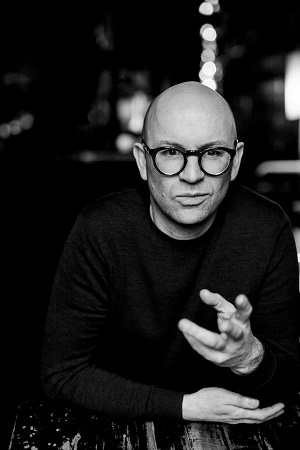 Thomas Guthrie. Photo credit: Theresa Pewal.
Thomas Guthrie. Photo credit: Theresa Pewal.
The scholarly debates have engaged with multifarious musical and extra-musical factors - literary, historical, sociological, political. And, when I ask director Thomas Guthrie about his plans for the performance of Dido and Aeneas that the Academy of Ancient Music will present in the Barbican Hall on 2nd October, he explains his fascination with the history of the literary treatment of Dido - particularly Ovid, Virgil and then, in the sixteenth century and beyond, Marlowe and others - and how that’s been reflected in the way the story has been used politically, especially in reference to Elizabeth I. “I find her especially useful in fleshing out and understanding the character of Dido in the opera - I think it will be a real key for us. I’ve found Deanne Williams’ article ‘Dido, Queen of England’, [1] particularly helpful: “Elissa dies tonight, and Carthage flames tomorrow!” The idea of celibacy being a necessity for her, despite huge political pressure to marry in the state’s interests, precisely to defend her ‘marriage to the state’, possibly provides answers - or at least a context - to the very real tragedy of Aeneas’ change of heart, the subsequent sense of betrayal Dido feels, and her suicide. I think this is at the heart of it.”
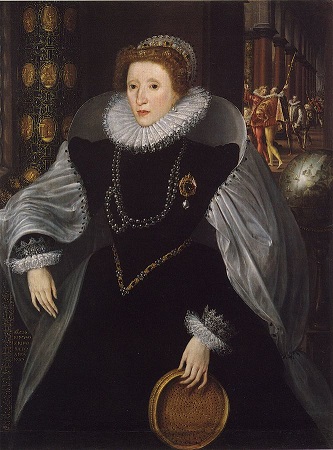 ’The Sieve Portrait’ by Quentin Metsys the Younger (c.1583; British Library Collection; Pinacoteca Nazionale, Siena, Italy/Bridgeman Images). This portrait of establishes a connection between Elizabeth I’s virginity and England’s military power. The sieve represents both the Queen’s chastity and her discerning moral judgement. The pillar to the right of Elizabeth depicts scenes from the Aeneid, including Dido’s first meeting with Aeneas and her suicide.
’The Sieve Portrait’ by Quentin Metsys the Younger (c.1583; British Library Collection; Pinacoteca Nazionale, Siena, Italy/Bridgeman Images). This portrait of establishes a connection between Elizabeth I’s virginity and England’s military power. The sieve represents both the Queen’s chastity and her discerning moral judgement. The pillar to the right of Elizabeth depicts scenes from the Aeneid, including Dido’s first meeting with Aeneas and her suicide.
Thomas also makes it clear that he inclines to a “less is more” approach and that musical values will be paramount. His work always displays a genuine commitment to new ideas and to challenging the audience but he emphasises that while he aims to make a work feel “fresh and relevant” he does “insist that the music and the storytelling are the most important elements”: “I try to inspire the audience to engage in a critical way in order to achieve good theatre. It’s not a matter of telling them what to think or announcing ‘look how clever I am’; you have to invite them to imagine for themselves. To encourage them to make their own pictures that resonate with their own tastes, experiences and memories.”
Thomas points out that there are many questions unanswered, and often unasked, about Purcell’s Dido and Aeneas. Indeed, the plot is characterised by ambiguity and evasion. How does Dido die, for example? Thomas comments that he does not think that the means of suicide is particularly important: “A decision of course has to be made here - but it is more a question of understanding why, and not settling for a purely ‘heartbroken crossed lover’ assumption, which is common, and seems too sentimental and shallow to me.”
I raise a further issue which has troubled commentators, whether Dido is chaste - a question posed with surprising directness by Charles Perrault: ‘What had that Piety of Father Aeneas to do in the Cave with Dido Queen?’ [2] Thomas replies: “Again, I think it’s clear from the classical sources and then from Aeneas himself in Tate’s libretto (‘one night enjoyed’) that she has not been chaste; and, the shame and betrayal to Carthage that she then feels - after the sacrifices one presume she has made - are then more understandable. To me one of the biggest unanswered questions centres intriguingly around the Second Woman’s aria, ‘Oft she visits this lone mountain’. Why has she sung this strikingly inappropriate song as an entertainment at the grand state ‘betrothal picnic’? Or, who has put her up to it, and why? Belinda is Dido’s closest ‘member of staff’; a lady-in-waiting, a confidante, but also a go-between. One can only imagine the pressure on her to snap the queen out of her apparent crisis/paralysis when she sings her first, ‘Shake the cloud from off your brow!’ - in the presence of the entire court. Matters of government must be pressing: famine, threat of invasion. How long has it been since Dido has made a public appearance? And, as a woman, she must want to be seen to be able to keep any apparent overly emotional behaviour under control. Is Belinda warning Dido by instructing the Second Woman to sing this particular song, with its ominous, violent and well-known ending? Or, is she warning Aeneas, and if so, why?”
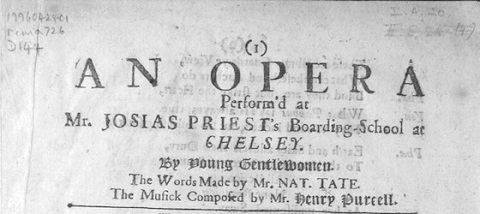 The first page of the libretto of Dido and Aeneas printed for the Chelsea school performance (detail). From the collection of the Royal College of Music.
The first page of the libretto of Dido and Aeneas printed for the Chelsea school performance (detail). From the collection of the Royal College of Music.
Then there is the problem of ‘the sources’. There is no autograph score, and the so-called Tenbury College manuscript (now in the Bodleian Library), which is generally considered to be the ‘best’ source available, was made at least half a century after the first performance of the work and lacks some music alluded to in the Chelsea libretto. The first known performance of the tragic opera is that given at a girls’ boarding school in Chelsea some time before December 1689 (when Thomas D’Urfey’s spoken epilogue was published in his New Poems), and for a long time it was assumed that Purcell had composed his opera for the young ladies of dancer-choreographer Josias Priest’s educational establishment. Subsequently this theory has been challenged: allusions in the Prologue and Epilogue hint at a spring-time premiere, and some scholars have suggested that, on stylistic grounds, the opera could have been composed by 1685, or even earlier. Dido and Aeneas was certainly influenced - in its broad structure, use of dance and dramatic choral roles, and arioso-recitative idiom - by John Blow’s Venus and Adonis (c.1683), which had been performed privately at the court of Charles II and then adapted for Priest’s school in April 1684, and a similar performance history would account for discrepancies between the extant libretto for the Chelsea performance and the earliest surviving score which includes a baritone Aeneas as well as countertenor, tenor and bass chorus parts.
Bryan White’s discovery of a copy of letter dated 15th February 1688/9 written by one Rowland Sherman, a merchant with the Levant Company in Aleppo, to his friend and fellow merchant, James Piggott, in London, seemed to resolve some of the controversies relating to the date and context of the first performance and the original existence of instrumental music now lost. Sherman asks for news of the London cultural scene, specifically: ‘If Harry has sett to the Harpsechord the Symph[ony] of the mask he made for Preists [sic] Ball, I should be very glad of a coppie of it. There's another Symph[ony] in the same mask I think in Cb in the 2d p[ar]t is a very neat point th[a]t moves all in quavers. if he's applyed th[a]t to the harpsechord, ’twould be very acceptabl too.’ [3]
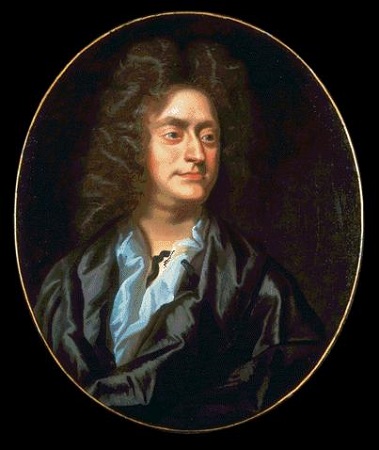 A portrait of Henry Purcell (c.1680).
A portrait of Henry Purcell (c.1680).
Yet, Dido and Aeneas is richly equivocal and is unlikely ever to divulge all its secrets. Thomas Guthrie has frequently made use of puppets and masks in his work, and I ask the director what led to his interest in puppetry and whether he plans to make further use of them in his exploration of Dido and Aeneas? Thomas explains that his interest was initially sparked when he was working with I Fagiolini in a 2001 production of Purcell’s Indian Queen directed by Peter Wilson. He remembers that bass-baritone Matthew Brook, “such a natural actor”, sang in the production, and that it was Matthew’s particular use of a puppet in ‘Ye twice ten hundred deities’ that inspired his own subsequent staging of Winterreise with pianist Gary Cooper.
Thomas comments that the puppets must “work within and maintain the integrity of the musical setting” and must not be “an interference”. His staged Winterreise impressed the critics - in the words of one reviewer, ‘puppet and singer-animator become one’ - and he explains that, while he is not ever 100% convinced by or pleased with every aspect of his work, “this production sought, by use of the puppet, to unlock the storytelling and give opportunity for insight and freshness, but keep the music-making integrated, which, despite its other faults, I think it did.”
“Puppets will only work if the audience are on board, if the puppets invite the audience into the work. This can create a moment of magic, of wonderful theatre.” Puppets are often symbolic - in Asia, rites of passage, birth, marriage and death, are traditionally marked by puppet performances - and Thomas stresses that it is important that the audience should be made to believe in the purpose of the puppets within the theatrical context. He modestly professes that, though he has studied and taught puppetry, he is “not absolutely a 100% master of the art!” but adds that, “‘if you can hold a teddy bear up to a child - and convince the child of its reality - then you certainly have the basic skills to work a puppet. Not everyone has this instinct, actually, but if you can do it, then good basic puppetry, though a great and true craft, is at least within your grasp.”
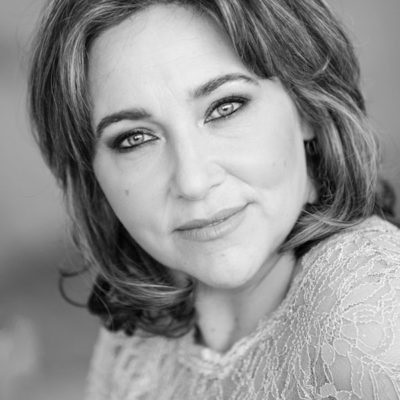 Christine Rice. Photo Credit: Patricia Taylor.
Christine Rice. Photo Credit: Patricia Taylor.
In 2016 Thomas produced a concert staging of Dido and Aeneas with the young singers of the early music ensemble Sestina, musicians from Original Instruments and dancer/choreographer Bridget Madden, a production which travelled to three venues of differing size and environment - the Ulster Hall in Belfast, Londonderry’s The Glassworks and The Church of the Sacred Heart in Newry. At the Barbican Hall, the role of the Carthaginian Queen will be taken by Christine Rice, with whom Thomas was a fellow student, and the director explains that during the eleven-day rehearsal process the need to tell a story through music will be uppermost; ideas will be explored, shaped by Rice’s own interpretation, and that of Rowan Pierce, who will sing the role of Dido’s companion Belinda, Neal Davies who takes the part of the Sorceress, and Ashley Riches who will perform Aeneas. Things that don’t ‘work’ will be discarded. “The singer needs to be the person working the puppet, communicating the idea; it won’t work if there is a puppeteer … I want to make the audience ‘shift’ in their engagement with the opera, to feel guilt!”
One issue that Thomas notes must be addressed when planning any performance of Dido and Aeneas is the question of which compositions to programme alongside the opera. At the Barbican Hall, the first half of the concert will present a ‘funeral for the late Queen of Carthage’, accompanied by other works by Purcell. The opera will, then, essentially be a flash-back, taking us ‘behind the scenes’: we will see the characters behave in certain ways before the funeral, perhaps intimating answers to some of the opera’s conundrums.
Thomas concludes, “Purcell may seem ‘simple’ but his compositions invite interpretation: and, he always gives more than he needs - that is the nature of his genius. And, it’s why we delight in his music so much: he gives much more than is needed to be ‘great’. So, we must not distract from this, but celebrate it.”
At the close of Purcell’s opera, Dido bids her unforgettably poignant farewell, “Remember me, but ah! forget my fate.” In this tragic gesture, Purcell poses one final question: just how should we remember Dido, Queen of Carthage? What does she represent? Perhaps we will find some answers at the Barbican Hall on 2nd October …
Claire Seymour
[1] Deanne Williams, ‘Dido, Queen of England’, ELH 73.1 (2006): 31-59.
[2] In Parallèle des anciens et des modernes, 4 vols. (Paris, 1688-97).
[3] Bryan White, ‘Letter from Aleppo: Dating the Chelsea School Performance of Dido and Aeneas’, Early Music, 37/3 (2009): 417-428.
Tate Britain Collection
September 9, 2018
Landmark Productions and Irish National Opera present The Second Violinist
A chamber opera lasting 75 minutes, The Second Violinist is Dennehy and Walsh’s second operatic collaboration. The first, The Last Hotel, was driven by an ominous meeting and the shadow of death and these elements seem to be becoming trademarks: The Second Violinist lays bare Martin’s suffering soul, loneliness and introspective journeys into surreal and violent worlds, but leaves identity and narrative shrouded in mystery. The opera was first presented by Landmark Productions and Irish National Opera at the Galway International Arts Festival on 27th July 2017 and now the production, which won the Fedora Generali prize for opera and the Best Opera award at the Irish Times Theatre Awards, has travelled to London where the UK premiere opened the new Barbican Centre season this week.
Designer Jamie Varton’s set is dominated by an imposing cinematic interface which stretches across the central section of the wide Barbican Theatre stage. A prefatory statement sets the tone: “Beauty, since you are leaving, as you take my heart, take its suffering too.” As the drama unfolds, the screen flashes hyperactively with the images which storm Martin’s tensely clutched smartphone - thumped-out text messages, pizza delivery promotions, dating agency updates and the like, alongside the insta-snaps taken by Martin - literally a mute musician (Aaron Monaghan takes the silent role), and fictionally a violinist disenchanted with his vocation (and with his instrument if the way he bashes his fiddle about is anything to judge by) - which document his daily travels, routines and miseries.
On Tinder Martin lists his interests as Gesualdo, Masterchef and Ireland Birdwatch - swallows, and their freedom, become a recurring visual and psychological motif - but this cine-world also reveals his obsessions. And, they err on the violent side: Japanese samurai video-game slaughter, safari slayings in which lionesses sink their teeth tenaciously into wildebeests’ necks, and Carlo Gesualdo, that murderous melancholic madrigalist and madman, who, with impunity, killed his wife - Maria D’Avalos, daughter of the Prince of Montesarchio - when he learned of her sexual betrayal. As Martin’s texts unfold before us, video designer Jack Phelan plays a slick trick by back-tracking when Martin describes his occupation as “violen-”, rapidly substituting “violinist”.
The fourteen-strong Crash Ensemble, dynamically conducted by Ryan McAdams, are placed in a sunken orchestral pit, out of which the eponymous protagonist climbs onto a stage which presents a medley of the domestic and the potentially dangerous. Stage-right a lavatory and working shower are apportioned; mid-stage rests a crumpled bed; stage-left houses a kitchen with a large refrigerator from which dangles a miniature violin. In the centre of all is a turning treadmill, suggestive of the passing of time but also - when Martin mounts it, his stare unflinching, slightly unhinged - of his controlling fixations. Up above, accessed by a trapdoor ladder, grows a grim, Brothers Grimm-style forest: a leaf-less, post-apocalypse landscape.
These are evocative and suggestive visual images, but there is simply too much paraphernalia, too widely dispersed. At least when one is watching a tennis match, one’s swinging gaze is following the ball, but here it was impossible to find a focus or keep track of what was going on in the visual margins - and what made it more frustrating was that quick glances left to right and back again suggested that that usually that wasn’t much of import: the pouring of a glass of wine, the sending of a text message.
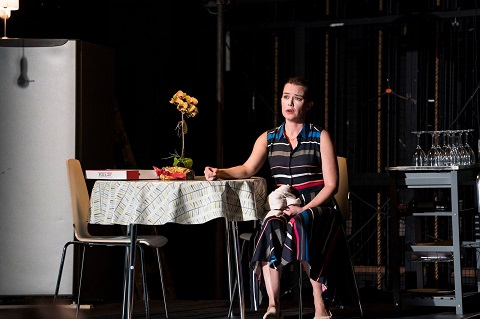 Sharon Carty (Amy). Photo Credit: Patrick Redmond.
Sharon Carty (Amy). Photo Credit: Patrick Redmond.
Walsh’s characters are desperately in need of Forster’s psychological wisdom, ‘only connect’. A recent romantic rift has left Martin heartbroken and emotionally scarred. At first he tells his Tinder correspondent, Scarlett, that he is a “Violinist in a musical ensemble!” but as his hope of potential romance grows he indulges in grandiose wish-fulfilment: he is actually a “Composer of operas”. His favourite Gesualdo madrigal is ‘Già piansi nel dolore’, with its uplifting sentiments, “Once I wept with sorrow, now my heart rejoices, because my lover has said: ‘I too burn for you.’” But, reality bites, and Martin’s identity sinks to simply “Living” and “Alone”.
Amy (Sharon Carty) and Matthew (Benedict Nelson) are in the throes of matrimonial disintegration. Obsession once again rears its ugly head: Amy’s enthusiasm for interior re-decoration is becoming a pathological compulsion. At least the walls are light grey, not dark, for this would be like living in a graveyard, quips Matthew. The characters have an alarming propensity to furtively flourish knives, and the arrival of Hannah, Amy’s old college friend, Hannah (Máire Flavin), sharpens the blade-point further.
As passions are remembered and re-ignited, rivalries and conflicts escalate. Not surprisingly violence erupts, and it’s the two women - themselves former lovers, perhaps? - who bear the brunt. But, is the perpetrator Martin, or Michael? The hands of both drip with viscous blood and Martin’s excoriating scrubbing in the shower surely leaves few layers of his skin intact. Are Martin and Matthew the same person? Have we travelled back in time to the moment of Martin’s abandonment?
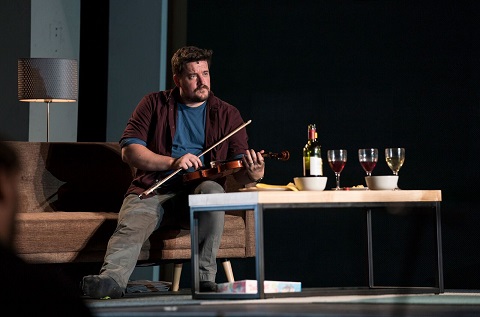 Benedict Nelson (Matthew). Photo Credit: Patrick Redmond.
Benedict Nelson (Matthew). Photo Credit: Patrick Redmond.
The Second Violinist poses potentially intriguing questions and the melange of media could be dynamic. But I wasn’t convinced that Dennehy and Walsh have really made voice, music, word, design, image and movement combine and cohere, in such a way that each element in the hybrid form plays its part in the relation of narrative, emotion and meaning. There’s not actually much singing in The Second Violinist: the titular character is silent and, a quasi-film score, the music more frequently seems simply to illustrate images - the stabbing underpinning of punched out chat-room chat-ups, for example - rather than to forward the emotional and narrative trajectory. The characters’ stage movements often feel directionless; it’s not clear, for example, what purpose is served when the sixteen singers of the chorus move, half-way through, from one side of the stage to the other. Walsh’s text is rather banal: perhaps that’s the point - that the tragedy is the banality?
While Dennehy’s score does incorporate some tensely frenetic music - particularly for the strings - as well as quieter reflections, it is the madrigal-esque choral commentaries that are the musical highpoint, though these choric interjections are not assimilated into a musico-dramatic continuum. The chromatic contortions and disconcerting lurches between distantly related harmonies encapsulate both the characters’ pained alienation and the drama’s unstable psychological ambiguities - though repetition of the devise brought the sense that my sentiments were being manipulated: dissonance and disjuncture seem somewhat facile intimations of dysfunctional psychopathy.
The solo roles were performed with uniformly intense commitment and focus, but there is little differentiation of character in Dennehy’s vocal writing. Both Carty and Flavin crafted their melodic lines with clarity and focused tone, but their diction was weak. Nelson projected strongly, but the presence that the singer brings to the stage felt under-used and the characterisation of Matthew under-developed. And, despite the tension generated by the unanswered questions, there was a countering static quality. Every fibre of Aaron Monaghan’s face and fibre screamed with Martin’s pain but given that’s how he starts there’s not really anywhere to go.
If you like Gone Girl and The Girl on the Train then you’ll probably love The Second Violinist - certainly the Barbican Theatre audience were enthusiastic in their reception. When Scarlett (Kimani Arthur) eventually meets Martin, we fear it’s not so much for a casual stroll in the countryside as for a risky venture ‘Into the Woods’, with Bluebeard as an escort. Gesualdo got away with murdering his wife in flagrante. Will Martin/Matthew? The trouble is, I’m not sure that I really cared.
Claire Seymour
Donnacha Dennehy: The Second Violinist (libretto by Enda Walsh)
Martin - Aaron Monaghan, Hannah - Máire Flavin, Amy - Sharon Carty, Matthew - Benedict Nelson, Scarlett - Kimani Arthur; Director - Enda Walsh, Conductor - Ryan McAdams, Designer - Jamie Varton, Lighting designer - Adam Silverman, Video designer - Jack Phelan, Sound designers - David Sheppard and Helen Atkinson, Costume designer - Joan O’Clery, Crash Ensemble, Chorus.
Barbican Theatre, London; Thursday 6th September 2018.
image=http://www.operatoday.com/Aaron%20%20Monaghan%2C%20%20image%20%20credit%20%20Patrick%20%20Redmond.jpg image_description=The Second Violinist by Donnacha Dennehy and Enda Walsh, Barbican Theatre, 6th September 2018 product=yes product_title=The Second Violinist by Donnacha Dennehy and Enda Walsh, Barbican Theatre, 6th September 2018 product_by=A review by Claire Seymour product_id=Above: Aaron Monaghan (Martin)Photo credit: Patrick Redmond
September 7, 2018
The Rake's Progress: British Youth Opera
And, the front-drop of Stephen Unwin’s production for British Youth Opera at the Peacock Theatre presented a fitting painterly swipe of reckless colour and some watery splashes, reminding us, in-between scenes, of the opera’s origins and of the virtuosic artifice of the composer’s and the poet’s remodelling of the past.
James Cotterill’s designs transported Tom Rakewell’s moral and material descent to the mid-twentieth century, the creators’ present, though I sensed at times a whiff of late-nineteenth century hypocrisy and degeneracy - the devil-may-care self-destructiveness of Wilde’s Dorian Gray or Stevenson’s Dr Jekyll, say.
This was a slow-burn production which on the opening night started with unfussy restraint but upped the emotional tempo towards the final scenes and closed with a touching picture of utter and irredeemable wretchedness. In fact, it all seemed a bit too discreet and decorous initially, and conductor Lionel Friend’s ponderous tempi didn’t help, though the Southbank Sinfonia’s orchestral textures were always lucid - the players seemed more comfortable in this idiom than they had been a few nights previous, in Jeremy Sams’ baroque pasticcio, The Enchanted Island - and Sam Jury’s fortepiano continuo was crisp and characterful.
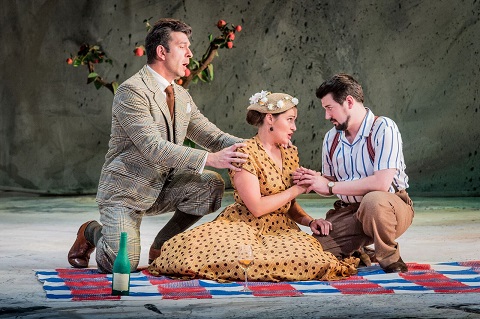 Pedro Ometto (Trulove), Samantha Clarke (Anne) and Frederick Jones (Tom Rakewell). Photo Credit: Robert Workman.
Pedro Ometto (Trulove), Samantha Clarke (Anne) and Frederick Jones (Tom Rakewell). Photo Credit: Robert Workman.
The dingy grey curtain which formed the bedraggled backdrop for the dreamy, innocent domesticity of the opening scene - Trulove’s garden being indicated by a few stray pot plants - made for a rather shabby utopian idyll, but the simplicity of design subsequently proved an asset in telling a complicated tale. Splashes of colour - crimson red for Mother Goose’s brothel, hubristic purple of Sellem’s auction - and the modulation of Mark Jonathan’s lighting from the bright light of day to the darkness of graveyard despair, and finally to washed-out pallor amid the shadowy horrors of Bedlam, did good service to the plot.
This was a Progress, though, that was rather perversity-lite. The lip-shaped velvet sofa in the Brothel did not seem likely to swallow up Tom, sucking him into debauchery, and while the array of artefacts with which Tom adorns his house effectively trod the fine line between eclectic eccentricity and trashy tastelessness, the leopard-spotting statuettes and “fantastic baroque machine”, which Shadow professes can turn stone to bread, lacked that touch of truly bizarre extravagance.
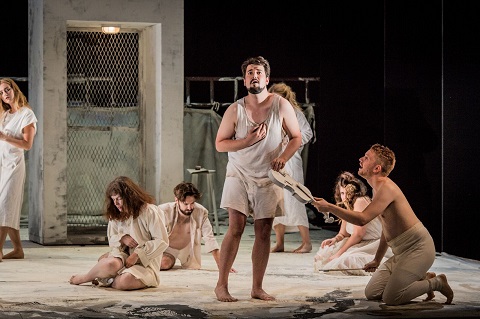 Frederick Jones (Tom Rakewell). Photo Credit: Robert Workman.
Frederick Jones (Tom Rakewell). Photo Credit: Robert Workman.
The singing was top-notch, however. I admired Samantha Clarke’s Elvira in last year’s BYO production of Don Giovanni, and she brought a similar stylishness and beguiling lyricism to her portrait of the long-suffering Anne Trulove. She was well-matched by Frederick Jones’s Rake, who retained just enough hint of ‘boy-next-door’ goodness and gullibility for his decline and ultimate demise to touch our hearts. Tom’s reflections on his love for Anne and his fears for the future bloomed warmly and the challenges of the complex vocal lines proved no problem for the tenor.
Jessica Ouston put in a star turn as Baba the Turk showing a discerning sense of well-placed dramatic details - the knowing twiddling of Baba’s laced-gloved thumbs as she waited in a man-drawn hackney for Tom’s inevitable capitulation was a deliciously cruel comic touch - and using her juicily plump mezzo to make the fairground celebrity much more than just a dramatic device.
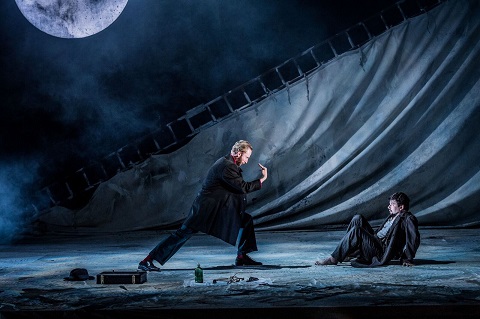 Sam Carl (Nick Shadow). Photo Credit: Robert Workman.
Sam Carl (Nick Shadow). Photo Credit: Robert Workman.
Both Iain Henderson’s Sellem and Emma Lewis’s Mother Goose might have been more outré, but the roles were confidently sung. Sam Carl’s Nick Shadow, too, displayed surprisingly understated Machiavellianism, but the seductive softness of Carl’s bass-baritone - which I enjoyed earlier this year at the Kathleen Ferrier Award Finals and in the Guildhall School of Music and Drama’s production of Lennox Berkeley’s The Dinner Engagement - made it easy to see why Tom was duped by Shadow’s propositions and promises, and Carl’s switch from friend to foe was sly and disturbing. Pedro Ometto (Trulove) and Thomas Mole (Keeper of the Madhouse) completed a fine cast and the BYO Chorus were in roaring voice.
There was one area of ‘weakness’ though, as there had been in An Enchanted Island. The singers’ diction lacked clarity. And, Auden’s words do deserve to be heard. By coincidence, the preceding evening had found me at Wilton’s Music Hall for ENO Studio Live’s production of Benjamin Britten’s Paul Bunyan - Auden’s first essay at libretto writing. Interestingly, in an undated draft memoir about his collaborations with Benjamin Britten, the poet reflected: ‘It was during this period [1939-40] that Britten wrote his first opera, and I my first libretto, on the subject of an American Folk hero - Paul Bunyan. The result, I’m sorry to say was a failure, for which I am entirely to blame, since, at the time, I knew nothing whatever about opera or what is required of a librettist. In consequence some very lovely music of Britten’s went down the drain.’ Auden is perhaps somewhat too harsh on himself; there were various reasons for the operetta’s poor reception. But, certainly, his libretto for The Rake’s Progress demonstrates his mastery of the craft. The Peacock Theatre is not fitted with surtitle screens, so the singers had even more responsibility to ensure that we could appreciate the virtuosic pastiche of Auden’s literary melange, which equals Stravinsky’s musical parodies for stylistic bravura.
Despite this, the pathos of Tom’s grim fate certainly made its mark and when the cast broke the fourth wall, their moralising summation, that the Devil makes work for idle hands, effectively drummed home a lesson that had been deftly and directly delivered.
Claire Seymour
British Youth Opera: The Rake’s Progress
Trulove - Pedro Ometto, Anne - Samantha Clarke, Tom Rakewell - Frederick Jones, Nick Shadow - Sam Carl, Mother Goose - Emma Lewis, Baba the Turk - Jessica Ouston, Sellem - Iain Henderson, Keeper of the Madhouse - Thomas Mole; Director - Stephen Unwin, Conductor - Lionel Friend, Designer - James Cotterill, Movement Director - Natasha Harrison, Lighting Designer - Mark Jonathan, Southbank Sinfonia, BYO Chorus.
Peacock Theatre, London; Tuesday 4th September 2018.
image=http://www.operatoday.com/Henderson%20Sellem.jpg image_description=British Youth Opera, The Rake’s Progress at the Peacock Theatre product=yes product_title=British Youth Opera, The Rake’s Progress at the Peacock Theatre product_by=A review by Claire Seymour product_id=Above: Iain Henderson (Sellem)Photo credit: Bill Knight
September 6, 2018
Prom 71: John Eliot Gardiner and the Orchestre Revolutionaire et Romantique play Berlioz
Playing standing, the orchestra launched into Le corsaire with enormous energy. Throughout the music was by turns headlong and thoughtful with a real tang to the timbres, creating a vivid performance full of contrasts.
This was followed by La mort de Cleopatra, Berlioz's third attempt at winning the Prix de Rome (in fact that cantata was far too daring for the jury). It is a striking sequence of recitative and aria which Berlioz sets in a fluid manner, creating a single narrative. Joyce DiDonato gave a dramatic performance, full of arresting detail and a vivid attention to the words. She was complemented by the timbres and textures of the orchestra, everyone making the music full of quick changes of mood. The death scene at the end was terrific.
Next came the Royal Hunt and Storm from Les Troyens, the ballet sequence which is as much orchestral showpiece as anything else. Gardiner started quietly but again it was the sound and contrasts of the period instruments which brought the music alive. Gardiner brought the off-stage brass on-stage so that we were able to make the most of the saxhorns, and it was lovely to be able to hear the contrast between the smooth even tone of the saxhorns and the more varied timbres of the hand-stopped French horns. This was a performance full of contrasts and textures you could cut with a knife, a vivid and theatrical orchestral experience.
We plunged on directly to Dido's death scene, with Joyce DiDonato rushing on during the prelude. She gave us fluidly shaped recitative, complemented by the colours in the orchestra. She made a passionate and dignified Dido, with touching references back to the love duet. Unfortunately, given such a vivid performance, we did not get the final death scene and the performance finished with the air 'Adieu, fiere cite'.
In the second half we returned to earlier in Berlioz' career with his symphony Harald in Italy. Gardiner and the orchestra began the first movement with the soloist, Antoine Tamestit, off stage. Gardiner brought a classical sweep to the music, yet the timbre of period instruments gave romantic spice to the music. The piece is hardly a concerto, Harold is the eternal observer, and Tamestit emphasised this by coming on stage and observing the orchestra before playing, and he rarely stood in the classic soloist’s position, instead wandering round the stage creating a sense of visual dramatic narrative. He plays quite a big viola with a beautiful singing sound, so that though not a virtuoso work Tamestit's melodic line was the passionate centre of attention, and both Tamestit and Gardiner brought sheer energy to the work. The second movement was full of attractive textures, whilst Tamestit’s playing had real poetry to it in the third movement. In the lively last movement, Gardiner and the orchestra emphasised the crisp and lively rhythms, whilst Tamestit's viola wandered in and out of the orchestra both physically and musically.
This was a programme which showed what can be gained from performing Berlioz on period instruments, and Gardiner and his team complemented this with a vivid sense of energy. It was lovely to hear DiDonato in the snippet from Les Troyens, but as with the recent Proms performance of two arias from Samuel Barber's Anthony and Cleopatra, it made you wish that room could have been made for more substantial excerpts or even the whole work. As it was, there was rather a sense of greatest hits about the evening, but what hits they are.
Robert Hugill
Prom 71: Hector Berlioz - Le corsair, La mort de Cleopatra, ‘Royal Hunt and Storm’ (Les Troyens
), Dido’s death scene (Les Troyens), Harold in Italy
Joyce DiDonato - soprano, Antoine Tamestit - viola, John Eliot Gardiner -
conductor Orchestra Revolutionnaire et Romantique.
BBC Proms at the Royal Albert Hall, London; 5th September 2018.
image=http://www.operatoday.com/DiDonato%20Prom%2071.jpg
image_description=Prom 71: John Eliot Gardiner conducts the Orchestra Revolutionnaire et Romantique
product=yes
product_title=Prom 71: John Eliot Gardiner conducts the Orchestra Revolutionnaire et Romantique
product_by=A review by Robert Hugill
product_id= Above: Joyce DiDonato (soprano) and John Eliot Gardiner (conductor)
Photo credit: BBC/Chris Christodoulou
ENO Studio Live: Paul Bunyan
In the Edenic opening, the Chorus of Old Trees sing, “Man is a form of life/ That dreams in order to act/ And acts in order to dream”: in relating the myth of the legendary pioneering lumberjack, Paul Bunyan, Auden depicts an American utopia in which man strikes out to build a new world in which personal freedom, individual choice and tolerance are paramount values. The current social and political landscape, national and international, may give little cause for such faith and optimism, but in 1939, the feeling among Britten’s contemporaries that Europe was no place to live and that a brighter future lay in the New World, led Benjamin Britten and Peter Pears to set sail from Southampton on 29th April that year.
Britten wrote to his sister Barbara, on 3rd September 1939, ‘I’ve seen & am seeing Auden a lot, & our immediate future is locked with his, it seems.’ Five years earlier he had recorded in his diary, ‘Spend day with Coldstream and Auden … I always feel very young and stupid with these brains - I most sit silent when they hold forth about subjects in general. What brains!’ Later, in 1960, he told Lord Harewood in a BBC interview: ‘I was very much influenced by Auden … He went to America, I think it was ’38, early ’39, and I went soon after. I think it wouldn’t be too much oversimplifying the situation to say that many of us young people at that time felt that Europe was more or less finished.’
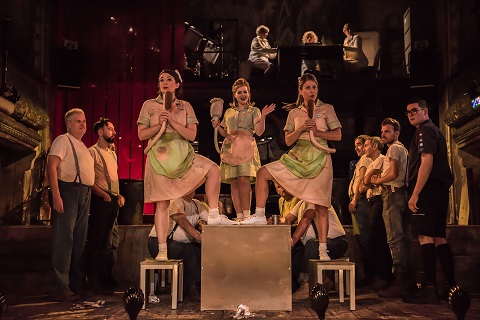 Sophie Goldrick (Moppet), Lydia Marchione (Poppet), Fflur Wyn (Fido). Photo Credit: Genevieve Girling.
Sophie Goldrick (Moppet), Lydia Marchione (Poppet), Fflur Wyn (Fido). Photo Credit: Genevieve Girling.
The Hollywood commission may not have materialised but there’s a wonderfully indulgent and uplifting optimism about Paul Bunyan - despite the occasional heavy-handed ideological spin and cynical mockery of American ‘can-do’ cheery confidence of W.H. Auden’s lexicographically dextrous libretto: “Do you feel a left-out at parties, when it comes to promotion are you pass over … then ask our nearest agent to tell you about soups for success.” Auden wasn’t above overt pillorying of what he saw as the facile values, neuroses and the vacuity of the Dream either: “You owe it to yourself to learn about Beans, and how this delicious food is the sure way to the body beautiful.”
First performed in May 1941 in Brander Matthews Hall, Columbia University, by the Columbia Theatre Associates, Paul Bunyan is a work of youthful hopes, independent choice and opportunity, and this ENO Studio Live production, directed by Jamie Manton and performed by an excellent young cast, fizzed with vitality, vivaciousness and positive vibes.
Auden’s text - condemned by contemporary reviewers such as Virgil Thompson (in the New York Herald Tribune, 6 May 1941) as having ‘no characters and no plot’ and for allegorical moralising that was ‘utterly obscure and tenuous’ - tells the legend of the pioneering lumberman, Paul Bunyan, who forged his way through the forests to found a New world. (One small quibble: what was the point of providing surtitle screens but placing them left and right, positioned above Wilton’s gallery, so that they were entirely obscured from the capacity audience seated in the stalls?)
Wilton’s Music Hall might seem, at superficial glance, an odd place to stage an agrarian idyll but this tastefully ramshackle building vibrates with a raw energy and resilience, and a sense of risk. Manton and choreographer Jasmine Ricketts pull the stopper out of the vitality bottle and there was absolutely no danger of the vim and verve running out as the cast and chorus whipped through Auden’s assemblage of episodes and Britten’s stylistic melange with gleeful enthusiasm.
The dynamism was unflagging, through fights, feasts and even a mock funeral. In fact, sometimes less might have been more - not least because some of the singers seemed to forget that they were not at the Coliseum and to underestimate the resonance of the Wilton’s acoustic - but the singing and playing was consistently thrilling in its intensity, even if a bit ear-splitting at times: a fortissimo “We’re bored!” from the revolutionary Young Trees (“Reds”, sneer their aging forbears) left no doubt about their impatience with their elder’s love of life in the slow lane.
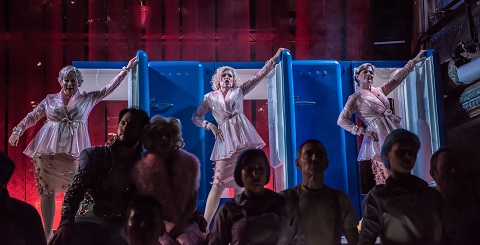 Susanna Tudor-Thomas, Claire Mitcher, Rebecca Stockland (narrators). Photo Credit: Genevieve Girling.
Susanna Tudor-Thomas, Claire Mitcher, Rebecca Stockland (narrators). Photo Credit: Genevieve Girling.
I questioned a few of Manton’s decisions, such as why he chose to replace the balladeer narrator with a trio of female singers, thus excising an important unifying element and diminishing the hilly-billy folksiness of the guitar-accompanied ballads? Some of Auden’s character-names seem to have been drawn from the advertising promotion booklet prepared by William Laughead, an employee of the Red River Lumber Company, in 1914 which introduced loggers named Johnny Inkslinger, Chris Crosshaul and Sourdough Sam, as well as Bunyan’s best pal, Babe the blue ox. Here Babe was represented by cobalt-blue refrigerators bearing his name, miniature in dimension at first but subsequently a row of industrial-sized freezers from which emerged ENO Harewood Artists William Morgan and Rowan Pierce to sing the love duet of Hot Biscuit Slim and Bunyan’s daughter, Tiny, dressed as Elvis Presley and Marilyn Monroe respectively.
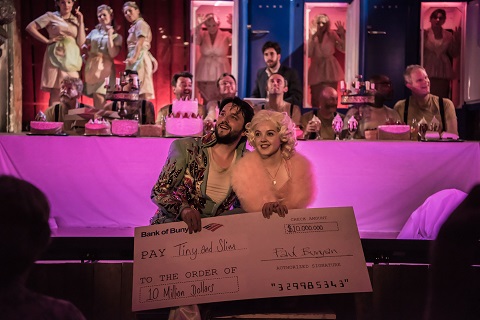 William Morgan (Slim), Rowan Pierce (Tiny). Photo Credit: Genevieve Girling.
William Morgan (Slim), Rowan Pierce (Tiny). Photo Credit: Genevieve Girling.
And, there was one moment of magic that was sadly missed: when the “whole pattern of life is altered” and “Once in a while the moon turns blue”. In his biography of Britten, Humphrey Carpenter observed that Britten once remarked to Donald Mitchell, ‘That was Peter’, and a letter of 9 th January 1940 supports this idea, stating, ‘as long as I am with you, you can stay away until the moon turns blue’. Britten’s gamelan-inspired colours and textures convey mystery and exoticism: the Dream involves not just a yearning for material success but also a serious search for individualism and personal love. The hoisting of Bunyan’s initials in neon-lit blue didn’t cast the same moonlight enchantment.
Paul Bunyan is literally larger-than-life: a Herculean logger who is immense both physically and symbolically, capable of felling trees with a flick of the wrist. In the opera he is represented by a disembodied voice and here Simon Russell Beale’s recorded voice boomed with an authority both benevolent and demanding - and unfortunately with a resonance that was distorting and sometimes deafening.
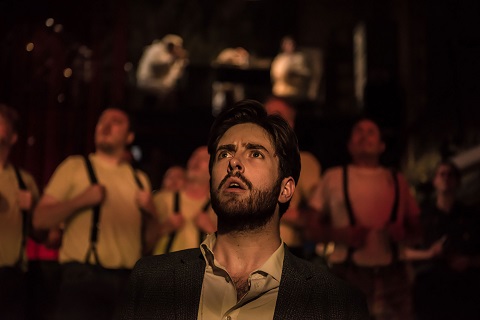 Elgan Llŷr Thomas (Johnny Inkslinger). Photo Credit: Genevieve Girling.
Elgan Llŷr Thomas (Johnny Inkslinger). Photo Credit: Genevieve Girling.
Elgan Llŷr Thomas was tremendous as the reflective Johnny Inkslinger, capturing all the complexity of feeling in ‘Inkslinger’s Song’, the deepening ruminations and self-examination being enhanced by the eerie spell cast by the woodwind accompaniment. Llŷr Thomas managed to communicate Auden’s articulation of the social conscience of 1930s - “Oh, but where are those beautiful places/ Where what you begin you complete,/ Were the joy shines out of men’s faces,/ And all get sufficient to eat?” - with persuasive personal sentiments.
Fellow Harewood Artist Matthew Durkan offered an unusual take on the arrogant foreman, Hel Helson: usually more brawn than brains, here he was more nerd than narcissist. Sophie Goldrick (Moppet) and Lydia Marchione (Poppet) made a delightful pair of crooning cats, while Fflur Wyn was excellent as the coloratura dog, Fido. The innocent earnestness and excitability of bicycle-bound messenger, David Newman, almost stole the show.
But, the real star here, and rightly so, was the ENO Chorus. Paul Bunyan may comprise a motley crew of characters but many of the solo voices step out from the chorus, and it is collective rather than individual expression that is uppermost. The ENO Chorus really raised the roof of Wilton’s, from the opening moments in which the Chorus of Old Trees gave us a surround-sound homily to the final resounding choric plea “Save animals and men”. Conductor Matthew Kofi Waldren stitched together the eclectic idioms with fluency and brightly coloured zest, the orchestra (Britten’s revised instrumentation was used) tiered on stage and spilling into the side-aisles.
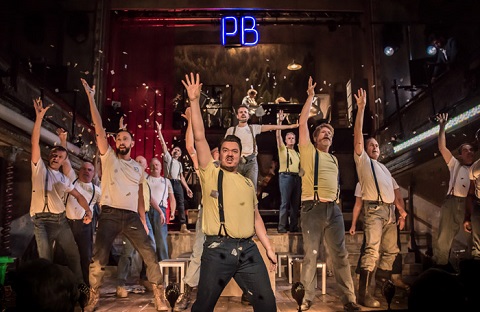 ENO Chorus. Photo Credit: Genevieve Girling.
ENO Chorus. Photo Credit: Genevieve Girling.
In an oft-quoted letter of 31st January 1942, Auden urged Britten to embrace his political and sexual beliefs: ‘As you know I think you the white hope of music … and I think I know something about the dangers that beset you as a man and as an artist because they are my own’. Britten was not best pleased to be warned about the artistically destructive consequences of his attraction (and denial of such attraction) to ‘thin-as-a-board juveniles’ and the advice that if he was to develop as an artist he would have to stop ‘playing the talented little boy’ and ‘to suffer, and to make others suffer’.
Despite Auden’s avowal that it was his ‘love and admiration’ that made him so frank, estrangement followed, and Paul Bunyan languished, unperformed until 1974 when Britten revisited the score, revising excerpts for that year’s Aldeburgh Festival. The success of this performance encouraged him to undertake further revisions and a new version of the full operetta was broadcast by the BBC on 1st February 1976. Donald Mitchell described how, when Britten received the news of Auden’s death in September 1973, though the two men had not communicated for 30 years, Britten was devastated: ‘It was the only time I’d ever seen Ben weep.’ And, when he listened to the BBC radio broadcast, Mitchell remembered (as related by Humphrey Carpenter) that ‘Ben was profoundly moved by re-encountering this forgotten work from a forgotten - virtually suppressed - past. He hadn’t remembered that it was such a ‘strong piece’ - his words; and the impact of the music, combined with all the memories it aroused - of Auden, of the American years, of his own youth, energy and vitality - over-whelmed him.’
I’m not sure that this ENO production really captured the ‘innocent’ directness of Paul Bunyan. British Youth Opera’s 2014 production seemed more poignant to me. But, Manton delivered a strong message. In the last scene Paul Bunyan’s Voice utters the warning: “Every day America's destroyed and re-created,/ America is what you do./ America is I and you,/ America is what you choose to make it.” Now, there’s a thought for troubled times, on both sides of the pond.
Claire Seymour
Britten: Paul Bunyan
Voice of Paul Bunyan - Simon Russell Beale, Narrators - Claire Mitcher/Rebecca Stockland/Susanna-Tudor Thomas, Johnny Inkslinger - Elgan Llŷr Thomas, Tiny - Rowan Pierce, Slim - William Morgan, Sam Sharkey - Graeme Lauren, Ben Benny - Trevor Eliot Bowes, Hel Helson - Matthew Durkan, Four Swedes - Adam Sullivan/Geraint Hylton/Paul Sheehan/Andrew Tinkler, John Shears - Robert Winslade Anderson, Western Union Boy - David Newman, Fido - Fflur Wyn, Moppet - Sophie Goldrick, Poppet - Lydia Marchione, Quartet of the Defeated - Morag Boyle/David Newman/Michael Burke/Paul Sheehan, Three Wild Geese - Claire Mitcher/Rebecca Stockland/Susanna-Tudor Thomas, Young Trees - Rowan Pierce/Amy Kerenza Sedgwick/David Newman/Pablo Strong, Lumberjacks - Paul Sheehan/Ronald Nairne/Pablo Strong, Heron - Deborah Davison, Moon - Fiona Canfield, Wind - Amy Kerenza Sedgwick, Beetle - Susanne Joyce, Squirrel - Jane Read; director - James Manton, conductor - Matthew Kofi Waldren, designer - Camilla Clarke, lighting designer - Marc Rosette, choreography - Jasmine Ricketts, sound designer - Jorge Imperial, dialogue/dialect coach - Martin Ball, ENO Orchestra and Chorus.
Wilton’s Music Hall, London; Monday 3rd September 2018.
image=http://www.operatoday.com/ENO-PB-neon-sign.png image_description=ENO Studio Live, Paul Bunyan at Wilton’s Music Hall product=yes product_title=ENO Studio Live, Paul Bunyan at Wilton’s Music Hall product_by=A review by Claire Seymour product_id=Above: Paul Bunyan, ENO ChorusPhoto credit: Genevieve Girling
September 5, 2018
Young audience embraces Die Zauberflöte at Dutch National Opera
The company went all out to make the young spectators feel at home, especially first-timers. Ticket prices were affordable and an insert in the program contained a synopsis of the synopsis and ten Magic Flute fun facts. General Director Els van der Plas welcomed the sea of fresh faces, stressing that opera is also for them and mentioning the various discounts and associations aimed at patrons as young as those still in high school. Judging by the spontaneous reactions during the performance and the loud cheers at the curtain call, DNO picked the right fare for its intended audience.
The cast was a mix of new faces and carry-overs from the previous two runs. Overall, it is the most vocally charismatic yet. After a hint of trouble with flexibility in the portrait aria, Stanislas de Barbeyrac, as the unflagging Prince Tamino, wielded a classy lyric tenor with a heroic glint. On a quest to rescue the captive Pamina, Tamino must also attain enlightenment by undergoing a series of ordeals set by high priest Sarastro. Matching his strong stage presence, soprano Marie Eriksmoen as Pamina sang in unblemished silvery lines. Although sounding every bit like royalty, she also projected relatable warmth and dejection. Fortunately, the Papageno of baritone Thomas Oliemans remains unchanged. Totally at ease vocally and coherent down to the last eye-roll, Oliemans’s Bird-Catcher is one of the best ever performances on this stage. The good-hearted but volatile man in search of a mate triggered both sympathy and mild exasperation. After a brilliant comic routine with wine bottles and a pair of leeks to “Ein Mädchen oder Weibchen” one couldn’t help but root for him, bird poo stains and all. When Lilian Farahani’s Papagena decided to put an end to his loneliness, the pair descended into the audience and carried it away with their hyperactive duet.
A trio of fine Dutch singers, Judith van Wanroij, Rosanne van Sandwijk and Helena Rasker, sang assertively as the Three Ladies. These sexually aggressive beings with kohl-rimmed eyes are agents of the Queen of the Night, soprano Nina Minasyan, whose waning power is symbolized by her reliance on a cane and a wheelchair. Minasyan, a most valuable newcomer to the cast, effectively conveyed the Queen’s helplessness while fulminating with razor-sharp coloratura. Conductor Antonello Manacorda sculpted the score lovingly, giving the singers all the space they needed. A few lapses in crispness were amply compensated by the balmy sound of the Netherlands Chamber Orchestra on period instruments. The audience loved it when principal flute Hanspeter Spannring and Jan-Paul Grijpink on the glockenspiel joined the stage action. The house chorus iced the cake with velvety ensembles.
McBurney relates the tale straight, on a set drained of color, but which constantly fizzes with surprises. The viewer is playfully engaged by the ingenious use of simple theatrical techniques, such as live projections of chalk drawings. Papageno’s birds are actors flapping white pages, leather-bound books form the pillars of Sarastro’s temple. Live sound effects emerge from a cabinet of wonders and the raising and lowering of a suspended platform keeps the characters on the go. No attempt is made to analyze Emanuel Schikaneder’s libretto, an exposition of Masonic ideals larded with the unquestioned racism and sexism of 18th-century Europe. An ugly racial slur is erased by having the slave overseer Monostatos describe himself as a monster instead of referring to his skin color. The misogyny remains: women don’t do much except talk a lot and their brains are too feeble to comprehend the knowledge monopolized by Sarastro and his Brotherhood. The work’s Masonic symbolism is absent from the staging, and without it the plot raises several questions. Why is the Queen of the Night evil? How does Tamino ignoring his girlfriend purify and edify either of them? McBurney does not provide any answers.
Although no sides are taken, Sarastro is presented as a messianic, coercive leader. With his silver main and granite bass, Dimitry Ivashchenko was both magnetic and unnerving in the role. One wouldn’t want to run afoul of his right-hand man either, the cold, stern-voiced Maarten Koningsberger. In a cast with practically no weak links, even Sarastro’s goons were pitch-perfect, from tenor Wolfgang Ablinger-Sperrhacke as the hateful Monostatos to the exemplary Armored Men of Tristan Llŷr Griffiths and Geoffroy Buffière. It may take some extra effort to get young patrons into the opera house, but it is nights such as this one that will make them want to go back.
Jenny Camilleri
Cast and production information:
Pamina: Mari Eriksmoen; Queen of the Night: Nina Minasyan; Tamino: Stanislas de Barbeyrac; Papageno: Thomas Oliemans; Sarastro: Dimitry Ivashchenko; First Lady: Judith van Wanroij; Second Lady: Rosanne van Sandwijk; Third Lady: Helena Rasker; Papagena: Lilian Farahani; The Speaker: Maarten Koningsberger; Monostatos: Wolfgang Ablinger-Sperrhacke; First Priest/Second Armored Man: Geoffroy Buffière; Second Priest/First Armored Man: Tristan Llŷr Griffiths. Three Boys: Boys’ Choir of the Chorakademie Dortmund. Director: Simon McBurney; Movement: Josie Baxter; Set Design: Michael Levine; Costume Design: Nicky Gillibrand; Lighting Design: Jean Kalman; Video: Finn Ross; Sound Design: Gareth Fry. Conductor: Antonello Manacorda. Dutch National Opera Chorus. Netherlands Chamber Orchestra. Seen at Dutch National Opera & Ballet, Amsterdam, on Tuesday, 4th of September, 2018.
image=http://www.operatoday.com/Toverfluit.png image_description=Photo courtesy of Dutch National Opera product=yes product_title=Young audience embraces Die Zauberflöte at Dutch National Opera product_by=A review by Jenny Camilleri product_id=Above photo courtesy of Dutch National OperaProm 67: The Boston Symphony Orchestra play Mahler’s Third
Re-engaging with Mahler in concert - with his longest and most unique symphony, and, at the time it was written, also most Modernist - brought both dividends and problems. This was a performance that was sometimes remarkable for its precision and beauty; but it was also one that barely survived by the skin of its teeth in parts of it. The Boston Symphony Orchestra, at their best, delved deep into the soul of this music; but there was also some very shaky ensemble, perhaps a little uncharacteristic for this orchestra. In the orchestral battlefields of the meadow and forest, it was very much the flowers which triumphed over the animals in this particular performance. I can’t recall ever having been so engaged by a second movement that just resonated with the perfume of sound; the palate of instruments from the orchestra blossoming like flowers in Spring could almost be touched it was so gorgeously phrased. But come the third movement, what had been a revelation before descended into chaos and incoherence.
Mahler’s Third is, of course, on a colossal scale though its debt to Nietzsche - most obvious in the fourth movement’s mezzo solo from Also sprach Zarathustra - is really a repudiation of much of what the philosopher stood for. Despite its juggernaut proportions, the symphony embraces its own kind of heavenly spirituality - it’s a vast metaphor for Pan, God, nature and innocence, the children’s chorus of the fifth movement being a defining parting of the ways with Nietzsche who preferred the earth over the heavens. The diversity of the musical forms in this symphony is extraordinary, too: there are marches which are militaristic and funereal, peasant music, liturgical music, the voices of children and music that unravels like a spiritual poem. No single performance can ever hope to be everything in this symphony and Andris Nelsons and the Bostonians fell short a little too often.
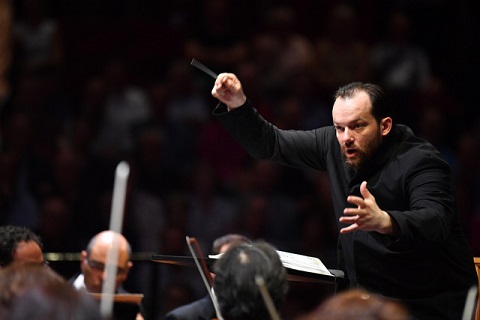 Andris Nelsons. Photo Credit: BBC/Chris Christodoulou.
Andris Nelsons. Photo Credit: BBC/Chris Christodoulou.
Given that there are almost 900 bars of music to the first movement alone the scope for problems is huge. That there were very few in this performance, and that it was conducted and played so well, suggested that Nelsons had worked hard to understand where its shortcomings might be. The opening march was a true awakening of Pan, with the Boston horns and brass noble enough; there is always a slight risk with some American orchestras that the brass will over-power almost everything in their path but here Nelsons has tamed the instincts of his musicians and they play with a more nuanced sound. But when Mahler asks for it - in the E flat March of the Development section, for example - you got playing that was distinguished by the sound of tubas and trombones playing with heft and coarseness. A solo piccolo sung like a shrill lark, and yet it marvellously hovered over the rest of orchestra as if taking flight. A bassoon rumbled from the bottom of the orchestra. Winds and double-basses playing in unison were notable for the shadows of sound that they cast. These are not necessarily small details, but they were ones that Nelsons spot-lit with uncanny accuracy. A highpoint - and they were really a highpoint throughout the entire symphony - were the incisive timpani. Here we had strokes that swelled against their skins like a coming storm, and timpani rolls that seemed to emerge from the mistiness of the orchestra only to engulf you in a torrential blaze of thunder.
The short second movement was, for me, the highlight of the performance. The playing was not only impeccable, it was that rare thing in a Mahler symphony - spellbinding. The sound of the orchestra was often like a seasonal breeze - solo instruments, especially the winds, were diaphanous, notes floated with such colour it was mesmerising. Oboes, flutes and clarinets didn’t just have the sense they were blossoming; the instruments seemed to bend like stems against the staves on the pages of the score. When the storm arrived those same winds that had swayed through the orchestra were now tossed about to the point of destruction.
Quite what happened to the performance after this point is anyone’s guess because it rarely managed to reach the heights it had done during the first two movements. The third movement was really quite the battleground - and the Boston Symphony Orchestra didn’t come through it completely unscathed. This isn’t music that can be moulded like clay (as Nelsons tends to do in Mahler), and nor is it music that is strictly as Mahler described it in his score. The third movement inhabits a world of extremes: It can be mysterious, poetic, merry, anarchic, but rarely is it ever in the same tempo, and rhythms are more complex here than anywhere else in the work. Those same instruments that were so magical and fragrant as flowers, struggled to emulate bird calls, and the orchestra became a forest where its animals were without terror and, frankly, rather tuneless. If earlier in the performance Toby Oft’s trombone solo had been redolent with beautifully caressed intonation, here the two post horn solos of Thomas Rolfs created the barometer for the rest of the orchestra to quiver at its very roots. Granted, Mahler’s demands are enormous: The second post horn solo alone demands a stretch in dynamics ranging from ppp to fff and then down to ppppp but the unevenness of delivery generated uncertainty elsewhere.
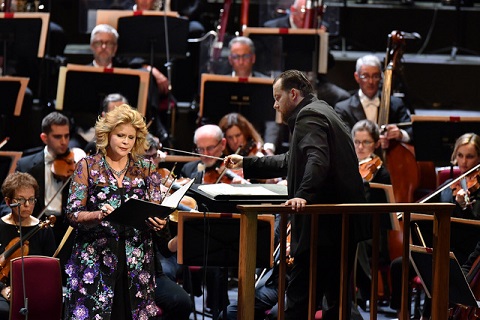 Susan Graham. Photo Credit: BBC/Chris Christodoulou.
Susan Graham. Photo Credit: BBC/Chris Christodoulou.
The fourth movement introduces us to Nietzsche’s ‘Mitternacht’ from Also sprach Zarathustra. Here, the focus of the symphony’s mood changes - and Mahler requires a mezzo voice to do it justice. Nowhere is the music of the symphony darker in temperament than here, and that has much to do with the exceptional detail Mahler brings to the orchestration. If the music rarely rises above piano, the fabric of the music is largely laid out against fifths played on cellos and double-basses. The nine basses of the Boston Symphony have tonal warmth, as well as a sonorous bottom line, and there was much to admire in their playing here. But in many respects, it’s the voice that matters in this section of the symphony and Susan Graham brought a characteristic beauty to what she sang. Nietzsche repeats derivations of the word ‘tief’ - or dark - throughout the text of his setting and it was to Graham’s credit that these were isolated by differences in tonal colour. If there is a somewhat Wagnerian strength to some of her phrasing, the voice sustains a pianissimo with precision and breadth. But this is also a text that drips with meaning and imagery of eternal pain, and Graham was deft at making us aware that this is the language of poetry that mirrors the music Mahler wrote to accompany it. Nelsons was careful here to let his orchestra follow his singer - rather than the other way around, as can so often happen at this point of the symphony. A bassoon was almost a shadow of Graham’s dark voice disappearing into the vacuum of the Albert Hall.
If there had been a careful matching of the voice against the precise ideals of Mahler’s orchestration in the fourth movement, the fifth choral section of the symphony sharply deviated from it. Quite what the motivation was to replace a boys’ choir with one for girls puzzled me, but the tendency of conductors to fiddle with the voices in Mahler’s symphonies for dramatic effect - whether it be the Fourth or Das Lied von der Erde - is hardly new. Either way, the effect here was to remove the distinctive timbre of the two main choruses one usually hears and absorb them into a universal sound. If you felt that the sound of bells did indeed come from somewhere high up in the hall, the children’s voices didn’t, and this was even more so when the two choirs were singing a cappella where there was just insufficient contrast. Without any orchestral accompaniment to hide the sheer urbaneness of the voices, the sense of innocence was all but lost on me. Indeed, it almost made me think that Nietzsche had won after all and Mahler’s idea that this music ascends to heaven had been forgotten.
Any performance of the last movement of Mahler’s Third in the concert hall will, I think, always be hampered by the last concert I heard of this symphony fifteen years ago. That remains one of the most spiritual twenty-five minutes I’ve ever encountered in a concert hall, a moment of true communion between a conductor and his audience. To his credit, Andris Nelsons generated moments that were sublime - some of the accents were written in very dark ink, especially from the solid lower strings of the orchestra, and there was an intensity to some of the phrasing that was indelibly closer to lamentation than had been achieved anywhere else in the performance. The Boston violins soared, and their pain wasn’t at all tempered by anaesthetic. The brass chorales - trumpets ringing out hymns in mighty unison, to be joined by horns - were distinguished and resounding. When the coda finally arrived, it was driven with a ferocity from the timpani that defied Nietzsche and forced open the gates of heaven.
There is unquestionably some music Andris Nelsons conducts well and his Mahler certainly edges towards being distinctive. He’s a beautiful conductor to watch, too; the elegance of his gestures, sometimes using just his hands to shape the music instead of a stick, achieve much. He is never over-wrought in this music, and clearly gets what he wants from his orchestra. This was a performance that didn’t touch greatness, but neither was it one that fell at every hurdle either. And only time will tell whether this reviewer will ever brave Mahler again in the concert hall.
Marc Bridle
Gustav Mahler - Symphony No.3 in D minor
Susan Graham - mezzo-soprano, Andris Nelsons - conductor, CBSO Chorus and CBSO Youth Chorus, Boston Symphony Orchestra
Royal Albert Hall, London - 2nd September, 2018
image=http://www.operatoday.com/BBCPROM67.jpeg image_description=Prom 67: Mahler’s Third Symphony - Boston Symphony Orchestra conducted by Andris Nelsons product=yes product_title=Prom 67: Mahler’s Third Symphony - Boston Symphony Orchestra conducted by Andris Nelsons product_by=A review by Marc Bridle product_id= Above: Boston Symphony Orchestra, CBSO Chorus and CBSO Youth Chorus at the Royal Albert HallPhoto credit: BBC/Chris Christodoulou
September 4, 2018
Bampton Classical Opera Goes to the Ball
American author Gail Carson Levine’s award-winning fantasy-novelElla Enchanted was published in 1997, and as recently as 2015 Walt Disney Pictures revisited the romantic fantasy, producing a live-action re-imagining of the original 1950 animated film. Both a Filipino pop group that rose to prominence in the 1970s, and an American glam rock band formed in Pennsylvania in 1982 and which had a series of multi-platinum albums and hit singles, chose to call themselves after the undervalued skivvy.
According to some sources, there are over 1500 adaptations of the Cinderella story, the earliest version of which is usually considered to be the Greek philosopher Strabo’s account of a Greek slave girl who marries the Egyptian King. Made popular by Charles Perrault in Histoires ou contes du temps passé in 1697 and subsequently by the Brothers Grimm in their ‘darker’ version of the folk tale (in ‘Aschenputtel’, published in the collected Fairy Tales of 1812, the step-sisters are so grotesquely greedy that they are willing to hack bits off their feet to force them into the slipper!), Cinders’ true virtue has earned its just reward in countless pantomimes and plays, ballets and films, musicals and novels.
The earliest known British pantomime based on Cinderella was first performed at the Theatre Royal, Drury Lane in London in 1904, and now Baron Hard-Up, the Ugly Sisters and Buttons are perennial Christmas favourites. In 1957 Rodgers and Hammerstein gave us a television musical with Julie Andrews in the eponymous role. Prokofiev put the glass slipper en pointe, though Tchaikovsky almost got there first, writing to his brother Modest in October 1870, ‘Just imagine, that I've undertaken to write the music for a ballet Cinderella, and that this vast four-act score must be ready by the middle of December!’, though this commission for his first ballet remained unfulfilled. Ferdinand Langer (1878), Johann Strauss II (1901) and Frank Martin (1941) have all taken Cinders to a ballet-ball; and, Christopher Wheeldon, who in 2013 added puppetry (by Basil Twist) to Prokofiev’s score, will choreograph a new production of Cinderella, co-produced by English National Ballet and the Royal Albert Hall where it will be performed in the round in June next year, which is being billed as ‘the ballet spectacular of 2019’.
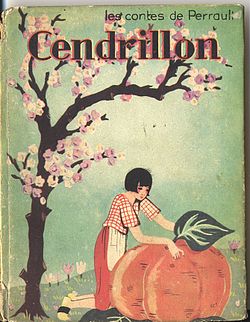 Front cover of a 1930 French picture book edition of Cinderella
Front cover of a 1930 French picture book edition of Cinderella
Cinemas have offered sugary sweet adaptations of the young girl’s journey from misery to matrimony, such as The Slipper and the Rose (starring Richard Chamberlain and Gemma Craven, 1976) and Ever After (1998, featuring Drew Barrymore). And, of course, in the opera house numerous composers have literally given Cinderella a ‘voice’, from Jean-Louis Laruette and Louis Anseaume (1759) to Stefano Pavesi (1814), from Ermanno Wolf-Ferrari (1900) to Gustav Holst (1901), from Peter Maxwell Davies (1979) to Alma Deutscher (2016), among others.
Of course, the operatic versions of Goodness Triumphant by Giacomo Rossini (La Cenerentola, 1817) and Massenet (Cendrillon, 1894-6) are the best-known. But, in the early nineteenth century it was not Rossini whose Cinderella was most celebrated but that of the Franco-Maltese Nicolas - or Nicolò, as he called himself - Isouard, whose three-act comic opera, Cendrillon, to a libretto by Charles-Guillaume Etienne after Charles Perrault, was premiered in the Salle Feydeau at the Opéra-Comique on 22nd February 1810. And, it is this opéra-féerie by Isouard, who died two hundred years ago, that Bampton Classical Opera - celebrating their twenty-fifth year - have selected for their 2018 production and which, following performances earlier this summer at Bampton and Westonbirt, can now be enjoyed at St John’s Smith Square on 18th September .
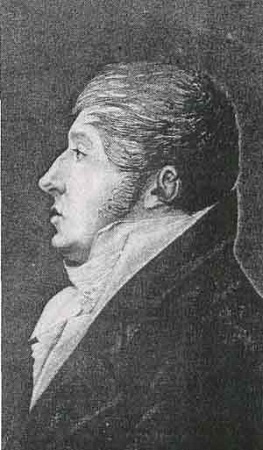 Nicolas Isouard
Nicolas Isouard
So, who was Nicolò Isouard, this composer of more than 40 operas, whose bust graces the pediments of the Palais Garnier in Paris? The son of a Marseille merchant, Isouard was born in Valletta on 18th May 1773 (according to Grove; some sources suggest 6th December 1775). His early education, which included mathematics, Latin and music, took place in Paris at the Pensionnat Berthaud, a preparatory school for the Engineers and Artillery, but the Revolution forced him to flee back to Malta in 1789 where his father found him a position in a merchant’s office. He continued his musical studies - composition with Michel-Ange Vella and counterpoint with Francesco Azzopardi; when his work took him to Palermo, he took harmony lessons with Giuseppe Amendola; later, in Naples, he completed composition studies with Nicola Sala and received practical advice from Guglielmi.
Isouard made his debut as an opera composer with L'avviso ai maritati in June 1794, which was successfully received in Florence and later given in Lisbon, Dresden and Madrid. Back home, not all spoke favourably of Isouard, some questioning his masonic affiliations. In April 1794, the Maltese Inquisition was told that the composer was ‘a young man who leads a sinful life, frequenting loose women, and boasting about it. He ridicules and despises the sacrifice of the Mass [...] those acquainted with him consider him a libertine’, but despite such condemnation, in 1795, on the death of Vincenzo Anfossi, Isouard was appointed organist to the Order of St John of Jerusalem in Valetta, later becoming maestro di cappella there. He settled in Malta, composing serious and comic operas for the Maltese theatre. [1]
The French invasion of the island in June saw him become secretary to the Governor of the French garrison, Vaubois, and following the French submission to the British, Isouard, perhaps fearful of charges of collaboration, returned with the latter to Paris in 1799. His first Parisian opéra comique, Le petit page, composed in collaboration with Rodolphe Kreutzer who acted as Isouard’s manager and patron, was given in the Théâtre Feydeau in February 1800. Friendship with the librettist F.-B. Hoffman led to the sharpening of his dramatic insight, and his first major success came with Michel-Ange (1802).
On 5th August 1802, Isouard co-founded - with Luigi Cherubini, Etienne-Nicolas Méhul, Rodolphe Kreutzer, Adrien Boïeldieu and Pierre Rode - Le magasin de musique dirigé, a publishing venture which formally opened in December that year, in premises at 268 rue de la Loi in Paris (in 1805-6 the street number and name were altered to 76 rue de Richelieu). The company was designed to spare composers - who in the late-eighteenth century habitually self-published their works and sold them personally or through music shops - from financial risk and time-consuming business matters, and to ensure that they received increased publicity and profit. Each of the six composers was contracted to furnish at least one opera or 50 pages of music each year, and each was entitled to the proceeds from the sale of his own works and to a share in the profits of the firm’s publications of works, mainly instrumental compositions, by various non-associated contemporary composers who were popular in Paris at the time.
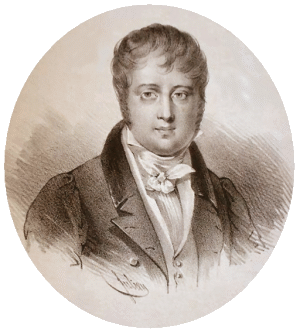 Nicolas Isouard (drawing by Julien, Pierre Durcarme lithography, circa 1830, published by Blaizot, Universal Gallery, Place Vendôme, Paris)
Nicolas Isouard (drawing by Julien, Pierre Durcarme lithography, circa 1830, published by Blaizot, Universal Gallery, Place Vendôme, Paris)
In total more than 650 editions were published, from engraved plates, including Viotti’s five violin concertos and, notably, the first edition in full score of Le nozze di Figaro (1807-08). However, of the six collaborators Isouard - who had the most extensive business experience among the group - was alone in taking his prescribed obligations seriously: the firm printed nine of his operas in full score, alongside Cherubini’sAnacréon, Méhul’s Joseph and Boïeldieu’s Ma tante Aurore. He left the firm in July 1807 and on 12 August 1811 the partnership was dissolved, J.-J. Frey acquiring the business, manuscripts and 9679 engraved plates (of which Isouard’s contribution accounted for 3,553 engraved pages, about 37% of the total). [2]
In 1808, with Un jour à Paris, Isouard began his long collaboration with Etienne, who was the editor of the Journal des deux mondes. Two years later they had an unprecedented success at the Opéra-Comique in 1810 with the fairy-tale operaCendrillon, and further triumphs followed including Jeannot et Colin (1814) and Joconde (1814), the latter establishing Isouard’s international reputation. He had little serious competition among his fellow composers in Paris at this time, but with the return of Boïedlieu, from Russia, in 1811, a friendly rivalry was initiated, one which became more acrimonious when both applied for membership of the Institut de France (1817). Boïeldieu’s success angered Isouard who broke off relations with his former friend. Indeed, it has been suggested that Isouard was driven to drink, debauchery and an early death by his jealousy of Boïeldieu! [3]
Isouard, Boïeldieu and Méhul are often credited with having brought French opéra comique to its final form. The genre is a significant marker of changing taste in France in the early years of the nineteenth century. While the French did share Napoleon’s liking for Italian opera and aristocratic themes, opéra comique came to be strongly identified with the cultural appetites of the post-revolutionary bourgeoisie who, after years of Revolutionary turmoil and bloodshed, now longed for simple entertainments that would amuse and bring joy. Characters were drawn from everyday life; plots involved complicated deceptions and subterfuges; a pair of lovers was unfailingly at the centre of the drama. The story was advanced by spoken dialogue and the music was ‘uncomplicated’: melodious strophic airs and romances, pictorial orchestrations, strongly defined musical characterisation. Though the genre is occasionally dismissed as light and trivial, both Edward J. Dent and Donald Grout argue that it is in the op éra-comique of the years from 1790 to 1815 that we should look for the origins of mid-nineteenth-century Romantic grand opera.
Isouard certainly achieved great popularity at home and abroad during his life-time. His operas were performed across Europe; Michel-Ange was translated into five languages and L’intrigue aux fenêtres into seven. Born in Hanover in 1795, Sophie Augustine Leo, the writer of the anonymous Erinnerungen aus Paris (Berlin, 1851), had travelled to Paris with her elder sister Mme Valentin in 1817, and the year later married the German banker August Leo, a prominent patron of the arts among whose regular guests were many distinguished artists living in Paris at this time. Writing of the ‘masterpieces’ that were being given at the Opéra-Comique during this period, Sophie remarked Isouard’s achievements: ‘His opera Jeannot et Colin, more especially his Rendezvous bourgeois, sparkled with life and animation; I doubt whether a more amusing subject than the latter is to be found. Though I can no longer remember enough of the detail to retell the story, I know that the merriment of the spectators was endless and that the music had caught the spirit of the text. L’intrigue aux fenêtres followed, then Cendrillon and Joconde, and Isouard died, aged forty-one, at the height of his development and in the ever increasing favor of his public.’ [4] She also noted that, ‘In 1818, i.e., shortly after my arrival in Paris, connoisseurs were shocked by the deaths of Isouard and Méhul’.
Frequently composers made adaptations and transcriptions of Isouard opera airs. In 1810 Jan Ladislav Dussek published his “Variations No.4 in G major on ‘Toto Carabo’ or ‘Il étoit un petit homme’ from the opera Cendrillon by Nicolò Isouard arranged as a Rondo with Imitations”, and one of Johann Nepomuk Hummel’s seven sets of variations on opera themes took Cendrillon as its source.
Isoaurd’s fame and favour reached far afield. In his study of opera in Philadelphia from 1800-30, Otto Albrecht demonstrates that Isouard’s work was popular among the 258 different operas presented during in the city during these thirty-one years. In October 1827 no fewer than three operas by Isouard were performed: Cendrillon, ou Le petit soulier verd (first performed on 20th October 1827) was preceded by Joconde, ou Les coureurs d’aventures (1st October) and Les rendez-vous bourgeois (17 th October), while a year later on 18th October 1828 Isouard’s Lully et Quinault, ou Le déjeuner impossible was staged. [5] Further evidence of the dispersal of Isouard’s music in America can be found in Charlotte le Pelletier’s ambitious Journal of Musick, published in Baltimore in 1810. Pellier, a pianist and composer, had arrived in Baltimore from Paris in 1803. A widow with two children, she worked as a tutor and set about a project to sustain her French cultural heritage by publishing a collection of songs and piano pieces that would appeal to other French émigrés for study and performance. The collection included a large proportion of transcriptions from the latest productions at the Opéra-Comique, including arrangements for solo keyboard from the overtures and interludes of Isouard’s Les confidences (1803) and, drawing upon one of the era’s most popular vocal forms, a transcription of the ‘romance’ from Isouard’s first great success, Michel-Ange (1802). [6]
Isouard and his contemporaries were also all the rage on the Russian stage in the early 1800s. Among Isouard’s works that reached Moscow were L'intrigue aux fenêtres (1807), Le médecin litre (1810), and Cendrillon (1811). And, Russian literature did not neglect him: in Alexander Pushkin’s ‘The Blizzard’ from The Tales of the Late Ivan Petrovich Belkin, one of the principal characters, describing his experience in the army during the Napoleonic invasion of Russia, refers to Isouard’s Joconde of 1814: “Meanwhile, the war had ended in glory. Our regiments were returning from abroad. People ran to meet them. For music they played conquered songs: Vive Henri-Quatre, Tyrolean waltzes, and arias from Joconde.” Not everyone was so enamoured of the man and his music, though. Carl Maria von Weber thought that Cendrillon’s ‘sweet airs’ possessed ‘nothing to make an effect on an audience’ and criticised ‘the routine nature of practically every piece’ in the opera and its ‘clumsy instrumentation’. [7]
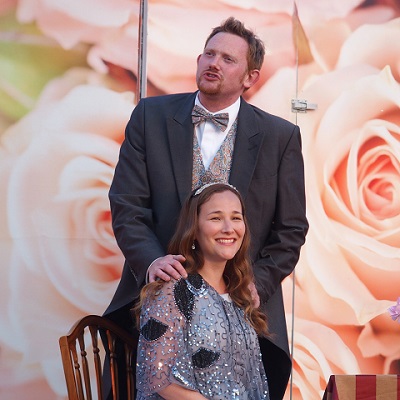 Alidor (Nicholas Merryweather) and Cinderella (Kate Howden), Bampton Classical Opera 2018
Alidor (Nicholas Merryweather) and Cinderella (Kate Howden), Bampton Classical Opera 2018
Some have argued that the artlessness of Cinderella’s musical characterisation - the unadorned melodic line of the simple romances - reflects the influence of the rather limited vocal talents of Alexandrine Saint-Aubin, whose celebrated but brief career was given initial impetus by this role (sung in Bampton’s production by Kate Howden). But, the decorum of Cinderella’s strophic songs complements her inner grace, and Isouard reserves the virtuosity for the two stepsisters, Clorinde and Tisbe (here Aoife O’Sullivan and Jenny Stafford respectively), who, vain, spoiled and self-promoting, pull out all the coloratura stops when seeking to attract the Prince’s attention. Clearly, Isouard had an instinctive sense of how to match melody and context, and, judging by the concerto elements in the opera’s overture as well as interesting use of harp and horn throughout, a good ear for musical colour and pictorialism. There is dramatic interest and depth, too, in the expanded role for Alidoro, the Prince’s sage and tutor (played by Nicholas Merryweather in this production).
When Isouard died, at the age of 44, in Paris on 23rd March 1818, his final opera Aladin, ou La lampe merveilleuse was unfinished. Completed by Benincori, the work was premièred at the Opéra on 6th February 1822, the first opera in Paris to be produced with gas lighting, and to include an ophicleide in the pit orchestra. But, on 25 th January 1817, an opera had been performed at the Teatro Valle in Rome which in the coming years would supplant his own Cendrillon: Rossini’s two-act dramma giocoso, La Cenerentola - the libretto of which acknowledged a debt to Isouard, declaring itself ‘by Jacopo Ferretti after Charles Perrault’s Cendrillon and librettos by Charles-Guillaume Etienne for Nicolas Isouard’s Cendrillon (1810, Paris) and Francesco Fiorini for Stefano Pavesi’s Agatina, o La virtù premiata (1814, Milan)’.
Just as Haydn, Mozart and Beethoven came to dominate instrumental music, so Rossini, Donizetti and Bellini were predominant in the operatic repertory by the 1840s. But despite this, other composers continued to achieve ‘popular’ success throughout the nineteenth century, not least as providers of vocal music to alternate with instrumental works on the concert programmes of the growing number of subscription societies. Though their music is infrequently heard today, the most popular - Giovanni Pergolesi, Giovanni Paisiello, Domenico Cimarosa - remain familiar names. Yet, composers such as Louis Spohr, Giovanni Viotti, Etienne-Nicolas Méhul, George Onslow and Robert Franz are now largely excised from music history, even though in their day their music - alongside that of Nicolas Isouard - was whistled on the streets.
Although the Opéra-Comique revived Les rendez-vous bourgeois and Joconde after World War I, Isouard’s operas have largely languished in obscurity for more than one hundred years, though in 1999 the Australian conductor Richard Bonynge presented Cendrillon in Moscow, a performance that was recorded live. Last year, Manhattan School of Music mounted a production, and in June this year, Cendrillon premiered in Malta itself, in the Manoel Theatre in Valletta (which is the 2018 Cultural Capital of Europe).
Thanks to Bampton Classical Opera, we will have an opportunity to hear in London music that was recalled so fondly by an anonymous writer in the 15 th May 1854 issue of Revue des deux mondes:
‘I was present a few years ago when Cinderella was rehearsing at the Opéra-Comique, and I was delighted, I will admit, by the charming nature of this so naively romantic inspiration. Nicolò produced an effect on me that Rossini’s music in all its pomp had not been able to produce. I seemed to hear a real fairy tale in music, and I found in these slightly shortened phrases, an expression so simple and so touching, [an] air of childish grace and good-naturedness …’
Claire Seymour
[1] Expelled from Rhodes by the Turks in 1523, the Sovereign Military Order of Malta proved itself a notable musical patron, transforming Maltese cultural life by introducing European customs and taste. The Order’s musical establishment in its church in Valetta employed musicians of considerable talent and a number of distinguished musicians were associated with the Order. See Duane Galles, ‘Chivalric Orders as Musical Patrons’, Sacred Music, Fall 2012, Vol.139, No.3: 25-44.
[2] Bruce R. Schueneman and María De Jesús Ayala-Schueneman, ‘The Composers’ House: Le Magasin De Musique De Cherubini, Méhul, R. Kreutzer, Rode, Nicolo Isouard, Et Boïeldieu’, Fontes Artis Musicae, Vol.51, No 1, 2004: 53-73.
[3] Geoffrey Álvarez, ‘The singing island’, Musical Times, Vol.157, Iss.1937, (Winter 2016): 114-117.
[4] In ‘Musical Life in Paris (1817-1848): A Chapter from the Memoirs of Sophie Augustine Leo-Part I’, The Musical Quarterly, Vol.17, No.2 (Apr., 1931): 259-271
[5] Otto E. Albrecht, ‘Opera in Philadelphia, 1800-1830’, Journal of the American Musicological Society, Vol.32, No.3 (Autumn, 1979): 499-515.
[6] Elise K. Kirk, ‘Charlotte Le Pelletier’s Journal of Musick (1810): A New Look at French Culture in Early America’, American Music, Vol.29, No.2 (Summer 2011): 203-228.
[7] J. Warrack, ed.: Carl Maria von Weber: Writings on Music (Cambridge, 1981).
September 3, 2018
A Landmark Revival of Sullivan's Haddon Hall
Grand Opera was not Sullivan's natural medium though, and he turned next to "Light Opera" with Haddon Hall (1892), the work which inaugurated the final phase of his operatic career. Here, finally, he found his true level and produced, arguably (and many will argue!) one of his finest scores.
"Light Opera" is a term not much used nowadays, which is a shame, for it succinctly expresses the style and ambition of a work like Haddon Hall. It aims to be easily enjoyable, tuneful, operatic entertainment, generally with a happy ending, but at the same time seeks to treat emotional situations with a level of seriousness generally eschewed in operetta. The danger, always, is that it falls between two sets of audience expectations: for Wagnerians and Verdians it is too trivial to be part of operatic history at all, while for lovers of operetta, musical comedy, and the modern musical, it aims too high, in one way or another. Perhaps part of the problem is that there is no clear tradition or canon to which to appeal. Yet Cimarosa's Il matrimonio segreto (The Secret Marriage), exactly a century older than Haddon Hall, might be considered a perfect example of the genre, and the fact that critics have lined up for two centuries to declare it "not Mozart" succinctly sums up the sort of downward comparisons with which Light Opera has always had to contend.
But Haddon Hall does not suffer only from this sort of pigeonholing. It is disadvantaged by a rather problematic libretto by Sydney Grundy (1848-1914), who had previously collaborated with Sullivan's 1880s rival, Edward Solomon. Grundy based the opera on the legend that Dorothy Vernon, daughter of Sir George Vernon, the owner of Haddon Hall in Derbyshire, eloped with her lover, John Manners, in 1563. (For David Trutt's superb study of the sources Grundy had for this, see https://www.gsarchive.net/trutt/HaddonHallBooks/DorothyVernon.pdf .) This was not enough for a two-hour opera, of course, so Grundy expanded it with a plotline which could have been inspired by Jane Austen's Pride and Prejudice: Sir George's family will lose Haddon Hall to an odious cousin, a sanctimonious humbug, unless this odious cousin can be persuaded to marry a daughter of the house - Dorothy (unlike in Austen) being the only option. So far so good, but then Grundy made a very questionable decision to add Historical Significance to the story by moving it forward to the period of the English Civil War and making Manners a dashing royalist and odious cousin Rupert a Puritan. There is none of the fine aspectual balance Bellini and his librettist, Carlo Pepoli, brought to I puritani (1835), or that can be found even in Michael William Balfe's The Puritan's Daughter (1861). Haddon Hall simply proposes that the Puritans were comically absurd and hypocritical and that idea, once introduced, rather takes over the opera. This is a shame, because there are suggestions, at times, that something deeper is trying to emerge about continuity and tradition in English history, as in the opening chorus: "Ye stately homes of England, / Long may your towers stand; / Types of the life of man and wife, / Types of our English land!"
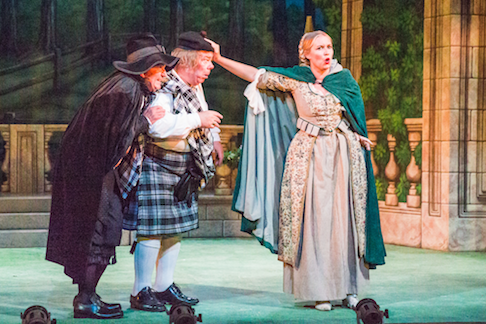 Richard Suart as Rupert Vernon, Bruce Graham as The McCrankie, and Bee Bradley as Dorcas
Richard Suart as Rupert Vernon, Bruce Graham as The McCrankie, and Bee Bradley as Dorcas
The heavy emphasis on Puritan hypocrisy leaves surprisingly little stage time for Manners, the ostensible hero of the story. In the first two acts he appears for a total of barely fifteen minutes, and there is a theory that Sullivan actually wanted to cut him from the first act entirely (a theory marmorealized in the 2000 Prince Consort recording). In terms of realism and dramatic impact this actually works rather well: a man planning an elopement is likely to keep a low profile. On the other hand, though, Manners is inevitably a rather two-dimensional character, and from the musical point of view we want more from him. Preparing the work for an amateur revival at King Edward VI School, Retford, in 1992, to mark the centenary, Martin Yates and David Eden were sufficiently impressed by these weaknesses to attempt a partial rewrite. The biggest change in their version is that, in Act 1, it is Manners himself, not his servant Oswald, who disguises himself as a pedlar so as to safely approach Haddon Hall. One can readily appreciate the sense of this, for it blurs the line between the romantic elopement plot and the surrounding comic business; in Grundy's original these seem quite distinct, even to the point of representing different levels of reality. But blurring the line in this way pulls the whole opera more firmly in the direction of comedy which runs, I think, counter to what Sullivan wanted to achieve in Haddon Hall. The Yates/Eden revisions do not all pull in this direction, though. They locate the story more firmly in the 1650s, and even date the action, putting the first two acts in 1652 and the third in 1660, the year of the Restoration. This astonishingly long interval makes the elopement seem more significant than it otherwise would, suggesting that, rather like Leontes in Shakespeare's Winter's Tale, Sir George must thoroughly repent his conduct before his family can be happily reconciled.
First brought out at the Buxton Opera House on 2 August, then at the 25th International Gilbert and Sullivan Festival in Harrogate on 17 August, the National Gilbert and Sullivan Opera Company production of Haddon Hall was billed, remarkably, as the first professional production since 1899. Merely by existing, then, it becomes a production of some historical importance. It uses the Yates/Eden rewrite. As a primary goal was obviously to make the opera commercially viable, to have it performed by G&S veterans, and to appeal to the established G&S audience, this was an understandable decision, and one very much vindicated by the result, which was a delight from first to last. Sarah Helsby Hughes, the director, made intelligent use of a single set for all three acts (a walk immediately outside Haddon Hall), and the cast, in their loosely period costumes, exuded a sense that they too were having tremendous fun with the material, which they carried off with great panache. There was, admittedly, a certain amount of what Charles Lamb called "sub-referencing," that is to say a sort of winking at the audience, which again I suspect was not quite the style of performance Sullivan wanted, but I readily accept that G&S veterans would have serious difficulties playing such a text straight.
G&S people often like to say the score of Haddon Hall is "uneven," which sometimes seems to be a sort of critical shorthand for "not as good as The Mikado." But I'm reminded of William Wordsworth's complaint about those critics who look for "prosaisms" in poetry and "imagine that they have made a notable discovery, and exult over the Poet as over a man ignorant of his own profession." Wordsworth's point was that any good poet, writing a longer poem, will not aim at a uniform level of poetic "elevation." Sullivan must have sensed the danger that Puritanical comedy could take over the opera, and it is likely he remembered, with some embarrassment, that "Ho, jolly Jenkin" had proved the most popular number in Ivanhoe. Thus, it seems to me, he aimed to construct a score in which the most memorable and lyrical music is linked to the "elevated" emotions engendered by the elopement plot, while more "prosaic" music, to use Wordsworth's term, serves for the comic digressions. This, then, is unevenness with a purpose and point, guiding the audience's responses, operating within a score unified by an attractive tinta designed to evoke Old England.
In this respect, the new production almost got things just right. The central character, Dorothy, who gets the most difficult music, was beautifully brought to life by the radiant soprano of Rachel Harland. She was able to convey the serious emotions lying at the centre of the story, and gave it the sort of human heartedness Sullivan would undoubtedly have wanted. The other female leads were also very well cast: Katherine Marriott as Lady Vernon, the sympathetic, longsuffering mother, and Bee Bradley as a delightfully vivacious Dorcas, Dorothy's supportive maidservant who herself finds love in the course of the opera.
With the men, things were only slightly less satisfactory. Donald Maxwell was excellent as Sir George, giving a slightly sardonic edge to the character that was perfectly appropriate for a man trying to cut his losses after the Parliamentary victory. Bruce Graham was also excellent as The McCrankie, an unnecessary comic character Grundy worked into his libretto, who represents the acme of Puritanical hypocrisy. Cousin Rupert is the most challenging acting role in the opera, and Richard Suart made a good stab at it, but he played a bit too much to the audience, and his comic interactions with The McCrankie were made to seem more consequential than his usurpation of the Vernon estate (though Grundy must take a good share of the blame for the imbalance). Nicholas Sales as Manners was tripped up by the Yates/Eden rewrite. He was superb in his initial apparition as "Jack the pedlar," but it was consequently difficult to shrug off that image of him as a lively young imposter enjoying himself a bit too much. David Menezes as Manners' servant Oswald lost his big opening number as a result of the revision, but during that number was seen at the back of the stage renewing his relationship with Dorcas (the relationship does not originate in the course of the action, another change). It was difficult, both then and later, to think of him as any sort of servant, but he was very good as an ardent lover with mischief in his eyes.
Altogether, this was a highly commendable attempt to revive an unjustly neglected opera containing some of Sullivan's loveliest music, and it was a privilege to witness it. Further good news for Haddon Hall lovers is that the Sir Arthur Sullivan Society is planning the first ever professional recording of the work. Perhaps its time has finally come.
David Chandler
image=http://www.operatoday.com/haddon_hall_007.png image_description=Rachel Harland as Dorothy Vernon [Photo courtesy of The Gilbert & Sullivan Festival] product=yes product_title=A Landmark Revival of Sullivan's Haddon Hall product_by=A review by David Chandler product_id=Above: Rachel Harland as Dorothy VernonPhotos courtesy of The Gilbert & Sullivan Festival
Die Meistersinger at Bayreuth
Though Wagner’s comedy is only comedy in so much as it is the triumph of youth over age unless maybe you find the caricature of the Nürnburg town clerk Beckmesser to be amusing, or maybe you find it a bit amusing that a pretty young German girl is courted by three men, a young man and and old one and a Jew. Fortunately, like all comedy, the situation gets properly resolved — in Bayreuth youth is poised to renew an already perfect world.
Director Barrie Kosky does however take the comedy idea very seriously and creates Meistersinger’s entire first act as schtick. It takes place in Wagner’s Bayreuth home, confusing Wagner with Hans Sachs, Cosima Wagner with Eva, Franz Liszt (Cosima’s father) with Eva’s father Pogner. Wagner and Liszt play a mock piano duet, and later nine medievally dressed men climb out of the piano (how many clowns fit into a VW?). And these gimmicks are just for starters in this deft transposition of St. Catherine’s church into Wagner’s salon.
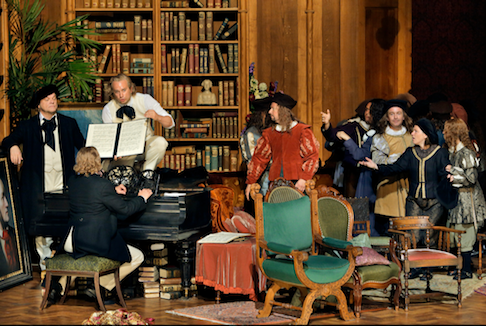 Volle as Wagner, Günther Groissböck as Liszt, Klaus Florian Voght as Walter with the mastersingers
Volle as Wagner, Günther Groissböck as Liszt, Klaus Florian Voght as Walter with the mastersingers
At the act’s conclusion the Wagner residence dissolves into the apparition of a large, secular, quite empty room (hall), the signal that the fun is over. Thus we have our first suspicion that not only will the first act Wagners-at-home-sitcom become a play superimposed upon a play, but that there will be and even bigger, totally public drama. From hints in the sitcom (Cosima’s Jewish lover, conductor Hermann Levi AKA Beckmesser is humiliated) of course we know what the drama is about.
The Barrie Kosky second act is anti-comedic in that we have no context in which to place the complex Wagner/Hans Sachs story. The Wagner household furniture is piled up on a dark stage and we see little else. The Nürnberg intrigues begin, and things get messed up to the degree that there is a storm (as in Rossini’s Barber) though it is not a bit comedic (funnily enough a clock does run backward). Wagner’s storm is completely musical, an outburst of 56 independent voices! Director Kosky renders the midsummer night riot as a pogram, and indeed for Wagner this ethnic hysteria is not a farfetched musical scenario.
The third act is back to schtick. Director Kosky brings the private and public situations to trial, and we do have a quite specific and certainly witty comedic context — sessions of the Nurnberg Trials. There are personal testimonies that resolve into the Rossini moment when absolutely everything stops, the startled principals are absolutely stunned — thus the glorious private celebration that is Wagner’s sublime quintet.
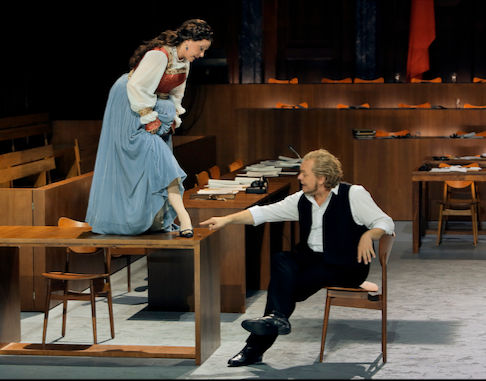 Emily Magee as Eva, Michael Volle as Hans Sachs
Emily Magee as Eva, Michael Volle as Hans Sachs
And then there are public testimonies that are distantly reminiscent of the music lesson in Rossini’s Barber. Beckmesser is ruthlessly ridiculed.
Finally it becomes the public resolution that we have been waiting for, everything becomes what it must be. And that is a celebration of a music that will endure within director Barrie Kosky’s world, and in our world, no matter what its content may be. A full symphony orchestra magically slips onto the stage. It is Nurnberg’s beloved Hans Sachs or more precisely it is Wagner himself who conducts the opera’s monumental farewell, its magnificent hymn to German art.
Keep in mind that the on-stage symphony orchestra is in addition to the ninety or so players in the Festspielhaus’ invisible pit — an additional reminder that German art as practiced in Bayreuth is indeed magnificent,
For all its comic magnificence this Bayreuth Die Meistersinger was a subdued affair. Conductor Philippe Jordan’s persuasive orchestral well upheld the glories of the Festspielhaus’ famed acoustic but his reading of the mighty score did not command attention. The great moments were musically flaccid (for example the Act II riot, and in fact the Quintet), possibly rendered such by Mr. Kosky’s shocking staging that often dramatically overpowered or sometimes simply flattened these moments. The musical effect was further dampened by the miscast Eva (British soprano Emily Magee) who brought no vocal or dramatic focus to her pivotal scenes within the larger Kosky dramas (and possibly as well by the controversially light voiced Walter).
With this one Anglo-Saxon exception the balance of the cast was German or Austrian and deeply satisfying. The Hans Sachs of Michael Volle is well known, and shown to perfection in this complicated production, as did the Beckmesser of Johannes Martin Kränzle (who took the second to last bow!). Tenor Klaus Florian Voght is an exceptionally light lyric dramatic tenor (jugendlicher heldontenor), an ethereally voiced singer who is evidently appreciated on some Wagnerian stages as Mr. Voght is legacy casting from the 2017 Bayreuth Meistersinger). His thin, boyish, pure-toned voice did not create a convincing vocal Stolzing presence, though he well upheld Mr. Kosky’s character needs. Günther Groissböck well fulfilled his role as Cosima’s bewigged father Lizst and was exceptionally sympathetic as Eva’s father. Tenor Daniel Behle held powerful sway as Sach’s apprentice David, as did Wiebke Lehmkuhl as Eva’s maid Magdalene, both artists assuming more musical presence in Wagner’s thick score than the Eva or Walter.
For the record, the trepidations one may harbor about the storied lack of comfort of the Bayreuth Festspielhaus may be put to rest. The benches are padded, there are backs and you are not crowded. Normally the thrill of simply being in this august temple of Teutonic art will overcome all climatic discomfort (it can be warm). The one-hour intermissions are appreciated because normally after a Bayreuth act you have a lot to chew on before taking on more. Refreshment is, contextually, reasonably priced.
Michael Milenski
Additional production information:
Chorus and Orchestra of the Bayreuth Festival. Sets: Rebecca Ringst; Costumes: Klaus Bruns; Lighting: Franck Evin; Dramaturgy: Ulrich Lenz. Festspielhaus, Bayreuther Festspiele, Bayreuth, August 12, 2018.
image=http://www.operatoday.com/Bayreuth1.png
image_description=
product=yes
product_title=Die Meistersinger at the Bayreuth Festival
product_by=A review by Michael Milenski
product_id=Above: Michael Volle as Hans Sachs AKA Richard Wagner [All photos copyright Bayreuther Festspiele / Enrico Nawrath]
September 2, 2018
The BBC Proms visit Ally Pally
Just under two years earlier, on Saturday 24th May 1973, the Alexandra Palace and Park had opened, five years late and over-budget ( plus ça change). This ‘North London Palace of the People’, located on the site of a former 450-acre dairy farm which in 1856 had been inherited by the non-agriculturally minded grandchildren of one Thomas Rhodes, comprised a building spanning seven acres surrounded by 200 acres of landscaped gardens. Built by Royal assent, the Palace was designed to further the Victorians’ ethical endeavour to cultivate a ‘higher civilisation’ - promotional advertisements promised “Healthy exercise, rational recreation” - in which fresh air and music played an equal part. [1]
The eastern transept comprised a concert room that could seat 3,000 people, while the Great Central Hall could accommodate 12,000 people and a 2,000-piece orchestra. The huge site afforded the opportunity for varied music-making, including al fresco performances on the banks of the Triple Lakes. (If you’re wondering when my ‘review’ will start, I’d ask you to bear with me, there is a point to the preamble …)
Not all have been impressed. Nikolaus Pevsner (in The Buildings of England, 1951) described the Ally Pally, as it affectionately came to be known, as ‘one of the most extensive and most prominently placed of London buildings’, but dismissively quipped that ‘there is not much else to be said about it’. And, from the start, financial over-optimism or mismanagement, what you will, threw a shadow over the Palace’s future. In the six months from November 1875, the venue ran up a £23,000 deficit and economic dire straits becoming a recurring trope, continuing as late as the 1980s when the then trustees, Haringey Council, over-spent on a refurbishment and ice-rink. Fire also repeatedly threatened to curtail the project, with the building going up in flames just 16 days after the opening and again in 1980.
Over the years, the Palace has served as a hospital for Belgian refugees, an internment camp for German and Austrian civilians from 1915-19, and as a horse racing course, among other guises. In 1935, the BBC took on the lease of part of the Palace, setting up studios is some derelict Victorian dining rooms, and on 2nd November 1936 the first television broadcast took place from the Ally Pally. Transmission was disrupted by WW2, when its transmitter was used to jam German bombers’ navigation systems, and in 1947 by a fuel crisis, but Ally Pally studios remained the BBC’s main transmitting centre for London until 1956.
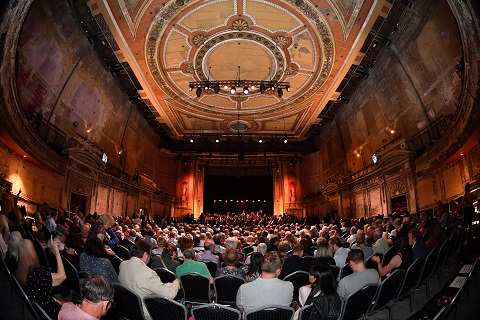 BBC Proms at … Alexandra Palace. Photo Credit: BBC/Chris Christodoulou.
BBC Proms at … Alexandra Palace. Photo Credit: BBC/Chris Christodoulou.
It seems serendipitous therefore that Alfred Meeson, who, with his co-architect John Johnson, designed the Palace, had also built the Royal Albert Hall - the home of the Promenade concerts since the summer of 1941. For, this year, the BBC has chosen the Ally Pally for one of their ‘out-and-about’ Proms, in anticipation of the official reopening of the Palace’s Theatre to the public on 1st December 2018 - restored with the help of an £18.8m lottery grant, and part of a £27m restoration of Ally Pally’s east wing.
So, what better choice to grace this Victorian stage than Gilbert & Sullivan, censurers and celebrators of Victorian frailties and foibles in equal measure. Staged with slickness and style by director Jack Furness and conducted with gleeful joie de vivre by Jane Glover, Trial by Jury returned to what BBC presenter Petroc Trelawny described as the wonderfully preserved dilapidation of the Palace’s Theatre, and provided forty minutes of slight but so less satisfying pleasure.
Originally composed and rehearsed in just a few weeks, and essentially a single act of trifling tomfoolery, Trial by Jury presents an unpretentious lampooning of Gilbert’s favourite target - the English judiciary. There is no elaborate artifice in plot, lyrics or music, and no spoken dialogue: just some direct expression and gentle musical parody of Bellini and Handel. The characters, individual and choric, are one-dimensional but the message is simple and clear. Angelina (Mary Bevan) is suing Edwin (Sam Furness) for breach of promise; everyone in the court, barring the defendant, is a hypocrite with their eye not on love but money, and hankering after economic advantage.
Keel Watson ushered the BBC Singers into the courtroom with stentorian, punctilious and supercilious concern for the decorum and propriety of judicial process, and the male and female chorus members ranked themselves stage right and left, displaying a wry appreciation of G&S manners and mannerisms - though Jack Furness, in his attention to detail, sometimes overlooked practicalities: it’s impossible to kneel and raise one’s hand in solemn oath, and turn the pages of one’s score.
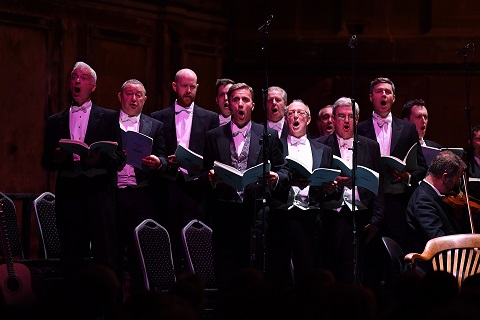 BBC Singers. Photo Credit: BBC/Chris Christodoulou.
BBC Singers. Photo Credit: BBC/Chris Christodoulou.
Sam Furness was the epitome of masculine artlessness and unconcern, frankly admitting, as he lounged easily in the ‘dock’ and drew nonchalantly on a cigarette, that he had dumped Angelina, but that was because he was tired of her. Que faire? Edwin seemed positively guiltless judged against the avaricious scheming of Bevan’s Angelina. She is “no unhappy maid” as she reminded the solicitous chorus and her faux histrionic appeals for compensation, “I love him, I love him!”, and hyperactive hyperventilating had their desired effect on Neal Davies’ equally unprincipled Judge, who vowed to ditch his ugly wife - married for her father’s wealth - and, having fined Edwin, take the newly enriched Angelina for himself. Ross Ramgobin, as Angelina’s Counsel, rivalled his client for thespian extravagance, as he urged the jury to consider the misery inflicted not by Angelina’s loss of a husband but by her financial forfeiture.
The goofery gushed along but, given that Gilbert’s lyrics are the ‘simplest’ - in diction and form - that he ever wrote for Sullivan, it’s a pity that we didn’t hear more of them. The acoustic in the Theatre is good but the patter largely defeated the cast.
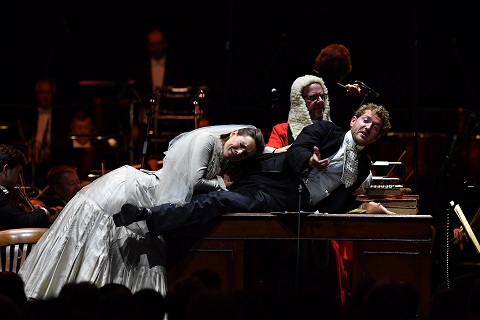 Mary Bevan (Angelina), Neal Davies (The Learned Judge), Sam Furness (Edwin). Photo Credit: BBC/Chris Christodoulou.
Mary Bevan (Angelina), Neal Davies (The Learned Judge), Sam Furness (Edwin). Photo Credit: BBC/Chris Christodoulou.
The first part of the Prom was devoted to overtures and songs that would have found favour with the Palace’s first Victorian audiences. Glover coaxed some vivacious playing from the BBC Concert Orchestra: woodwind sparkled at the start of Sullivan’s Overture to Act 4 of The Tempest (1961-62), and here and in the Overture to Ethel Smyth’s The Boatswain’s Mate (1913-14, rev. 1921) there was plentiful melodrama and colour. Three movements from Parry’s incidental music to The Birds (1883) proved less engaging, though there was some delicate clarinet and horn playing to admire in the Intermezzo.
Bevan sang Alfred Cellier’s ‘All alone to my eerie … Whispering breeze’ with unaffected directness and sweetness, caressing the phrases gently, and she was beautifully complemented and balanced by some sensitive string playing. The soprano was joined by Sam Furness for a beguiling rendition of Stanford’s ‘So it’s kisses you’re craving’, which balanced musical charm with dramatic causticity. Neal Davies was no more successful in the Lord Chancellor’s party piece from Iolanthe, ‘When I Went to the Bar’, than he was in the Learned Judge’s subsequent and similarly named, ‘When I, good friends, was called to the bar’. At least in the latter a context had been established for the Judge’s conceited and corrupt self-praise, but the Iolanthe number came and went in a blink of an eye, so swift was the tempo set by Glover. Though, after Davies’ first two garbed lines, she tried to put on the brakes, the damage was done, and it didn’t help that Davies’ eyes were rather glued to his word-sheet.
The best vocal item was Furness’s ardent rendition of Samuel Coleridge-Taylor’s ‘Onaway! Awake Beloved!’, in which warm horns and strings established a restful bed of sound from which Furness could assail the melodic peaks with assurance and strength. Here we could hear every word, and the earnestness of the sentiments was touching rather than cloying.
By the end of the nineteenth century, the Ally Pally was both a white elephant and economic millstone. But, it did and does represent a powerfully persuasive emblem of Victorian aspiration and culture. The success of Trial by Jury encouraged Gilbert, Sullivan and Richard D’Oyly Carte to form, in 1876, the company which would present the collaborations of the Victorian age’s most celebrated comic writer and composer. At the start of the twentieth-first century, the majestic exterior of the Palace, the tastefully distressed interior of the Theatre the spacious majesty of the glass-domed East Court which forms an impressively capacious ante-room still cast a spell. Let’s hope that the magic results in both uplifting entertainment and economic success in the years to come.
Claire Seymour
Proms at … Alexandra Palace: Neal Davies (The Learned Judge), Mary Bevan (The Plantiff), Sam Furness (The Defendant), Ross Ramgoblin (Counsel for the Plaintiff), Keel Watson (Usher); Jack Furness (stage director), Jane Glover (conductor), BBC Concert Orchestra, BBC Singers.
Samuel Coleridge-Taylor - ‘Onaway, Awake Beloved’ (from Hiawatha’s Wedding Feast); Alfred Cellier - ‘All Alone to My Eerie … Whispering Breeze’ (from The Mountebanks); Dame Ethel Smyth - The Boatswains Mate, ‘Overture’; Arthur Sullivan - ‘When I went to the Bar’ (from Iolanthe); Charles Villiers Stanford - ‘So it’s kisses you’re craving’; Hubert Parry - The Birds, Suite (Introduction, Intermezzo, Bridal March), Prelude to Act IV of The Tempest; Arthur Sullivan - Trial by Jury.
Alexandra Palace, London; Saturday 1st September 2018.
[1] See Paul Watt, Alison Rabinovici, ‘Alexandra Palace: Music, Leisure, and the Cultivation of “Higher Civilization” in the Late Nineteenth Century’, Music and Letters, Volume 95, Issue 2, 1 May 2014: 183-212, for a detailed account of the origins, development and history of the Palace.
Photo credit: BBC/Chris Christodoulou